

The euro area economy was struck by the extraordinary and severe coronavirus (COVID-19) pandemic shock in 2020. Economic activity contracted sharply during the first half of the year as a consequence of lockdown measures and heightened risk aversion. The strong and coordinated monetary and fiscal policy reaction, combined with positive news on vaccines, helped stabilise activity in the second half of the year. Overall, euro area GDP contracted by 6.6% in 2020. Annual headline inflation declined to 0.3%, from 1.2% in 2019, in large part as a result of falling energy prices, although there were also factors relating to the pandemic. For example, sectors that were hardest hit by the crisis, such as transport and hotels, contributed to the fall in inflation during the second half of the year.
The ECB substantially eased its monetary policy stance to counter the negative impact of the pandemic on the euro area economy, through a comprehensive set of measures that were recalibrated in the course of the year. This included: introducing a new, temporary, pandemic emergency purchase programme; relaxing eligibility and collateral criteria; and offering new longer-term refinancing operations. The monetary policy response was a crucial stabilising force for markets and helped to counter the serious risks posed by the pandemic to the monetary policy transmission mechanism, the outlook for the euro area economy and, ultimately, the ECB’s price stability objective. In addition, macroprudential policies focused on maintaining the flow of credit to the economy, while ECB Banking Supervision introduced microprudential measures to moderate the impact of the crisis and promote the resilience of the European banking sector.
In January, the Governing Council launched a review of the ECB’s monetary policy strategy, to ensure it remains fit for purpose. The review aims to thoroughly analyse the implications of the profound changes that have occurred since the previous review in 2003. These include the persistent decline in inflation and equilibrium interest rates, and the impacts of globalisation, digitalisation and climate change. The review will consider whether and how the ECB should adjust its monetary policy strategy in response, and is expected to be concluded in the second half of 2021.
The ECB is exploring all possible ways within its mandate in which it could contribute to limiting the potentially substantial economic and social consequences of climate change. This includes careful analysis across relevant policy areas, investing the ECB’s pension fund and own funds portfolios in a sustainable and responsible fashion and focusing on the carbon footprint of the ECB itself. The ECB has recently created a climate change centre in order to shape and steer its climate agenda.
The Eurosystem has developed a comprehensive retail payments strategy to harness the innovative potential of digitalisation, focusing on enabling instant payments, developing a pan-European payment solution and investigating the possibility of a digital euro. A public consultation on a digital euro was launched in October 2020 to ensure that any new form of money and payments the Eurosystem may provide would retain the public’s trust.
The ECB enhanced its communication and outreach in 2020 to meet the challenges posed by the pandemic and to better understand the economic concerns and imperatives of European citizens. It also introduced the ECB Blog. 19 posts were published in 2020, with many focusing on the ECB’s response to the crisis. The first ECB Listens event took place in October 2020, and the ECB Listens Portal received almost 4,000 comments on the monetary policy strategy.
2020 was a year of intense and urgent activity, which was conducted in close cooperation with European institutions but also with other central banks across the world to confront the immense exogenous shock faced by the global economy. The ECB played its part.
Frankfurt am Main, April 2021
Christine Lagarde
President
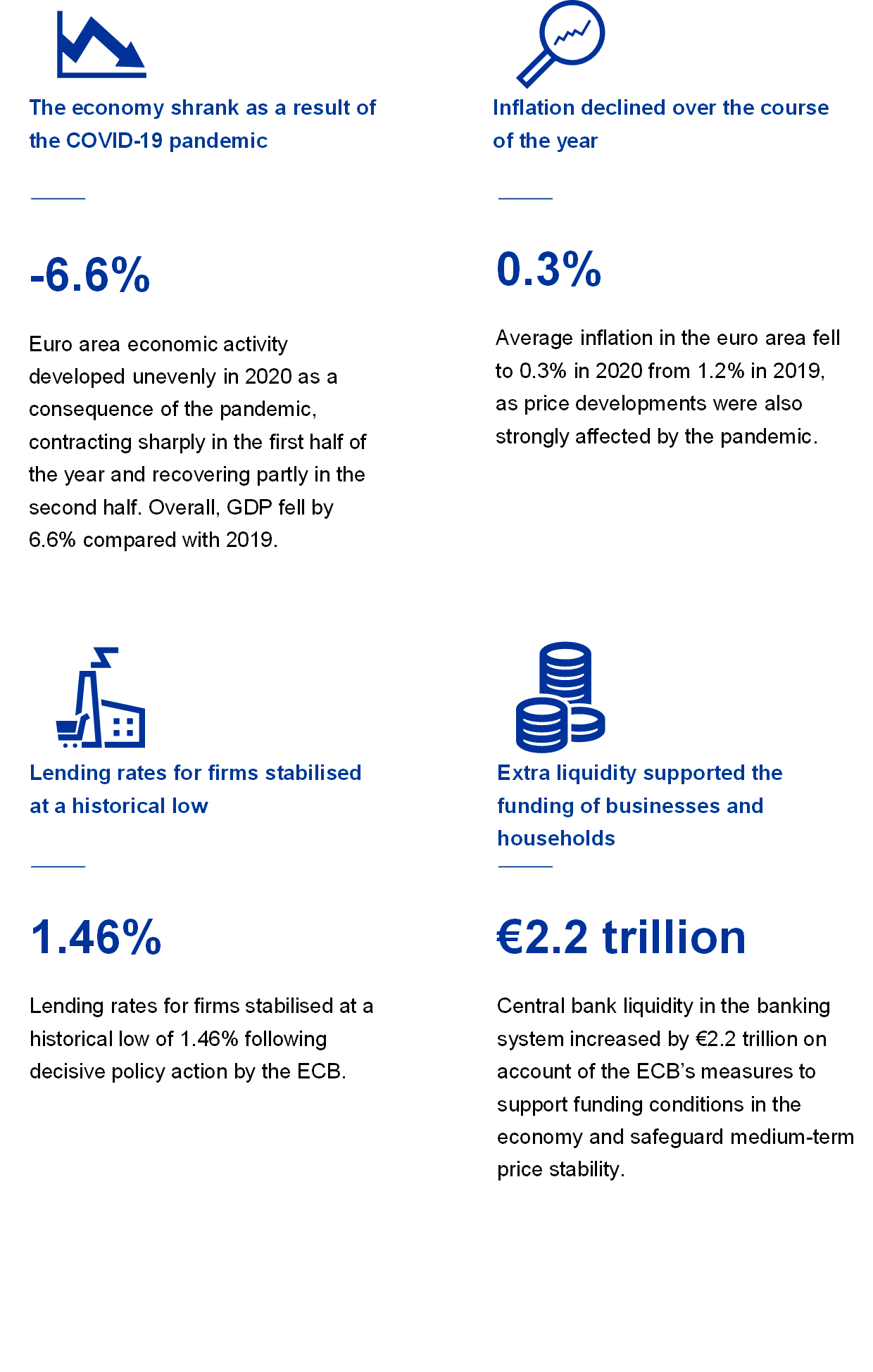
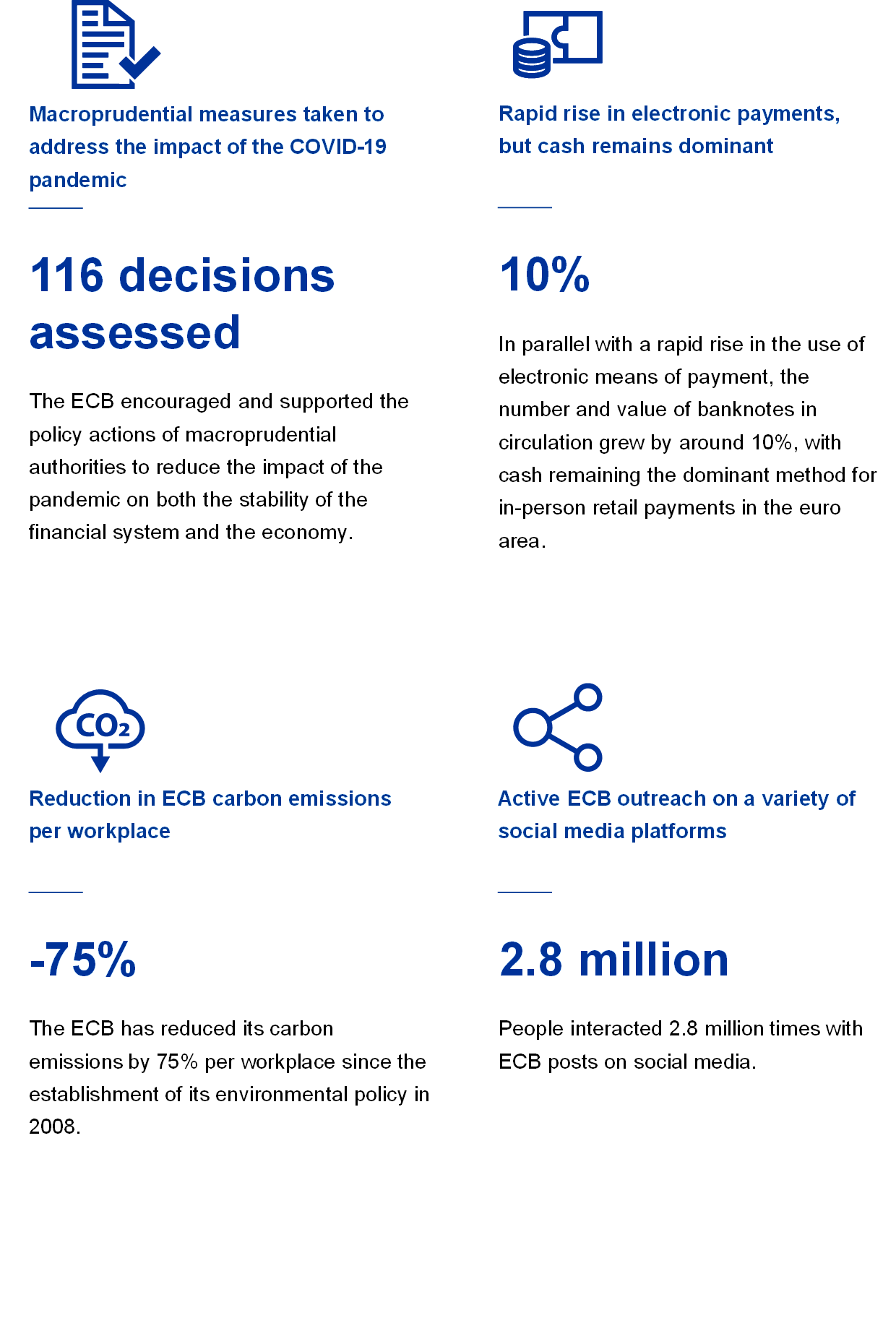
In 2020 the global economy underwent a deep recession amid unprecedented challenges. The COVID-19 shock was, however, of a more exogenous nature than the factors behind the previous crises in 2008 and 2011-12. While in previous crisis episodes specific problems in the financial sector had taken centre stage, the recession in 2020 had its root cause outside the economy. The spread of COVID-19 had a very severe impact on economic activity, initially in China and later at the global level. International trade contracted sharply, the functioning of global value chains was severely impaired and uncertainty in global financial markets soared.
The euro area economy also suffered the intense impact of the pandemic. The impact could be seen, for instance, in consumption, which contracted sharply in the first half of the year as a consequence of widespread lockdown measures and heightened risk aversion. Activity, especially in the services sector, also weakened markedly in view of a lack of demand and restrictions on activity. As a result, real GDP contracted at exceptionally fast rates in the second quarter of the year. At the same time, monetary and fiscal policymakers acted promptly and with determination to address the collapse in demand and the high levels of uncertainty, inter alia ensuring favourable and stable financing conditions and continued access to liquidity. From the onset of the COVID-19 crisis, expectations about the depth and duration of the recession were greatly affected by the prospects for medical solutions, especially a vaccine. Together with strong and coordinated policy action, positive news in the late autumn relating to progress in vaccine development led to a gradual rebuilding of confidence. While growth developments remained volatile in the second half of the year when a renewed wave of contagion hit, growth expectations firmed and stabilised. Price developments were also strongly affected by the pandemic. As a result of faltering demand, lower oil prices and weakened activity, HICP inflation declined over the course of the year and hovered in negative territory from August onwards. Other factors, such as the temporary reduction in the German VAT rate in the second half of the year, also pushed inflation down. At the same time, the expectation of a solid recovery in 2021 and a reversal of temporary factors such as the German VAT rate reduction underpinned the prospect of a pick-up in inflation. Decisive policy action kept credit and financing conditions supportive and largely offset the tightening impact on banks’ credit standards stemming from the deterioration in the risk environment. Although the market dislocation induced by the pandemic shock led to a sharp tightening of financial conditions in March, swift policy action contributed to an overall decline of euro area government bond yields in 2020 and to the gradual recovery of euro area equity prices in the second half of the year from their pandemic lows. The period of high uncertainty also led to an acceleration in money and credit growth, reflecting a strong preference for and the build-up of liquidity by firms and households.
1.1 The pandemic caused a deep economic slump
The coronavirus caused the largest contraction in the global economy since the Great Depression, but positive vaccine news led to a gradual rebuilding of confidence
The development of the COVID-19 pandemic, along with the accompanying virus containment measures and policy support to cushion the economic impact of the pandemic, were the key determinants of the growth trend at the global level. The global economy was hit by a sharp external shock and overall governments responded with strong policy support to cushion the pandemic’s economic impact. After reaching a trough in the second quarter of 2020 due to the virus containment measures, the global economy started to recover in the third quarter as the pandemic and containment measures eased and news of effective vaccines emerged. However, the second wave of the pandemic and the reintroduction of strict containment measures in some advanced economies slowed down growth considerably in the last quarter of the year (see Chart 1). Across large emerging market economies, quarterly growth was negative in the first half of 2020, but recovered strongly in the second half.
Chart 1
Global GDP growth
(annual percentage changes; quarterly data)
Sources: Haver Analytics, national sources and ECB calculations.
Notes: Regional aggregates are computed using GDP adjusted with purchasing power parity weights. The solid lines indicate data and go up to the fourth quarter of 2020. The dashed lines indicate the long-term averages (between the first quarter of 1999 and the fourth quarter of 2020). The latest observations are for 25 February 2021.
The sharp global economic contraction was mainly driven by a substantial decline in services sector output, which was affected strongly by the pandemic containment measures, and a contraction in trade and investment. Manufacturing sector output growth recovered faster than services sector output growth, supported by government stimulus plans, increased demand for electronics, computers and medical products, and the quicker removal of pandemic containment measures compared with the more face-to-face services sector.
Trade and investment contracted considerably in 2020, driven by virus containment measures and trade disruptions
COVID-19-related disruptions and uncertainty rose sharply and remained elevated, weakening the global economy. The pandemic also disrupted international trade and global supply chains. These disruptions moderately eased in the second half of 2020 as virus containment measures were only partly lifted. Despite the US-China phase-one deal, trade tensions between the two countries remained elevated, as shown by a range of different indicators. Amid elevated trade tensions, the pandemic’s hit to demand and earlier enacted tariffs drove the sharp decline in trade, while the increased uncertainty and deteriorating economic sentiment held back investment (see Chart 2).
Chart 2
Global trade growth (import volumes)
(annual percentage changes; quarterly data)
Sources: Haver Analytics, national sources and ECB calculations.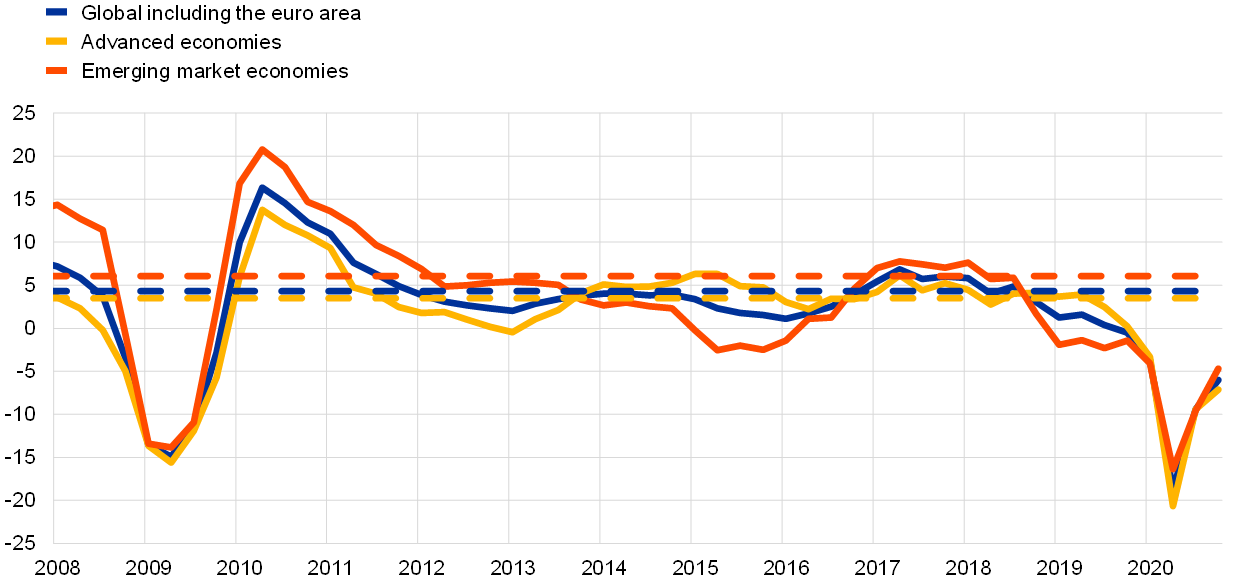
Notes: Global trade growth is defined as growth in global imports including the euro area. The solid lines indicate data and go up to the fourth quarter of 2020. The dashed lines indicate the long-term averages (between the fourth quarter of 1999 and the fourth quarter of 2020). The latest observations are for 25 February 2021.
Headline inflation fell, but core inflation decreased less
Global inflation declined in 2020, reflecting weak global demand linked to the pandemic (see Chart 3) and the sharp decline in the prices of many commodities. In the OECD area, headline annual consumer price inflation fell from around 2% in the second half of 2019 to 1.2% in December 2020 on account of falling energy prices and slowing food price inflation. Underlying inflation (excluding energy and food) declined less than headline inflation to around 1.6% at the end of 2020.
Chart 3
OECD consumer price inflation rates
(annual percentage changes; monthly data)
Source: Organisation for Economic Co-operation and Development (OECD).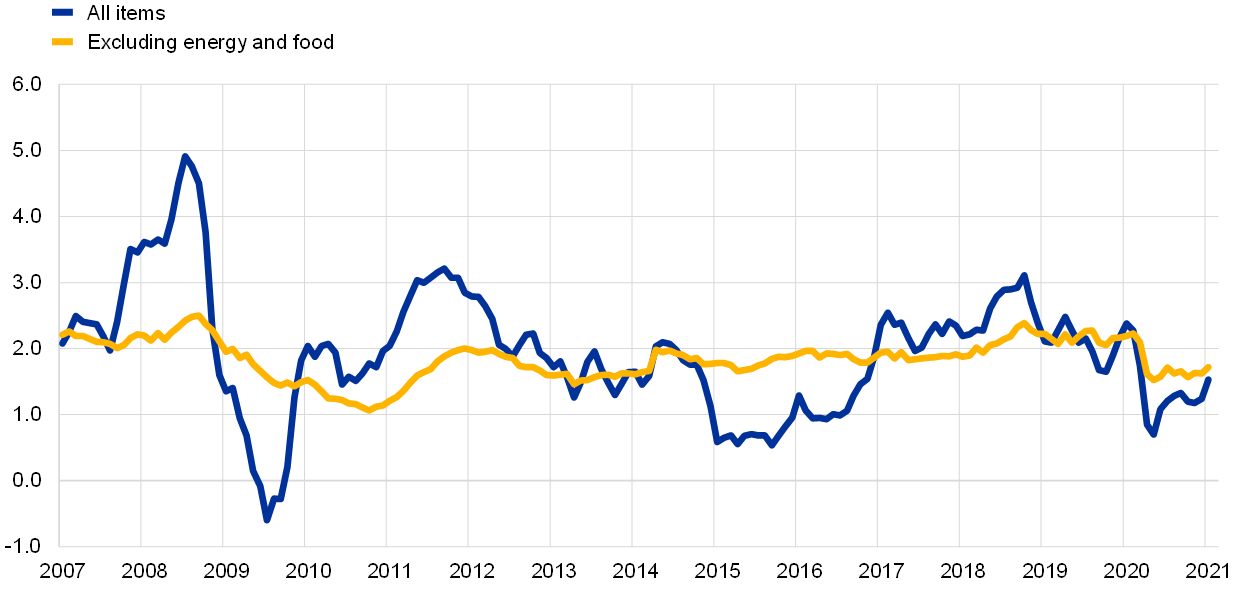
Note: The latest observations are for January 2021.
Oil prices fluctuated, driven by expectations of weak global demand
Oil prices declined sharply in the first half of the year, following the sharp fall in global demand, in particular as travel and work-from-home restrictions led to lower oil consumption. The price of the international benchmark Brent crude oil fluctuated widely between USD 20 (its lowest level in two decades) and USD 70 per barrel in 2020. The price of the US benchmark West Texas Intermediate oil fell below zero for a brief period in April.
The euro appreciated against currencies of euro area trading partners
The euro appreciated by around 7% in nominal effective terms over the course of 2020. In bilateral terms, this was driven by an appreciation of the euro mainly against the US dollar. The euro-pound sterling exchange rate rose, but exhibited significant volatility throughout 2020 mainly on account of changing expectations relating to Brexit.
The risks to global activity were tilted to the downside, but the prospect of a medical solution could boost the economic recovery
At the end of 2020, in the context of positive developments regarding COVID-19 vaccines, the outlook for global growth entailed a strong recovery in 2021. This outlook was highly uncertain however and, on balance, the risks to global activity were tilted to the downside, as the surge in new infections and further containment measures in major economies were affecting the pace of the recovery.[1]
1.2 The euro area economy co-moved closely with the global economy[2]

Following a moderation in economic activity in 2019, euro area real GDP contracted by 6.6% in 2020 (see Chart 4). The dramatic decline in economic activity and its unevenness throughout 2020 were the consequences of the impact of the COVID-19 pandemic shock and the associated lockdown measures implemented to contain the spread of the virus. The first wave of the pandemic hit euro area countries mainly between March and April, at a speed and with an intensity which were unprecedented, and was accompanied by strict economy-wide containment measures in most countries. As a result of these measures, euro area economic activity contracted by a cumulative 15.3% in the first half of 2020. The containment of the pandemic and the lifting of the containment measures, as of May 2020 in the majority of countries, led to a strong rebound in activity in the third quarter. However, by the autumn economic activity had started to decelerate again and the renewed spike in infections generated a further round of lockdowns in the final quarter of the year, which were however more targeted than those in place during the first wave. While the pandemic above all constituted a common shock hitting all economies, the economic impact of the pandemic was also heterogeneous to some degree across euro area countries, largely due to the different exposures to the sectors most affected by social distancing measures and also reflecting differences in the intensity of the health crisis itself and in the extent and character of the implemented stimulus measures. By the end of 2020 economic activity was 4.9% below pre-pandemic levels in the euro area, featuring considerable heterogeneity across countries, with Spain 9.1% below its pre-pandemic level and the Netherlands 3.0% below its pre-pandemic level.
Chart 4
Euro area real GDP
(annual percentage changes; percentage point contributions)
Source: Eurostat.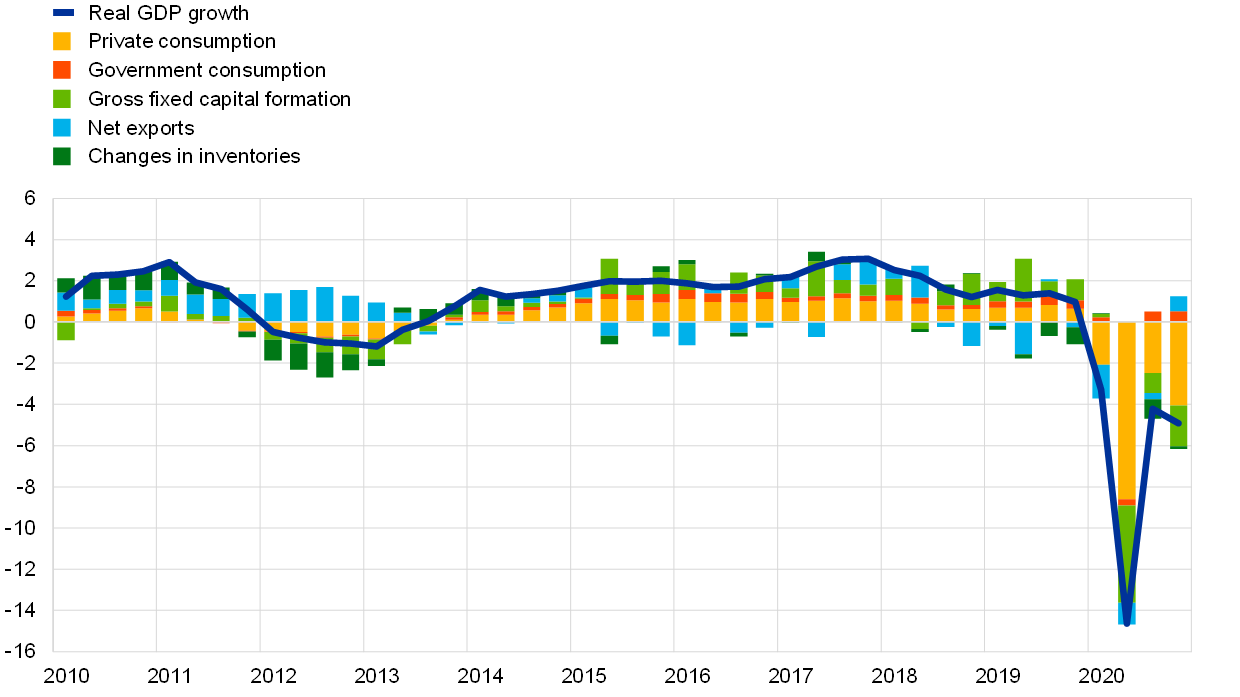
Note: The latest observations are for the fourth quarter of 2020.
Compared with recent long-lasting recessionary episodes, such as the 2008-09 global financial crisis or the 2011-12 euro area sovereign debt crisis, the recession accompanying the pandemic was more acute in the early phases. At the same time, strong signals and expectations of a recovery emerged much earlier than in other crises. This mainly reflected the exogenous nature of the COVID-19 shock, the role of timely and determined monetary and fiscal policy measures, and progress in developing vaccines, as well as the much more contained feedback loops with the financial sector compared with previous crisis episodes, the latter also helped by the targeted central bank measures.
Euro area private consumption decreased by 8.0% in 2020, declining particularly strongly in the first half of 2020 mainly on account of the lockdown measures. As losses in real disposable income caused by the lockdowns were buffered by substantial public transfers, the decline in consumption was also reflected in a sharp increase in the saving rate. As lockdown measures were eased significantly in the third quarter of 2020, private consumption showed a robust rebound, which was however interrupted in the final quarter of the year during the second wave of the pandemic. By the end of 2020 private consumption remained below pre-pandemic levels in the context of the hit to labour markets and the high degree of uncertainty.
Business investment also collapsed in the first half of 2020. As a result of the implemented lockdown measures and the ensuing severe falls in revenue, firms postponed investment decisions. Furthermore, impaired global and domestic demand continued to act as a drag on investment. In the second half of the year the business investment outlook was characterised by further heightened uncertainty amid a second wave of the pandemic and the expectation of lasting moderate developments in view of a weakened external environment, more moderate final demand and the observed deterioration in corporate balance sheets.
The net contribution by the external sector to euro area output was also negative in 2020. The lockdown in China, imposed to suppress COVID-19, dented euro area trade at the beginning of the year and the measures to contain the spread of the virus in Europe led to a slump in both imports and exports in the second quarter, with exports being hit the hardest by the temporary closure of business activities. Over the summer months the easing of restrictions paved the way for a rebound in trade flows, with improvements lagging behind in the hardest-hit travel, tourism and hospitality sectors. The renewed wave of the pandemic slowed down the recovery of euro area trade, which was incomplete at the end of the year.
The impact of COVID-19 on output growth was also uneven across sectors, with the services sector contributing the most to the fall in real gross value added, reflecting its particular exposure to social distancing measures as well as the sectoral composition of the euro area economy (see Chart 5).
Chart 5
Euro area real gross value added by economic activity
(annual percentage changes; percentage point contributions)
Source: Eurostat.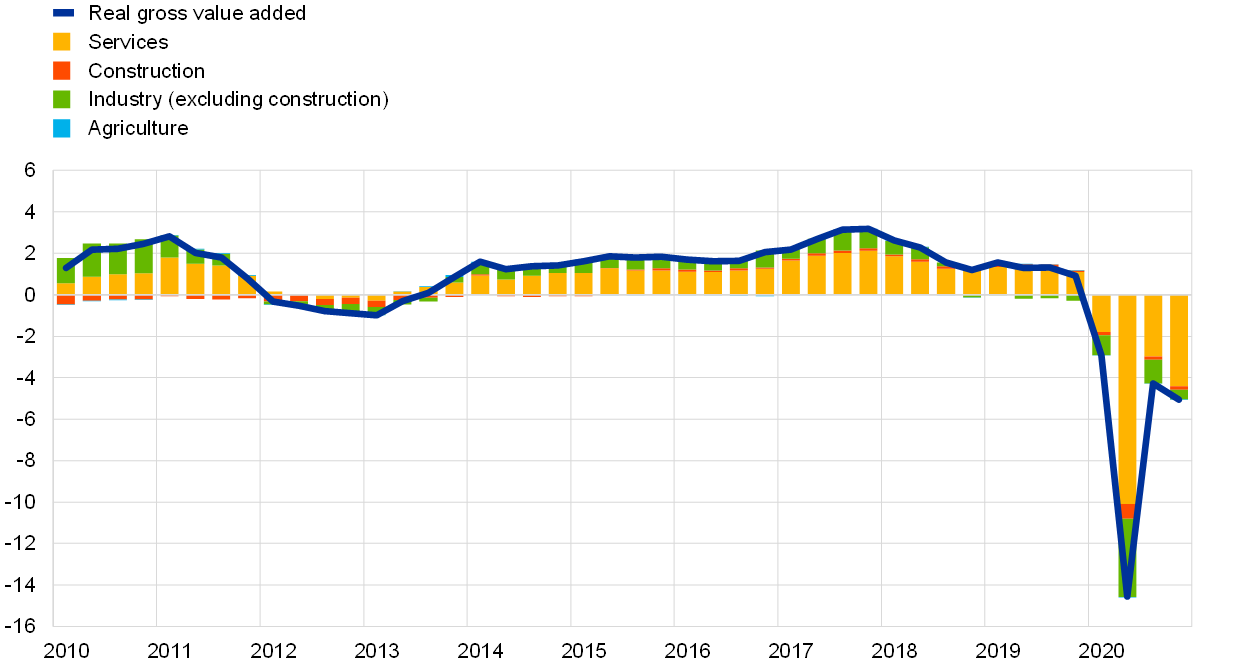
Note: The latest observations are for the fourth quarter of 2020.
Euro area labour markets weakened, although government policies helped to cushion the impact on unemployment
Employment losses in 2020 remained contained, reflecting the impact of job retention schemes
While employment growth was also significantly affected by the pandemic, labour market policies shaped the outcomes in euro area labour markets in 2020 (see Chart 6). Compared with the large and rapid contraction of economic activity by about 15% during the first half of 2020, the employment contraction was smaller, but still very significant. Total employment decreased by about 5 million people over the same period, which brought employment back to pre-2018 levels. Government support measures across euro area countries helped to limit job dismissals (see Box 1 for a discussion on job retention schemes). In comparison with previous economic and financial crises, euro area governments increased the number of workers covered by job retention schemes, which greatly limited job lay-offs, thereby helping to preserve firm and worker-specific human capital. Nevertheless, the labour force participation rate decreased significantly during the pandemic crisis and about 3 million people moved out of the labour force during the first half of 2020. The ongoing labour market adjustment has affected workers differently because of the relevance of the current crisis for the services sector and for the firms most affected by social distancing measures and mobility restrictions. In particular, the labour force contracted by almost 7% for people with low skills and 5.4% for those with medium skills, but it actually grew by 3.3% for those with high skills.
Chart 6
Labour market indicators
(percentage of the labour force; quarter-on-quarter growth rate; seasonally adjusted)
Source: Eurostat.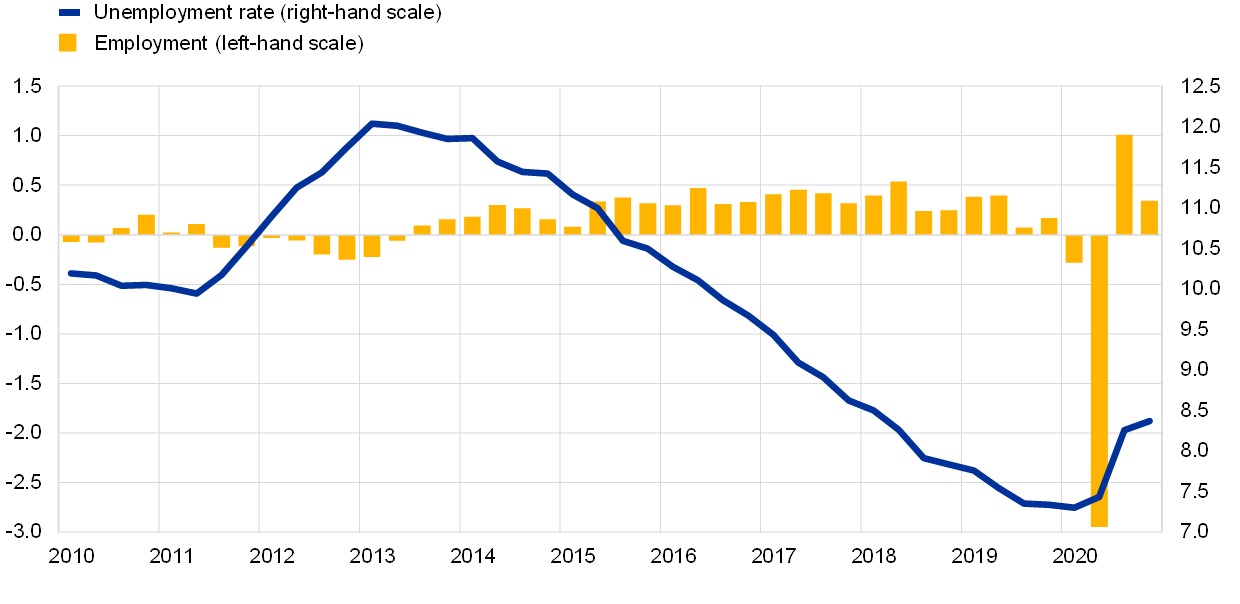
Note: The latest observations are for the fourth quarter of 2020.
The increase in the unemployment rate was smaller than in previous recessions
Employment contracted by 1.9% in 2020, while the unemployment rate rose to 8.4%. The increase in the unemployment rate was smaller than in previous recessions, such as the ones in 2008-09 and 2011-12, also thanks to the timely and extensive response of euro area governments. At the same time, hourly labour productivity growth averaged around 1% in 2020 and was buffered by the significant reduction in hours worked because of the use of job retention schemes.
Box 1
The medium and long-term economic impact of COVID-19
Euro area labour markets have reacted to the economic consequences of the COVID-19 pandemic in a rather resilient fashion, supported by economic policies – such as job retention schemes and loan guarantees – which have helped to limit employment losses and to avoid an abrupt surge in firm exits as a result of the pandemic. In order to prevent long-term scars from the crisis, and also to avoid impeding the necessary restructuring of the economy, the design and timing of the exit strategies for these policies will be as important as those of the support packages themselves. Looking ahead, the long-term consequences of the pandemic for labour mobility, as well as the increasing adoption of digitalisation, may call for significant job and firm reallocation.
In a recent survey of leading euro area companies, considerable emphasis was placed on how the pandemic has accelerated the take-up of digital technologies, raising productivity but reducing employment in the long term.[3] When asked to explain, in order of importance, up to three ways in which the pandemic would have a long-term impact on their businesses, the most frequently cited effects related to the increased use of the “home office” environment and the accelerated use of digital technologies. Other factors widely mentioned were a more permanent reduction in business travel and/or an increase in virtual meetings, as well as increased e-commerce (or – in business-to-business segments – “virtual selling”). A large majority of the respondents agreed that their business would be more efficient and/or more resilient as a consequence of what had been learned during the pandemic. Around three-quarters of respondents said that a significantly higher share of their workforce would work remotely in the long term. At the same time, they did not believe that remote working would reduce staff productivity. In this regard, while reduced informal personal interaction was seen as a downside, many advantages were also perceived, including the time gains due to diminished commuting needs, the possibility to better juggle home and work commitments, and increased connectivity. Consistent with this, more than half of the respondents said that productivity in their business or sector would increase, while hardly any saw productivity decreasing as a long-term consequence of the pandemic. Conversely, more than half anticipated a negative long-term impact on employment, compared with only around 10% who saw a positive long-term effect on employment. Views on the long-term impact on sales as well as prices, costs and wages were more mixed, but on balance negative.
The pandemic crisis has had a significant impact on the euro area labour market. The euro area unemployment rate (see Chart A, blue line) has shown a muted response compared with the contraction in economic activity and does not fully reflect the impacts of COVID-19 on the labour market. To better measure the amount of labour underutilisation during the pandemic crisis, the standard unemployment rate can be adjusted to reflect the number of discouraged workers who are currently inactive (see Chart A, yellow line). In addition, a special feature of the pandemic crisis has been the widespread use of job retention schemes, which have helped to protect jobs while reducing working hours and supporting the income of workers. The number of workers in job retention schemes reached about 30 million (about 19% of the labour force) in April 2020. Combining the standard unemployment rate with discouraged workers and also with the number of workers in job retention schemes (see Chart A, red line) hence provides a more representative picture of the state of labour underutilisation.
Chart A
Standard and non-standard measures of unemployment
(percentages)
Sources: ECB calculations based on Eurostat data.[4]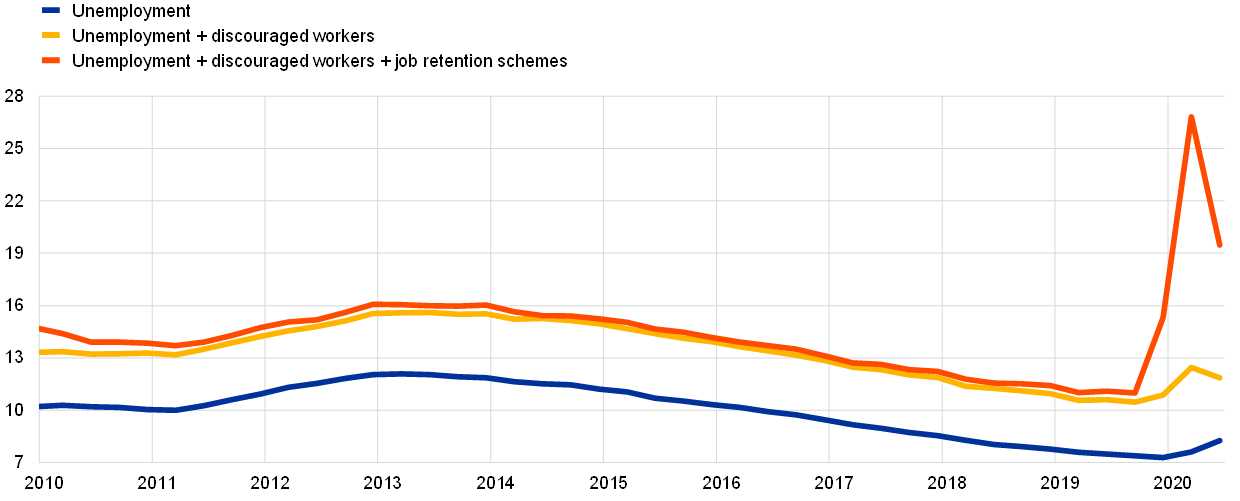
Overall, the COVID-19 shock has increased the share of firms at risk, which could have a further long-term effect on employment losses. Following the strong decline in economic activity in the second quarter of 2020, the recovery seen during the third quarter suggested that the pandemic shock could be of a largely transitory nature. However, the second wave of lockdown measures intensified the risk of long-term scarring effects on economic growth and jobs. The COVID-19 shock has affected sectors heterogeneously, with weaker effects on firms featuring a higher adoption of digital technologies and a stronger impact on firms involved in face-to-face interactions. The latter firms might be at risk of exiting the market, depending on the length of the pandemic and whether national policy measures are successful in limiting and bridging liquidity shortfalls. The second distinct characteristic of the COVID-19 shock relates to its exogenous nature, implying that the shock has affected both productive and unproductive firms. Indeed, the cleansing effect resulting from the exit of less productive firms, typically more affected by a productivity shock, will be smaller than in previous crises because also more productive firms with temporary liquidity problems might be at risk.[5]
1.3 The fiscal policy response to the crisis
The COVID-19 pandemic posed unprecedented challenges to public finances
In 2020 public finances were deeply marked by the COVID-19 pandemic, which posed unprecedented challenges to governments, but also triggered a strong policy response. The fiscal position was significantly affected on both sides of government budgets, through the increase in expenditure needed to tackle the crisis and through lower fiscal revenues reflecting both the sharp recession and expenditure measures targeting firms and households. As a result, the general government deficit ratio for the euro area increased from 0.6% of GDP in 2019 to 8.0% of GDP in 2020, according to the December 2020 Eurosystem staff macroeconomic projections (see Chart 7). Reflecting the strong economic support from governments, the fiscal stance[6] thus went from mildly expansionary in 2019 to highly accommodative, at 4.8% of GDP, in 2020, although it should be noted that the size of the fiscal response and thereby the fiscal stance differed significantly across countries. Overall, however, the swiftness and scope of the support provided by euro area governments demonstrated a heightened capacity to react in times of crisis and to do so in a coordinated way. The latter was facilitated by the activation of the general escape clause foreseen in the Stability and Growth Pact.
Chart 7
General government balance and fiscal stance
(percentage of GDP)
Sources: Eurostat and ECB calculations.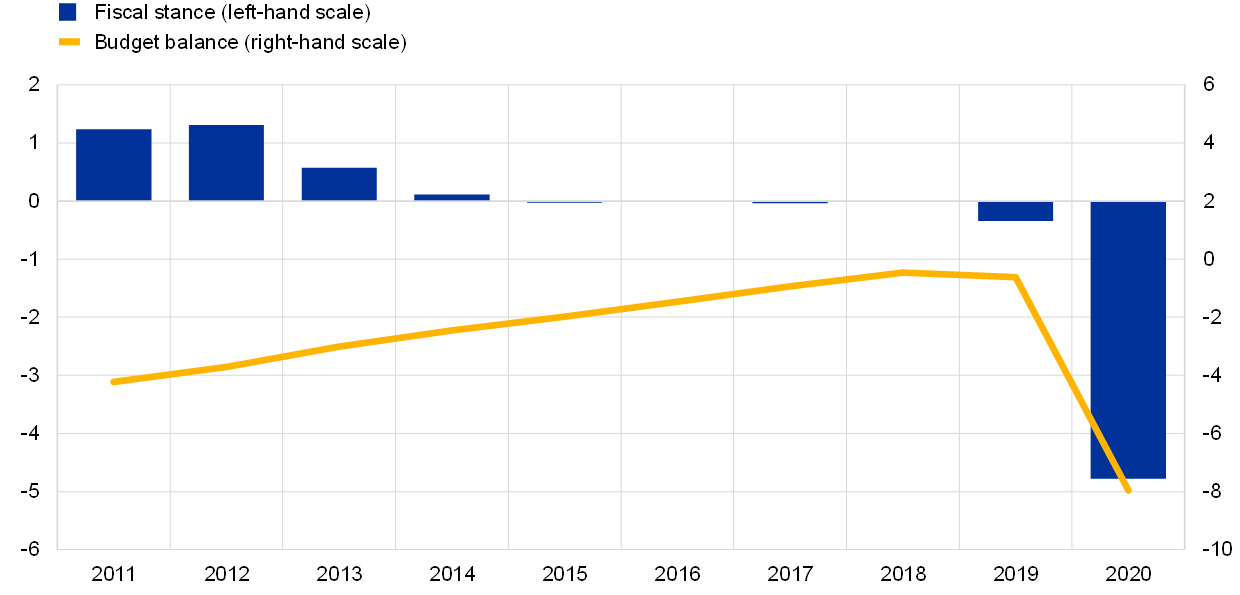
The bulk of additional spending was related to either direct costs of addressing the health crisis or support to households and firms
According to estimates by the European Commission[7], the fiscal measures taken in response to the pandemic amounted to 4.2% of GDP in 2020 for the euro area as a whole. The bulk of this additional spending was related to either direct government costs of addressing the public health crisis or support measures targeted at households and firms (see Chart 8). A primary aim of these support measures was to preserve employment and production capacity so that the economy is well positioned to stage a rapid recovery once the pandemic abates. In line with this aim, the large majority of the support provided to households was through short-time work or furlough schemes designed to avoid mass unemployment, while only a smaller part took the form of direct fiscal transfers to households.[8] Towards the end of the first wave of the pandemic, some more limited measures aimed at supporting the economic recovery were introduced, such as cuts to indirect taxes or an increase in public investment projects. However, given that the pandemic was far from resolved in 2020, with the eruption of a second wave in the autumn, these measures are more likely to play a prominent role going forward.
Chart 8
Estimated composition of COVID-19-related measures in 2020
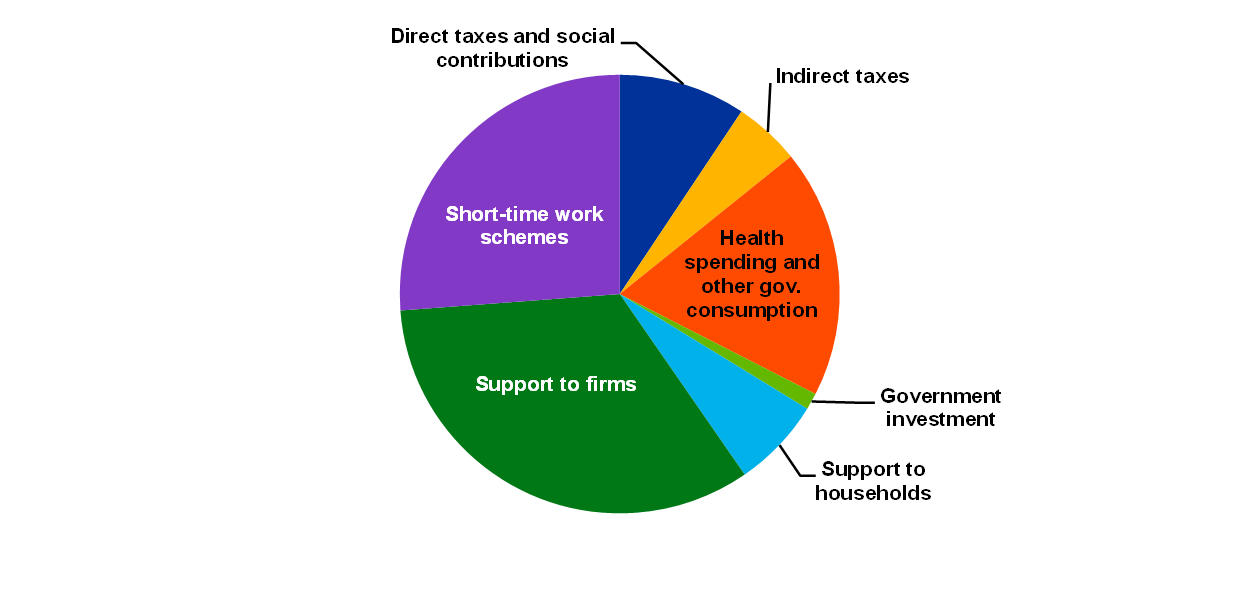
Sources: ECB calculations based on the 2021 draft budgetary plans.
Governments also provided sizeable liquidity support to the economy
In addition to the fiscal support for their economies, euro area countries provided a sizeable amount of loan guarantees to bolster the liquidity position of firms, particularly to small and medium-sized enterprises, which often do not have easy access to external financing. Such liquidity support was particularly prominent in the policy mix in the early phase of the crisis before other support programmes were put in place. In total, these guarantees amounted to around 17% of GDP for the euro area as a whole.[9] The loan guarantees are contingent liabilities for governments and the amount of guarantees called on will therefore constitute additional public spending. Moreover, many governments also granted tax deferrals and provided loans to and made equity injections into firms. Such cash injections and other liquidity support are generally not captured in the budget balance, but are partly reflected in government debt.
Debt levels of governments were adversely affected, but risks to debt sustainability continued to be well contained
The crisis has also led to a marked increase of debt levels of sovereigns across the euro area. This was reflected in the December 2020 Eurosystem staff macroeconomic projections, which showed that the aggregate debt-to-GDP ratio was estimated to have surged to 98.4% of GDP in 2020, which is an increase of 14.5 percentage points compared with 2019. Sovereigns additionally took on extensive contingent liabilities in the form of loan guarantees. Although it will take time to substantially reduce debt levels, there are no signs that public debt sustainability in the euro area would be questioned. This assessment rests on the improved expectations for a recovery in 2021, especially after positive developments on several COVID-19 vaccines, but importantly also on financing conditions which should continue to be supportive for the foreseeable future. Moreover, the coordinated fiscal action taken at the EU level should provide a stabilising effect (see Box 4 for a recent example). It is still important that Member States return to sound fiscal positions once economic activity has recovered.
1.4 Inflation declined markedly due to the drop in oil prices and the economic contraction[10]

Headline inflation in the euro area stood at 0.3% on average in 2020, down from 1.2% in 2019. In terms of the components of the Harmonised Index of Consumer Prices (HICP), this decline essentially reflected lower contributions from energy inflation, but in the second half of the year also from HICP inflation excluding energy and food (see Chart 9). In terms of its driving factors, the disinflationary process took place against the background of sharp contractions in economic activity, which significantly weakened consumer demand and posed severe downside risks to the economic outlook. Disinflationary pressures also reflected some factors specific to the economic implications of and responses to the COVID-19 pandemic. For instance, the further decline of inflation in the second half of the year was partly due to the drop in the prices of travel-related services (especially transport and hotels), hit hardest by the crisis, and to the impact of the temporary reduction in the VAT rate in Germany.
Chart 9
HICP inflation and contributions by components
(annual percentage changes; percentage point contributions)
Sources: Eurostat and ECB calculations.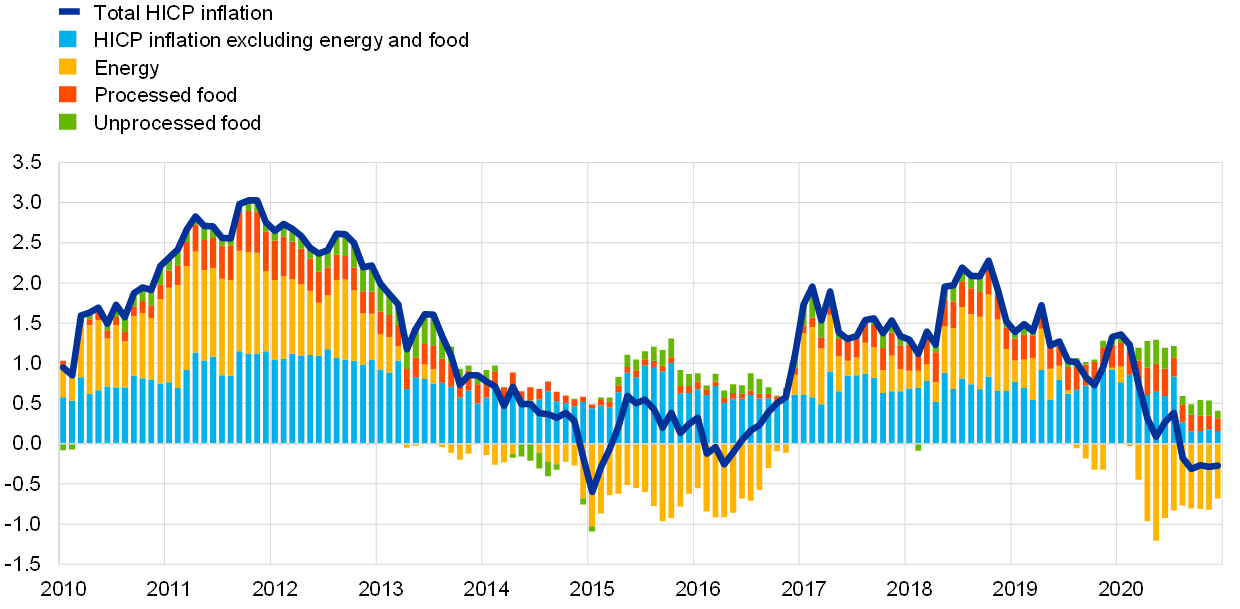
Volatile components of the HICP partly developed in opposite directions
Developments in energy inflation contributed to a large extent to the decline in average headline inflation in 2020 compared with 2019, reflecting the drop in oil prices at the beginning of the pandemic. By contrast, the contribution of total food inflation to headline HICP inflation increased slightly to 0.4 percentage points in 2020, slightly above the level in 2019, largely reflecting the fact that in particular unprocessed food inflation temporarily increased substantially amid the pandemic (with a spike of 7.6% in April 2020).[11]
Underlying inflation declined over the course of 2020
Measures of underlying inflation declined over the course of 2020. HICP inflation excluding energy and food was 0.7% on average after 1.0% in 2019, with a record low being recorded in the last four months of 2020. Weak developments in both non-energy industrial goods and services inflation contributed to subdued HICP inflation excluding energy and food. Non-energy industrial goods inflation turned negative in August 2020, reaching a record low in December 2020, and services inflation reached an all-time low of 0.4% in October 2020, although it increased slightly thereafter. Developments in these two components were affected by a common set of factors but to a somewhat different extent. The appreciation of the euro in the second half of the year affected non-energy industrial goods inflation somewhat more than services inflation. The same holds for the changes in indirect taxes as some components of services such as rents are exempted from VAT. The lockdowns and containment measures in the context of the pandemic had a larger impact on the level of services inflation, which was particularly visible in the drop in inflation for travel and leisure-related items. More generally, however, non-energy industrial goods inflation and services inflation were dominated by the plummeting demand that the pandemic triggered via increased uncertainty and risk aversion, containment measures, and income and job losses. This considerably outweighed some upward effects from supply disruptions in certain sectors. Furthermore, the pandemic hampered HICP price collection. As a result, the share of imputed prices in the HICP spiked in April and then declined, with imputed prices only being used for a few items from July to October. The share of imputed prices was again elevated in November and December, albeit below the level during the spring.[12] The demand and supply effects likely also implied that the shares of individual goods and services in consumption were different from those underlying the construction of the HICP in 2020.
Domestic cost pressures increased
Domestic cost pressures, as measured by the growth in the GDP deflator, increased on average in 2020, at a rate above the average level of 2019 (see Chart 10). By contrast, the annual growth in compensation per employee declined rapidly in 2020, standing at -0.6%, well below the 2019 value. At the same time, the even larger drop in productivity growth implied a substantial increase in unit labour cost growth, contributing to the observed growth in the GDP deflator. Unit labour cost growth stood at 4.6% in 2020, up from 1.9% in 2019. However, developments in unit labour cost growth, productivity growth and compensation per employee growth in 2020 were affected by the widespread application of short-time work schemes, which implied, for instance, that employment remained much more resilient than output or actual hours worked. There were also issues related to the statistical recording of these measures, which implied an unusually large contribution of subsidies to developments in domestic costs and hampered the comparability of recent developments with past developments.[13] On the expenditure side, such statistical issues were, for example, visible in the sharp increase in the growth rate of the government consumption deflator in the second quarter.
Chart 10
Breakdown of the GDP deflator
(annual percentage changes; percentage point contributions)
Sources: Eurostat and ECB calculations.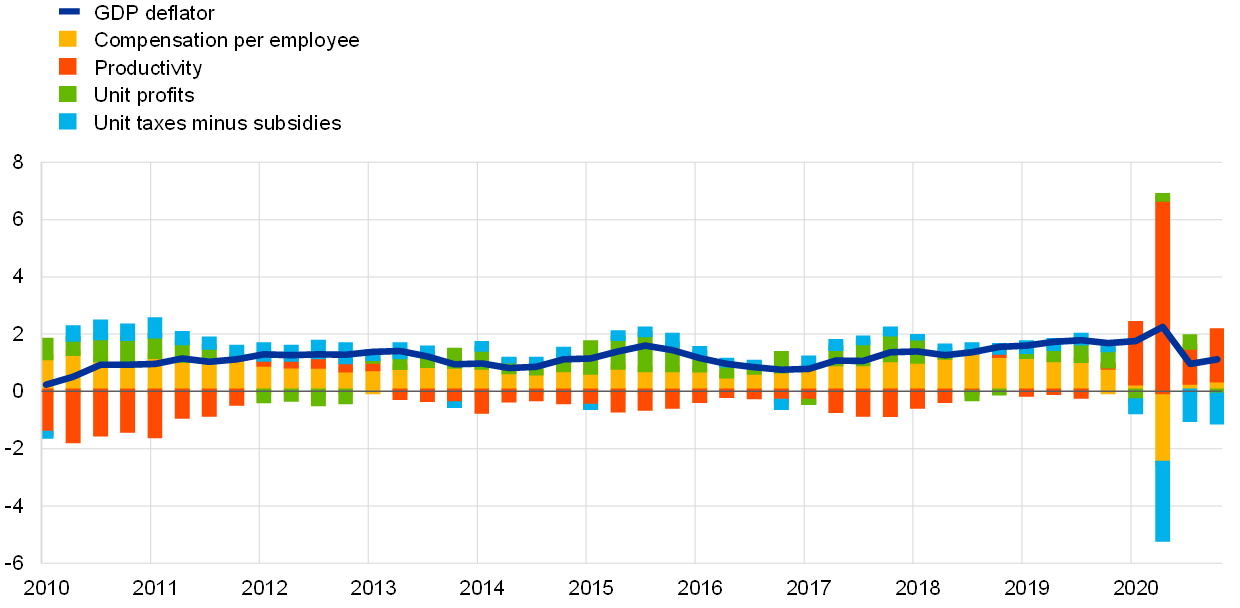
Longer-term inflation expectations remained at historically low levels
Longer-term inflation expectations in the ECB Survey of Professional Forecasters (SPF) remained at historically low levels in 2020, hovering between 1.6% and 1.7%, having fallen to these levels in the previous year. Expectations for inflation five years ahead from the SPF stood at 1.7% in the fourth quarter of 2020, unchanged from the fourth quarter of 2019. Market-based measures of longer-term inflation expectations, in particular the five-year inflation-linked swap rate five years ahead, showed notable volatility throughout the year. The latter rate declined sharply at the beginning of the pandemic and reached its lowest level on record at the end of the first quarter of 2020 (standing at 0.7% on 23 March), before recovering and stabilising close to pre-pandemic levels towards the end of the year (standing at 1.3% on 31 December). That said, market-based indicators of longer-term inflation expectations remained very subdued.
1.5 Decisive policy action kept credit and financing conditions supportive
Euro area government bond yields declined in 2020 against the background of a resolute monetary and fiscal crisis response
The COVID-19 pandemic led to a swift deterioration in the global and domestic economic outlook, together with a sharp increase in sovereign spreads in an environment of generally tightening financial conditions. To counter the impact of the pandemic shock on the economy and inflation and faced by emerging risks for financial stability and the smooth functioning of monetary policy transmission, monetary and fiscal policy authorities responded promptly and resolutely (see Section 2.1). They thus effectively countered the shock-induced tightening of financial conditions and contributed, in particular, to a decline in long-term risk-free rates and a compression, from their pandemic highs, of the spreads of euro area countries’ ten-year government bond yields vis-à-vis the ten-year overnight index swap rate. As a result, the euro area GDP-weighted average of ten-year government bond yields declined by 50 basis points between 1 January 2020 and 31 December 2020, when it stood at -0.23% (see Chart 11).
Chart 11
Long-term yields in the euro area and the United States
(percentages per annum; daily data)
Sources: Bloomberg, Thomson Reuters Datastream and ECB calculations.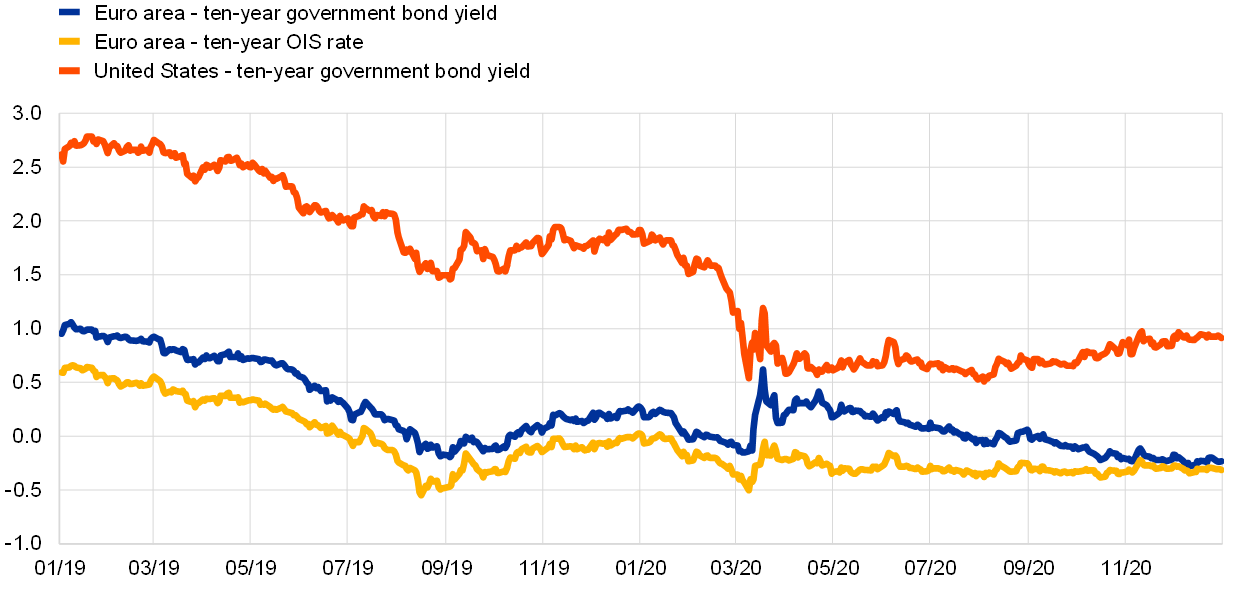
Notes: The euro area data refer to the GDP-weighted average of ten-year government bond yields and the ten-year overnight index swap (OIS) rate. The latest observations are for 31 December 2020.
Despite recovering from their pandemic lows, euro area equity prices remained below their early 2020 levels
After their collapse in mid-March, stock prices staged a gradual but consistent recovery on the back of the rebound in activity and firming growth expectations, supported by monetary and fiscal policies, and encouraging news concerning potential vaccines, which likely lowered the equity risk premium and supported market expectations of a recovery in earnings. As such, this development was quite different from the larger and especially more protracted stock market correction which occurred in the wake of the 2008-09 financial crisis. At the same time, euro area equity prices showed distinct sectoral divergence compared with the respective levels at the end of 2019. The broad index for euro area non-financial corporation (NFC) equity prices stood by the year-end marginally above end-2019 levels, while euro area bank equity prices declined more severely and remained around 24% lower (see Chart 12).
Chart 12
Equity market indices in the euro area and the United States
(index: 1 January 2019 = 100)
Sources: Bloomberg, Thomson Reuters Datastream and ECB calculations.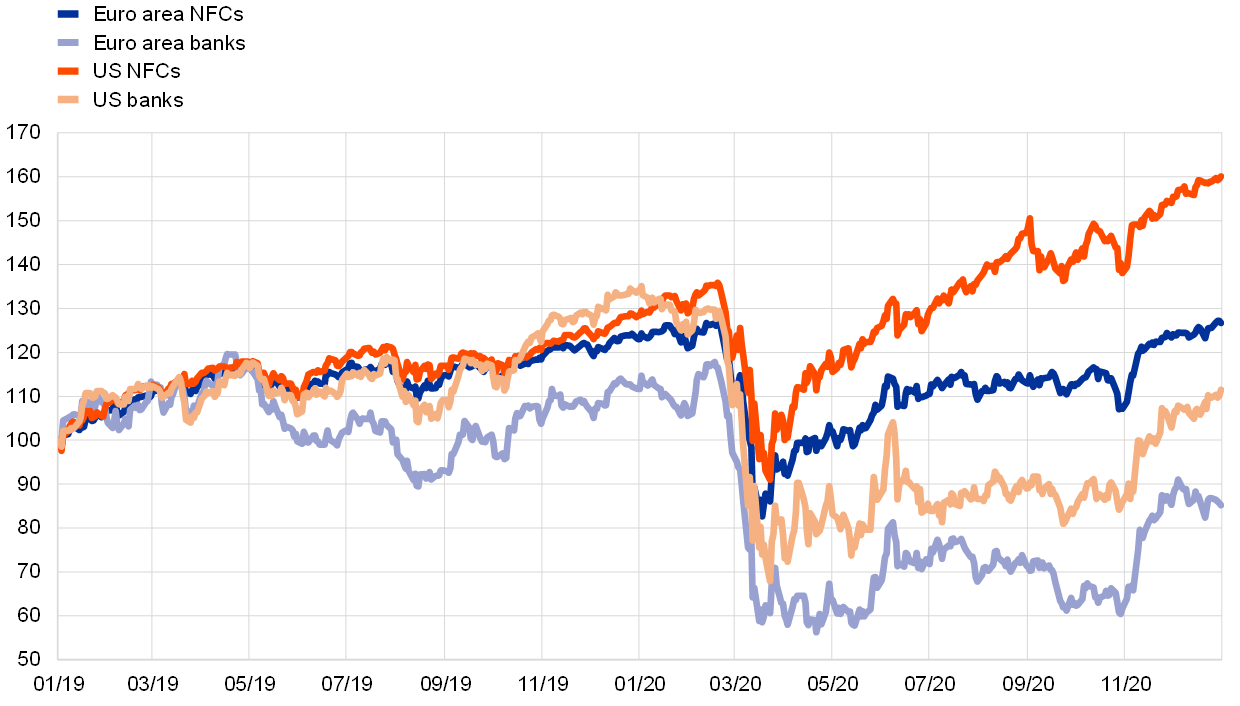
Notes: The EURO STOXX banks index and the Datastream market index for non-financial corporations (NFCs) are shown for the euro area; the S&P banks index and the Datastream market index for NFCs are shown for the United States. The latest observations are for 31 December 2020.
NFCs’ borrowing from banks and issuance of debt securities increased
The external financing flows of non-financial corporations increased in 2020 compared with the previous year, but remained below their latest peak observed in 2017 (see Chart 13). During 2020 bank lending rates remained broadly stable around their historical lows, in line with the evolution of market rates. At the same time, strong growth in borrowing by NFCs from banks and their issuance of debt securities could be observed, reflecting the exceptionally high liquidity needs in the light of the substantial economic contraction and sharp declines in corporate sales and cash flows. Net issuance of listed shares was negative, which can mainly be explained by a delisting in the second quarter of 2020. By contrast, net issuance of unlisted shares and other equity was robust, also when correcting for the impact of the delisting, likely also reflecting capital injections in the face of losses. Finally, the use of other sources of financing, including inter-company loans and trade credit, was broadly stable.
Chart 13
Net flows of external financing to non-financial corporations in the euro area
(annual flows; EUR billions)
Sources: Eurostat and ECB.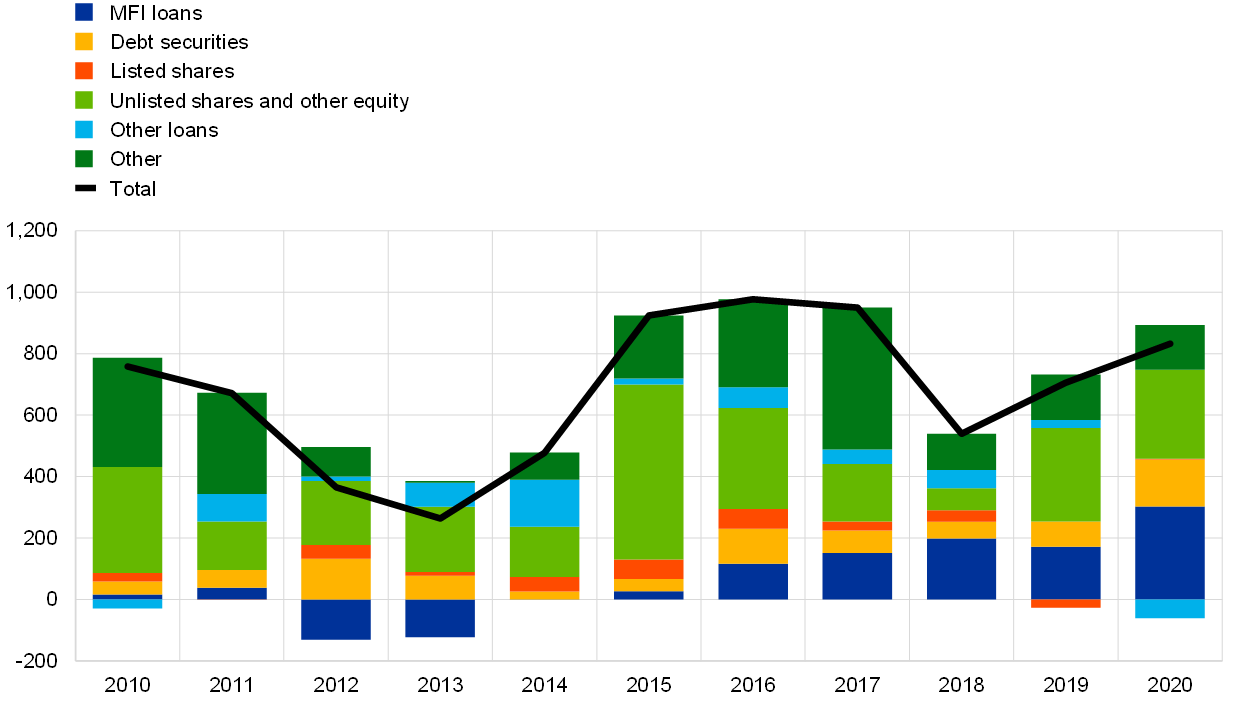
Notes: “Other loans” include loans from non-MFIs (other financial intermediaries, pension funds and insurance corporations) and from the rest of the world. “MFI loans” and “other loans” are corrected for loan sales and securitisation. “Other” is the difference between the total and the instruments included in the chart and includes inter-company loans and trade credit. The latest observations are for the third quarter of 2020.
Money and loan growth accelerated in response to the COVID-19 crisis
Broad money growth sharply increased in response to the COVID-19 crisis (see Chart 14), mainly driven by the narrow aggregate M1. This acceleration reflected the build-up of liquidity buffers by firms and households amid increased uncertainty but also, in the case of households, some forced savings owing to reduced opportunities to consume. Money creation was driven by an expansion of domestic credit, both to the private sector and to governments, in the latter case mainly reflecting the asset purchases of the Eurosystem. The timely and sizeable measures taken by monetary, fiscal and supervisory authorities have ensured the flow of credit to the euro area economy at favourable terms.
Chart 14
M3 and loans to the private sector
(annual percentage changes; adjusted for seasonal and calendar effects)
Sources: Eurostat and ECB.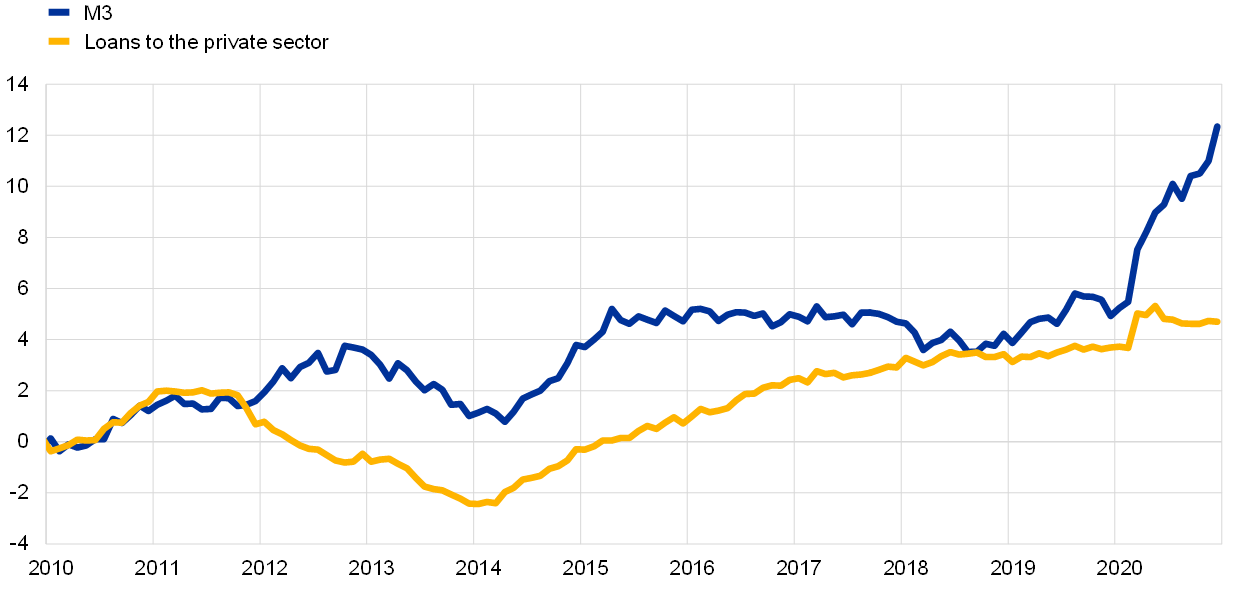
Note: The latest observations are for December 2020.
Banks’ heightened risk perceptions exerted a tightening impact on credit standards
While bank lending conditions were overall supportive during the year, the euro area bank lending survey showed that banks’ credit standards (i.e. approval criteria) for loans to firms tightened in the second half of 2020. This was mainly driven by banks’ heightened risk perceptions associated with the impact of the pandemic on the outlook for borrower creditworthiness. At the same time, asset purchases under the asset purchase programme and the pandemic emergency purchase programme, as well as the third series of targeted longer-term refinancing operations, especially after the recalibrations in March and April, were reported by banks to have contributed to improvements in banks’ liquidity position and market financing conditions. These measures, together with those introduced by governments such as loan guarantees and moratoria, prevented a more pronounced tightening of credit standards.
The ECB substantially eased the monetary policy stance over the course of 2020 to counter the negative impact of the COVID-19 pandemic on the euro area economy. The comprehensive set of measures and their subsequent recalibrations mitigated the threat of a liquidity and credit crunch by preserving ample liquidity conditions in the banking system, protected the flow of credit to the real economy and safeguarded the accommodative monetary policy stance by averting a procyclical tightening of financing conditions. The monetary policy response in 2020 was a crucial stabilising force for markets and helped to counter the serious risks posed by the rapid spread of the virus to the monetary policy transmission mechanism, the outlook for the euro area economy and, ultimately, the ECB’s price stability objective. The size of the Eurosystem’s balance sheet reached a historical high of €7 trillion in 2020, an increase of €2.3 trillion compared with the end of the previous year. At the end of 2020 monetary policy-related assets accounted for 79% of the total assets on the Eurosystem’s balance sheet. Risks related to the large balance sheet continued to be mitigated by the ECB’s risk management framework.
2.1 The ECB’s monetary policy response to the pandemic emergency provided crucial support to the economic recovery and the inflation outlook[14]
The ECB’s initial response to the COVID-19 pandemic
The cautiously optimistic mood at the start of the year was forcefully interrupted by COVID-19
At the start of the year, incoming information signalled ongoing, but moderate, growth of the euro area economy. While the weakness of international trade in an environment of global uncertainty was still a drag on growth, employment gains in conjunction with rising wages, the mildly expansionary euro area fiscal stance and the ongoing – albeit somewhat slower – growth in global activity supported the euro area economy. Inflation developments remained subdued overall, but there were some signs of a moderate increase in underlying inflation in line with expectations. The monetary policy measures taken in the course of 2019 were underpinning favourable financing conditions, thereby supporting the euro area economic expansion, the build-up of domestic price pressures and the convergence of inflation towards the Governing Council’s medium-term aim.
At its January 2020 meeting, the Governing Council decided to launch a review of the ECB’s monetary policy strategy. Since its last strategy review, the euro area and world economies have been undergoing profound structural changes. Declining trend growth, on the back of slowing productivity and an ageing population, as well as the legacy of the financial crisis, have driven interest rates down, reducing the scope for the ECB and other central banks to ease monetary policy with conventional instruments in the face of adverse cyclical developments. In addition, addressing low inflation is different from the historical challenge of addressing high inflation. The threat to environmental sustainability, rapid digitalisation, globalisation and evolving financial structures have further transformed the environment in which monetary policy operates, including the dynamics of inflation. In the light of these challenges, the Governing Council decided to launch a review of its monetary policy strategy, in full respect of the ECB’s price stability mandate as enshrined in the Treaty (see Box 2).
The cautiously optimistic mood at the start of the year was forcefully interrupted in late February by the outbreak and global spread of COVID-19. Although the magnitude and duration of the downward revision to the growth outlook were uncertain, it became increasingly clear that the pandemic would have a major impact on the euro area economy. While disruptions to global supply chains were seen to potentially exert some upward pressure on euro area inflation, this was expected to be dominated by weaker demand holding inflation back. Moreover, the sharp deterioration in risk sentiment caused a severe tightening in financial and bank funding conditions, which – in combination with the moderate appreciation of the euro exchange rate – risked adding downward pressure on inflation.
A comprehensive package of monetary policy measures was necessary
Against this background, the Governing Council decided at its monetary policy meeting on 12 March 2020 that a comprehensive package of monetary policy measures was necessary. The package aimed, on the one hand, to mitigate the threat of a liquidity and credit crunch by preserving ample liquidity conditions in the banking system and protecting the flow of credit to the real economy, and, on the other hand, to safeguard the accommodative monetary policy stance by averting a procyclical tightening of financing conditions in the economy.
In particular, the Governing Council decided on additional longer-term refinancing operations (LTROs) at an interest rate equal to the deposit facility rate. It also decided to apply considerably more favourable terms to all operations under the third series of targeted longer-term refinancing operations (TLTRO III) during the period from June 2020 to June 2021. The interest rate on TLTRO III operations was reduced by 25 basis points and could be as low as 25 basis points below the average deposit facility rate during the period from June 2020 to June 2021 for all TLTRO III operations outstanding during that period. Moreover, the maximum total amount that counterparties were entitled to borrow in TLTRO III operations was raised to 50% of their stock of eligible loans. Accordingly, the additional LTROs would effectively allow banks to immediately benefit from very favourable borrowing conditions and would provide an effective bridge until the start of the recalibrated TLTRO III operations, which aimed to ease funding conditions for banks more sustainably in order to support credit flows to affected sectors and avoid a tightening in credit supply.
The Governing Council also decided to add a temporary envelope of additional net asset purchases of €120 billion to the asset purchase programme (APP) until the end of the year, ensuring a strong contribution from the private sector purchase programmes. Limiting the additional envelope to the current calendar year was deemed an appropriate response to a shock that was assessed as being temporary. In combination with the existing APP, this temporary envelope aimed to support favourable financing conditions for the real economy in times of heightened uncertainty.
In the week following the March 2020 Governing Council meeting, the situation deteriorated significantly owing to the rapid spread of COVID-19, with nearly all euro area countries enforcing far-reaching containment measures. Financial markets exhibited extreme volatility, with signs of severe dislocations due to illiquidity and market freezes and rising fragmentation. This led to a sharp tightening in financing conditions, which could have impaired the smooth transmission of the ECB’s monetary policy across all euro area countries and put price stability at risk.
In view of this rapid deterioration, the Governing Council decided on 18 March 2020 that a further forceful monetary policy response was warranted in order to stabilise markets and counter the sharp tightening of financial conditions. The aim of this action was to counter the serious risks posed by the pandemic to the outlook for the euro area economy, the monetary policy transmission mechanism and, ultimately, the ECB’s price stability objective. The Governing Council announced the following additional measures.
The Governing Council decided to launch a new temporary asset purchase programme: the pandemic emergency purchase programme
First, it decided to launch a new temporary asset purchase programme – the pandemic emergency purchase programme (PEPP). The PEPP, with an overall envelope of €750 billion, would include all the asset categories eligible under the APP. In addition, the Governing Council also expanded the range of eligible assets under the corporate sector purchase programme to include non-financial commercial paper, making marketable debt instruments with an initial maturity of below one year eligible if their remaining maturity was at least 28 days at the time of purchase. The expansion of eligible assets would support the funding situation of companies, thereby providing crucial assistance to a part of the economy that was being hit hard by the effects of the virus. For purchases under the PEPP, the Governing Council also decided to grant a waiver of the eligibility requirements for debt securities issued by the Hellenic Republic. In addition, the Governing Council decided that public sector securities with a remaining time to maturity of below one year, but at least 70 days, would be eligible for purchases under the PEPP, owing to its temporary nature.
The PEPP was designed to fulfil a dual role. First, together with the other components of the monetary policy framework, the PEPP aimed to deliver the monetary accommodation required to ensure that medium-term price stability was protected by supporting the economic recovery from the pandemic crisis. Second, purchases under the PEPP would be conducted in a flexible manner, allowing for fluctuations in the distribution of purchase flows over time, across asset classes and among jurisdictions. The flexibility embedded in the design of the programme ensured that the PEPP could fulfil a market stabilisation role in an efficient manner, especially in view of the high uncertainty associated with the effects of the pandemic across different asset markets and euro area countries.
In addition, the Governing Council announced at the same meeting that it would temporarily ease collateral standards by adjusting the main risk parameters of the collateral framework to ensure that counterparties could continue to make full use of the Eurosystem’s credit operations. More specifically, the Governing Council subsequently adopted two packages of temporary collateral easing measures. The first set of measures announced on 7 April 2020 aimed to facilitate the availability of eligible collateral to Eurosystem counterparties so that they could make full use of liquidity-providing operations, such as the TLTRO III operations. On 22 April 2020 the Governing Council decided that marketable assets and the issuers of such assets that fulfilled minimum credit quality requirements on 7 April 2020 would continue to be eligible in the event of rating downgrades as long as the ratings remained above a certain credit quality level and all other eligibility requirements were still fulfilled. This measure aimed to mitigate the effect on collateral availability of possible rating downgrades and avoid potential procyclical dynamics.
At the time of the monetary policy meeting of the Governing Council in April 2020, the economic situation was still deteriorating rapidly as economic activity was contracting and labour market conditions were worsening visibly. Measures to contain the spread of the virus had largely halted economic activity across the euro area and the globe. While the full extent and duration of the consequences of the pandemic for the economy were still difficult to predict, it was now clear that the euro area economy was heading towards a decline in economic activity of a magnitude and at a speed that was unprecedented in recent history.
The worsening economic outlook, together with a sharp fall in oil prices and declining inflation expectations, introduced significant downside risks to the euro area inflation outlook. The Governing Council decided therefore in April 2020 to further strengthen its policy support to households and firms. In particular, the Governing Council further eased the conditions on the TLTRO III operations by reducing the interest rate on the operations during the period from June 2020 to June 2021 to 50 basis points below the average interest rate on the Eurosystem’s main refinancing operations prevailing over the same period. Moreover, for counterparties whose eligible net lending reached the lending performance threshold, the interest rate over the period from June 2020 to June 2021 would be 50 basis points below the average deposit facility rate prevailing over the same period. In addition, the Governing Council decided on a new series of non-targeted pandemic emergency longer-term refinancing operations (PELTROs) to support liquidity conditions in the euro area financial system and contribute to preserving the smooth functioning of money markets by providing an effective liquidity backstop. Finally, over the course of March and April 2020, the ECB also set up temporary swap and repo lines with non-euro area central banks and established in June 2020 a temporary Eurosystem repo facility for central banks (EUREP) to enhance the provision of euro liquidity outside the euro area and prevent spillback effects on euro area financial markets.
The recalibration of the monetary policy stance in June
Incoming information confirmed that the euro area economy was experiencing an unprecedented contraction
In June, incoming information confirmed that the euro area economy was experiencing an unprecedented contraction as a result of the pandemic and the measures to contain it. Severe job and income losses and exceptionally elevated uncertainty about the economic outlook led to a significant fall in consumer spending and investment. While survey data and real-time indicators of economic activity had shown some signs of a bottoming-out alongside the gradual easing of the containment measures, the improvement had so far been tepid compared with the speed at which the indicators plummeted in the preceding two months. The June 2020 Eurosystem staff macroeconomic projections, although surrounded by an exceptional degree of uncertainty, foresaw economic activity contracting at a record pace in the second quarter of the year. Price pressures were expected to remain subdued on account of the sharp decline in real GDP and the associated significant increase in economic slack. The June 2020 projections entailed a substantial downward revision to both the level of economic activity and the inflation outlook over the whole projection horizon. In particular, inflation was revised downwards from 1.6% at the end of the projection horizon in the December 2019 Eurosystem staff macroeconomic projections to 1.3% in the June 2020 projections.
The Governing Council decided to increase the envelope for the PEPP by €600 billion to a total of €1,350 billion
Against this backdrop, the Governing Council decided on a set of further monetary policy measures to support the economy during its gradual reopening and to safeguard medium-term price stability. Specifically, it decided to increase the envelope for the PEPP by €600 billion to a total of €1,350 billion, to lengthen the horizon for net purchases under the PEPP until at least the end of June 2021 and to extend the reinvestment of principal payments from maturing securities purchased under the PEPP until at least the end of 2022.[15] The recalibration of the PEPP aimed to further ease the monetary policy stance, thereby supporting favourable financing conditions for all sectors and jurisdictions, and ultimately to ensure that inflation moves towards the Governing Council’s aim in a sustained manner.
Over the course of the summer, incoming information signalled a strong rebound in economic activity, owing mainly to the relaxation of containment measures. However, the recovery was asymmetrical, being further advanced in the manufacturing sector than in the services sector, and activity remained well below pre-pandemic levels. Headline inflation continued to be dampened by low energy prices and weak price pressures in the context of subdued demand and significant labour market slack.
The recalibration of the monetary policy stance in December
After a strong – albeit partial and uneven – rebound in activity over the summer, the euro area economic recovery was losing momentum
In the autumn, it became increasingly clear that after a strong – albeit partial and uneven – rebound in economic activity over the summer months, the euro area economic recovery was losing momentum more rapidly than previously expected. The resurgence in COVID-19 infections and the associated containment measures presented renewed challenges to public health and the growth prospects of the euro area and global economies. Inflation remained very low in the context of weak demand and significant slack in labour and product markets. Overall, incoming data signalled a more pronounced near-term impact of the pandemic on the economy and a more protracted weakness in inflation than previously envisaged. The Governing Council therefore signalled in October 2020 that it would recalibrate its instruments, as appropriate, at its next meeting in December 2020 to respond to the unfolding situation and to ensure that financing conditions would remain favourable to support the economic recovery and counteract the negative impact of the pandemic on the projected path of inflation.
At the time of the December 2020 Governing Council meeting, the incoming data and the Eurosystem staff macroeconomic projections suggested a more pronounced near-term impact of the pandemic on the economy and a more protracted weakness in inflation than previously envisaged. The renewed intensification of the pandemic was significantly restricting global and euro area economic activity, which was expected to contract in the fourth quarter of 2020. Headline inflation was expected to remain negative for longer than previously expected, and measures of underlying inflation were declining and inflation pressures were expected to remain subdued on account of weak demand, lower wage pressures and the appreciation of the euro over the spring and the summer of 2020.
In view of the economic fallout from the resurgence of the pandemic, the Governing Council recalibrated its monetary policy instruments.
The Governing Council decided to increase the envelope of the PEPP by €500 billion to a total of €1,850 billion
The Governing Council decided to increase the envelope of the PEPP by €500 billion to a total of €1,850 billion, to lengthen the horizon for net purchases under the PEPP until at least March 2022 and to extend the reinvestment of principal payments from maturing securities purchased under the PEPP until at least the end of 2023. Purchases would continue to be conducted flexibly according to market conditions and over time, across asset classes and among jurisdictions in order to prevent a tightening of financing conditions that would be inconsistent with countering the downward impact of the pandemic on the projected path of inflation and to support the smooth transmission of monetary policy. The Governing Council also announced that if favourable financing conditions could be maintained with asset purchase flows that did not exhaust the envelope over the net purchase horizon of the PEPP, the envelope need not be used in full. Equally, the envelope could also be increased if required to maintain favourable financing conditions to help counter the pandemic shock to the path of inflation.
Furthermore, the Governing Council decided to further recalibrate the conditions of the TLTRO III operations. Specifically, the Governing Council announced that it would extend by twelve months until June 2022 the period over which considerably more favourable terms would apply, conduct three additional operations during 2021 and raise the total amount that counterparties would be entitled to borrow from 50% to 55% of their stock of eligible loans.
Finally, the Governing Council decided to extend the duration of the set of collateral easing measures adopted in April 2020 until June 2022, to offer four additional PELTROs in 2021, to extend until March 2022 all temporary swap and repo lines with non-euro area central banks, as well as the EUREP repo facility for central banks, and to continue to conduct all regular lending operations as fixed rate tender procedures with full allotment at the prevailing conditions for as long as necessary.
The monetary policy measures taken aimed to contribute to preserving favourable financing conditions over the pandemic period
Together, the monetary policy measures taken aimed to further contribute to preserving favourable financing conditions over the pandemic period, thereby supporting the flow of credit to all sectors of the economy, underpinning economic activity and safeguarding medium-term price stability. At the same time, uncertainty remained high, including with regard to the dynamics of the pandemic and the timing of vaccine roll-outs as well as developments in the euro exchange rate. Hence, the Governing Council signalled its readiness to adjust all of its instruments, as appropriate, to ensure that inflation moved towards its aim in a sustained manner, in line with its commitment to symmetry.

To sum up, to counter the negative impact of the pandemic, substantial monetary policy accommodation was implemented over the course of 2020. The comprehensive set of measures and their subsequent recalibrations were a crucial stabilising force for markets and helped to reverse the tightening in financial conditions observed earlier in the year. The measures were effective in containing government bond yields (see Chart 15), which are the basis for funding costs for households, firms and banks. They also kept bank funding costs very favourable throughout the pandemic (see Chart 16). In addition, they also ensured that households and firms benefited from these supportive financing conditions, with the respective lending rates reaching historical lows of 1.32% and 1.46% (see Chart 17). The monetary policy response in 2020 thus secured favourable financing conditions to support the economic recovery and counteract the negative impact of the pandemic on the projected path of inflation, thereby fostering the convergence of inflation towards the Governing Council’s aim in a sustained manner.
Chart 15
Changes in the euro area GDP-weighted ten-year government bond yield
(percentage points)
Source: ECB calculations.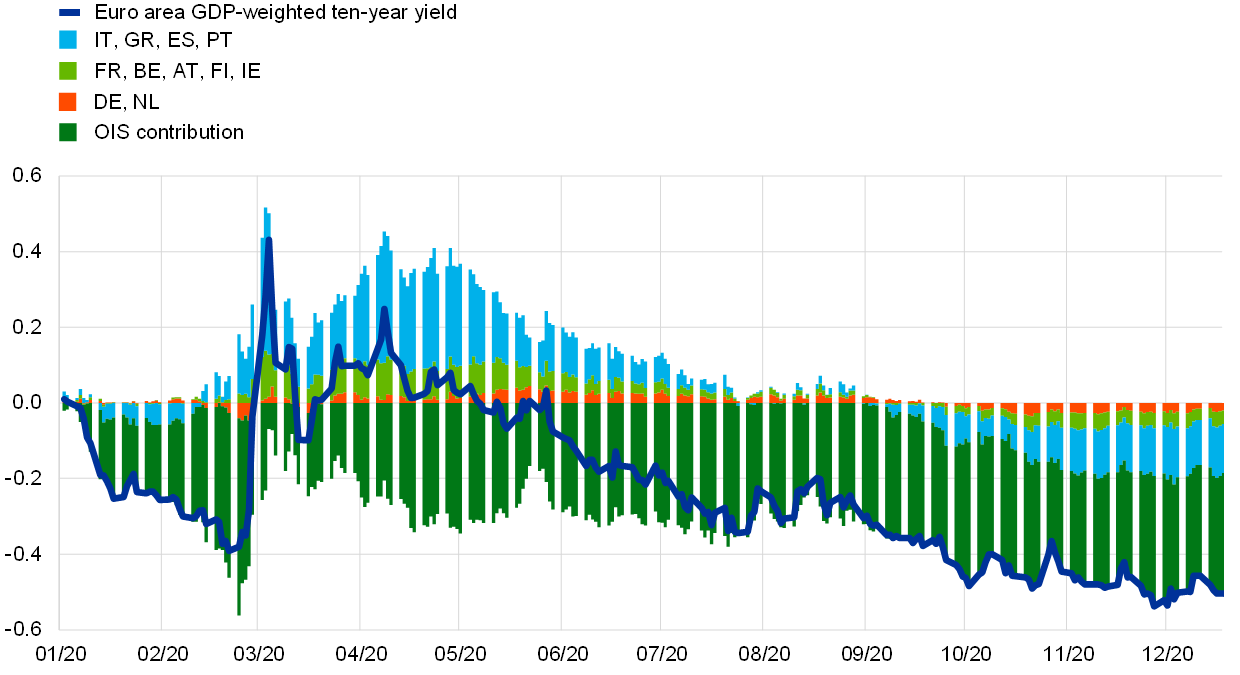
Notes: The latest observations are for 31 December 2020. OIS: overnight index swap.
Chart 16
Composite cost of debt financing for banks
(composite cost of deposit and unsecured market-based debt financing; percentages per annum)
Sources: ECB, Markit iBoxx and ECB calculations.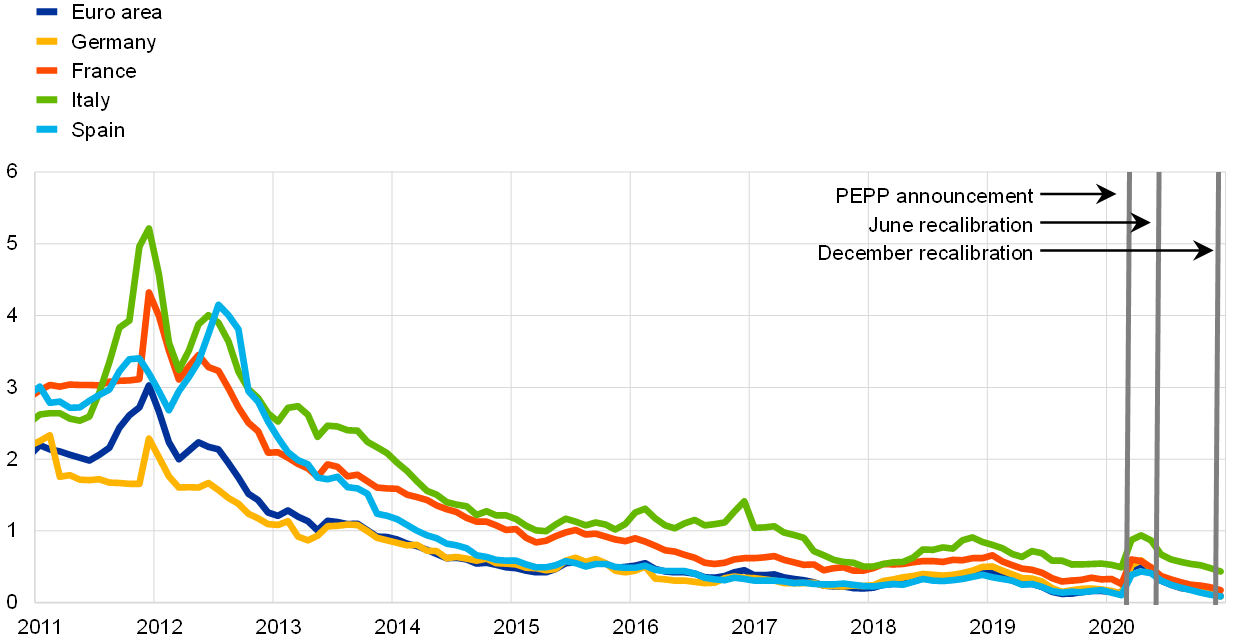
Notes: The composite cost of deposits is calculated as an average of new business rates on overnight deposits, deposits with an agreed maturity and deposits redeemable at notice, weighted by their corresponding outstanding amounts. The latest observations are for December 2020.
Chart 17
Composite bank lending rates for non-financial corporations and households
(percentages per annum)
Source: ECB.
Notes: Composite bank lending rates are calculated by aggregating short and long-term rates using a 24-month moving average of new business volumes. The latest observations are for December 2020.
2.2 Eurosystem balance sheet dynamics in challenging times

Since the onset of the global financial crisis in 2007-08, the Eurosystem has taken a variety of standard as well as non-standard monetary policy measures, which have had a direct impact on the size and composition of the Eurosystem’s balance sheet over time. The non-standard measures have included refinancing operations to provide funding to counterparties with an initial maturity of up to four years, as well as purchases of assets issued by private and public entities (under the APP). In 2020, in response to the outbreak of COVID-19 and in addition to the already existing non-standard measures, the ECB adopted a comprehensive package of complementary monetary policy measures, which had a significant impact on the Eurosystem’s balance sheet. In March 2020 the ECB added a temporary additional envelope for 2020 to the APP and launched the PEPP, which both resulted in an increase in the holdings of assets purchased outright. In addition, between March and April 2020, the ECB eased its TLTRO III conditions (twice) and amended the collateral as well as the risk control frameworks. These complementary measures together resulted in a sizeable increase in Eurosystem intermediation.[16] Overall, during 2020 the Eurosystem’s balance sheet continued to grow on account of these non-standard policy measures, which injected €2.2 trillion of additional liquidity into the banking system, and by the end of 2020 its size had reached a historical high of €7 trillion, an increase of 49% (€2.3 trillion) compared with the end of 2019.
At the end of 2020 monetary policy-related assets amounted to €5.5 trillion, accounting for 79% of the total assets on the Eurosystem’s balance sheet (up from 70% at the end of 2019). These monetary policy-related assets include loans to euro area credit institutions, which accounted for 26% of total assets (up from 13% at the end of 2019), and assets purchased for monetary policy purposes, which represented around 53% of total assets (down from 56% at the end of 2019) (see Chart 18). Other financial assets on the balance sheet mainly consisted of foreign currency and gold held by the Eurosystem and euro-denominated non-monetary policy portfolios.
On the liabilities side, the overall amount of counterparties’ reserve holdings and recourse to the deposit facility increased to €3.5 trillion (up from €2 trillion at the end of 2019) and represented 50% of the liabilities side at the end of 2020 (up from 39% at the end of 2019). Banknotes in circulation grew at a rate above the historical growth trend due to a strong increase in March 2020 and accounted for 21% of liabilities at the end of 2020 (down from 28% at the end of 2019). Other liabilities, including capital and revaluation accounts, increased to €2.1 trillion (up from €1.6 trillion at the end of 2019) and accounted for 30% (down from 34% at the end of 2019) (see Chart 18). The increase in other liabilities mainly came from an increase in government deposits from €0.2 trillion to €0.5 trillion, accounting for 25% of other liabilities (up from 11% at the end of 2019).
Chart 18
Evolution of the Eurosystem’s consolidated balance sheet
(EUR billions)
Source: ECB.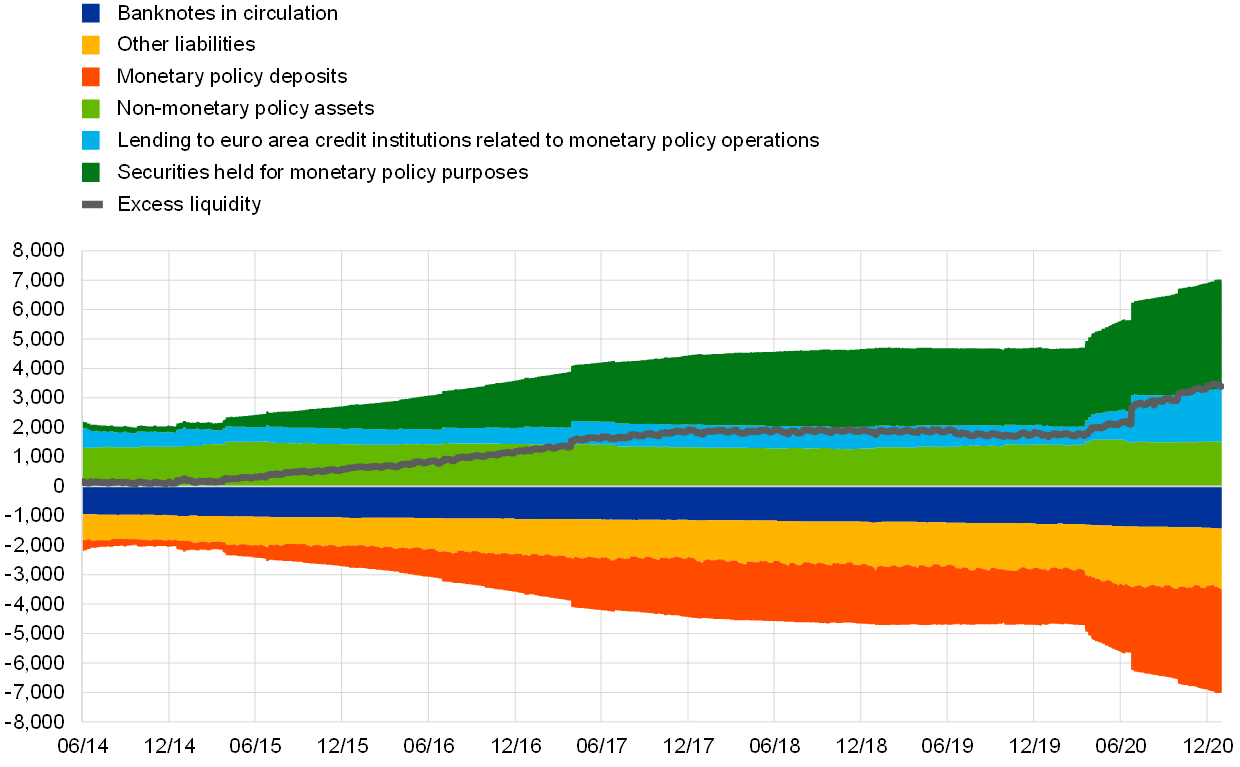
Notes: Positive figures refer to assets and negative figures to liabilities. The line for excess liquidity is presented as a positive figure, although it refers to the sum of the following liability items: current account holdings in excess of reserve requirements and recourse to the deposit facility.
APP and PEPP portfolio maturity and distribution across asset classes and jurisdictions
The APP comprises four active asset purchase programmes: the third covered bond purchase programme (CBPP3), the asset-backed securities purchase programme (ABSPP), the public sector purchase programme (PSPP) and the corporate sector purchase programme (CSPP). The PEPP was introduced in 2020 and all asset categories that are eligible under the APP are also eligible under the PEPP. A waiver of eligibility requirements for purchases under the PEPP was granted for debt securities issued by the Hellenic Republic. In addition, in March 2020, the eligibility of non-financial commercial paper under the CSPP was expanded to include securities with a remaining maturity of at least 28 days.
At the end of 2020 APP holdings amounted to €2.9 trillion
At the end of 2020 APP holdings amounted to €2.9 trillion (at amortised cost). The ABSPP accounted for 1% (€29 billion), the CBPP3 for 10% (€288 billion) and the CSPP for 9% (€250 billion) of total APP holdings at the year-end. Out of the private sector purchase programmes, the CSPP contributed the most to the growth in APP holdings in 2020, with €66 billion of net purchases. CSPP purchases are made based on a benchmark which reflects the market capitalisation of all eligible outstanding corporate bonds.
The PSPP accounted for 80% of total APP holdings
The PSPP accounted for the bulk of the APP holdings, amounting to €2.3 trillion or 80% of total APP holdings at the end of 2020, down from 82% at the end of 2019. Under the PSPP, the allocation of purchases to jurisdictions was guided by the ECB’s capital key on a stock basis. In addition, some national central banks (NCBs) purchased securities issued by EU supranational institutions. The weighted average maturity of the PSPP holdings stood at 7.3 years at the end of 2020, somewhat higher than the 7.12 years at the end of 2019, with some variation across jurisdictions.[17]
At the end of 2020 PEPP holdings amounted to €753.7 billion
At the end of 2020 PEPP holdings amounted to €753.7 billion (at amortised cost). The covered bond holdings accounted for less than 1% (€3.1 billion), the corporate sector holdings for 6% (€43.2 billion) and the public sector holdings for 94% (€707.4 billion) of total PEPP holdings at the year-end.
For the purchases of public sector securities under the PEPP, the benchmark, on a stock basis, for allocation across jurisdictions is the NCBs’ contributions to the ECB’s capital. At the same time, purchases were conducted in a flexible manner, which led to fluctuations in the distribution of purchase flows over time, across asset classes and among jurisdictions. The weighted average maturity of the PEPP public sector securities holdings stood at 7.0 years at the end of 2020, with some differences across jurisdictions.
The Eurosystem reinvested the principal payments from maturing securities held in the APP and PEPP portfolios. Redemptions under the private sector purchase programmes amounted to €80.2 billion in 2020, while redemptions under the public sector purchase programmes amounted to €229.4 billion. The assets purchased under the PSPP, CSPP and CBPP3 continued to be made available for securities lending[18] in order to support bond and repo market liquidity.[19] PEPP holdings are also available for securities lending under the same conditions as under the APP. In November 2020 the Eurosystem adjusted the pricing conditions of its securities lending facilities, making them more favourable for counterparties and ensuring that they remain an effective backstop.
Developments in Eurosystem refinancing operations
The outstanding amount of Eurosystem refinancing operations increased by €1.2 trillion since the end of 2019, standing at €1.8 trillion at the end of 2020. This can be largely attributed to the €1.75 trillion allotted in the TLTRO III series, in addition to the €26.6 billion allotted in the PELTROs. The voluntary repayments of €192 billion and the maturity of €303 billion of the TLTRO II series only to a small extent counterbalanced the increase in outstanding operations. Banks were given the opportunity to roll over previous TLTRO outstanding amounts in the June, September and December 2020 TLTRO III operations. The weighted average maturity of outstanding Eurosystem refinancing operations increased from around 1.2 years at the end of 2019 to around 2.4 years at the end of 2020.
The ECB’s collateral easing measures
The ECB’s temporary collateral easing measures announced in April 2020 and extended in December 2020 were a core element of the ECB’s monetary policy response to the pandemic. A central element of these measures was to temporarily expand the acceptance of credit claims as collateral, in particular through the potential expansion of the additional credit claim (ACC) frameworks. Under the revised temporary framework, NCBs are permitted to accept as collateral, among other things, loans to small and medium-sized enterprises or self-employed individuals that benefit from COVID-19-related government guarantee schemes.
To avoid potential procyclical dynamics of rating downgrades, the Governing Council in addition decided to temporarily maintain the eligibility of marketable assets and the issuers of such assets that fulfilled minimum credit quality requirements on 7 April 2020. In particular, the Eurosystem continues to accept as collateral marketable assets that were eligible for liquidity operations on the reference day, provided that the rating remains above a certain credit quality level and all other eligibility requirements are still fulfilled.
Furthermore, the ECB decided on a temporary general reduction of collateral valuation haircuts by a fixed proportion of 20% across all eligible collateral asset categories, thereby temporarily tolerating more risk on the Eurosystem’s balance sheet. In addition, the Governing Council decided to increase the concentration limit for unsecured bank bonds from 2.5% to 10% and lowered the level of the non-uniform minimum size threshold for domestic credit claims to €0 from €25,000 to facilitate the mobilisation as collateral of loans to small corporate entities. As part of its policy response to the economic shock from the pandemic, the Governing Council also decided to temporarily waive the minimum rating requirement for marketable debt securities issued by the Hellenic Republic.
The amount of marketable eligible assets increased by €1,493 billion, reaching a level of €15,657 billion at the end of 2020 (see Chart 19). Central government securities continued to be the largest asset class (€8,385 billion). Other asset classes encompass unsecured bank bonds (€1,667 billion), covered bonds (€1,640 billion) and corporate bonds (€1,872 billion). Regional government bonds (€552 billion), asset-backed securities (€584 billion) and other marketable assets (€958 billion) each accounted for a comparatively small fraction of the universe of eligible assets.
Chart 19
Developments in eligible collateral
(EUR billions)
Source: ECB.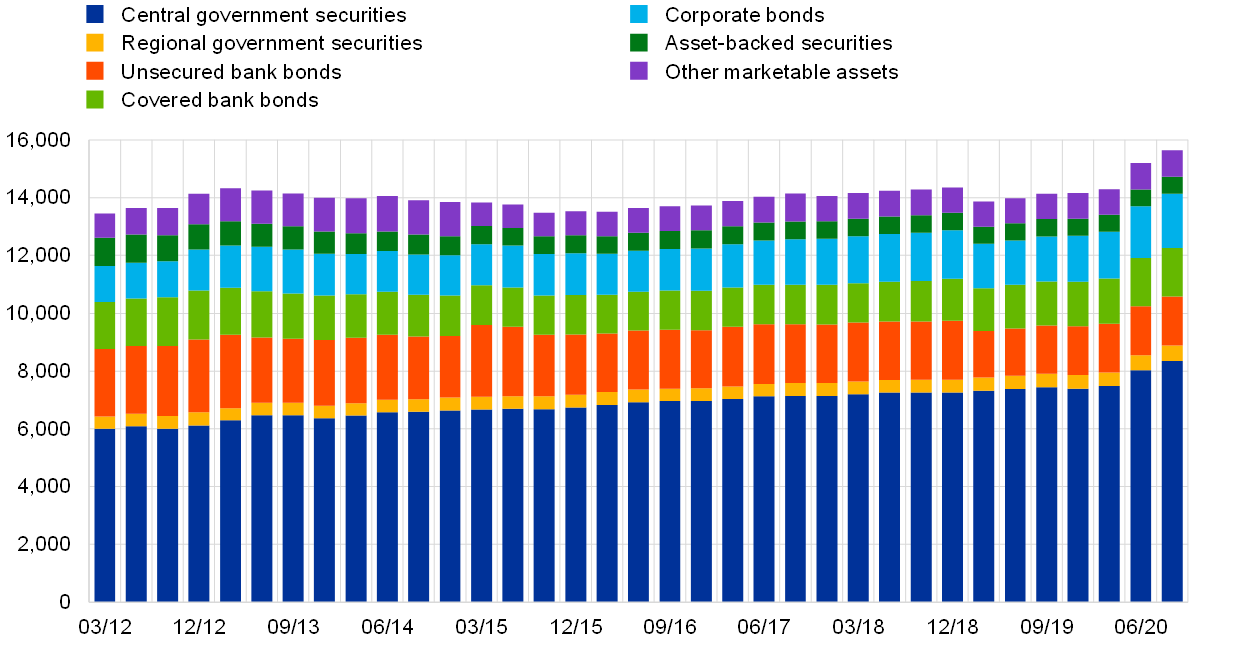
Notes: Collateral values are nominal amounts. The averages of end-of-month data for each time period are shown.
The amount of mobilised collateral increased considerably from €1,543 billion to €2,595 billion (see Chart 20). The increase can largely be attributed to credit claims (including additional credit claims), for which mobilised amounts more than doubled from €378 billion to €825 billion. Covered bank bonds represented the second most important asset class (€629 billion) with respect to their use as collateral. Central government bonds (€383 billion) and asset-backed securities (€387 billion) also represented important sources of mobilised collateral. Unsecured bank bonds, regional government bonds and corporate bonds were used to a lesser extent, i.e. €145 billion, €90 billion and €78 billion, respectively.
Chart 20
Developments in mobilised collateral
(EUR billions)
Source: ECB.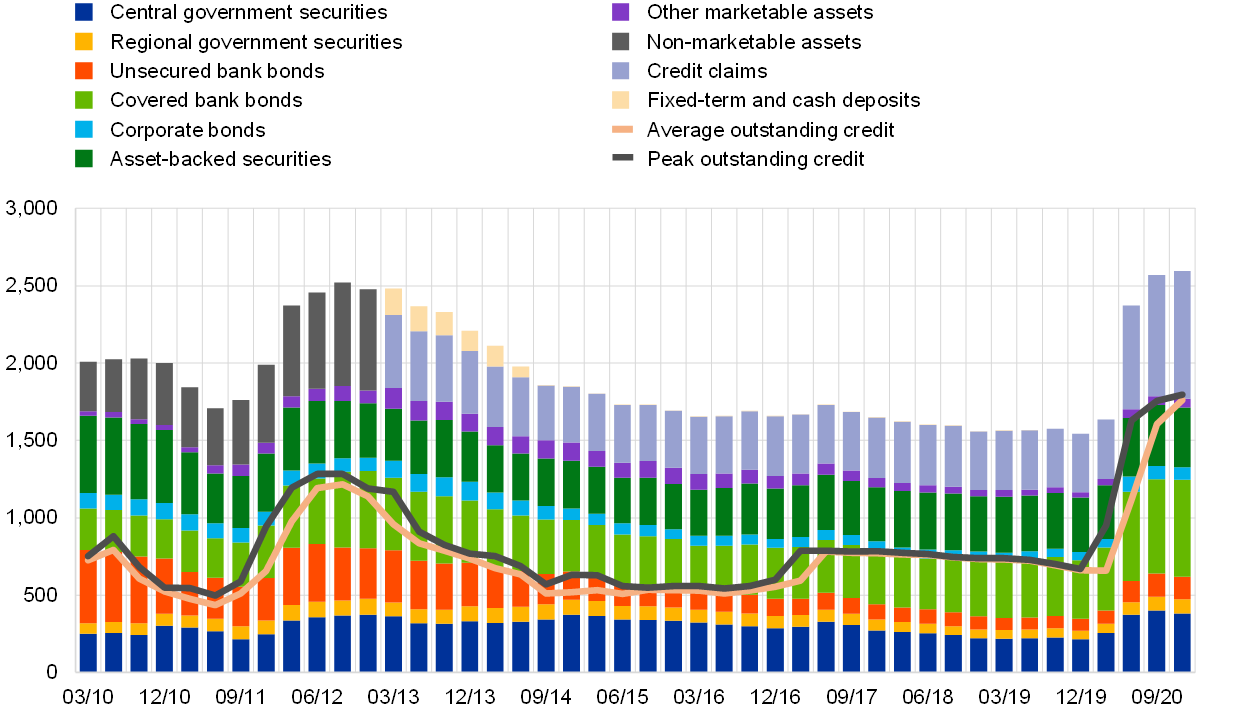
Notes: Since the first quarter of 2013 “non marketable-assets” have been split into “credit claims” and “fixed-term and cash deposits”. For collateral, the averages of end-of-month data for each time period are shown, and values are after valuation and haircuts. For credit, daily data are used.
2.3 Financial risks associated with the PEPP and APP are mitigated through appropriate frameworks
The APP and PEPP are complementary tools with distinct policy objectives
The main objective of the net asset purchases under the APP is to support the robust convergence of inflation towards the Governing Council’s medium-term aim. The APP was complemented by the PEPP, which aims to counter the serious risks to the monetary policy transmission mechanism and to the outlook for the euro area economy posed by the COVID-19 pandemic.
Risk efficiency is a key principle of the Eurosystem’s risk management function
All monetary policy instruments, including outright asset purchases, inherently involve financial risks, which are managed and controlled by the Eurosystem. When there are several implementation options to fulfil the policy objectives, the option selected should be efficient both from an operational as well as from a risk perspective. In that context, the Eurosystem’s risk management function endeavours to attain risk efficiency: achieving the policy objectives with the lowest amount of risk for the Eurosystem.[20]
Outright asset purchases require specific risk control frameworks
The outright asset purchases require specific financial risk control frameworks which depend on the policy objectives and on the features and risk profiles of the asset types involved. Each of these frameworks consists of eligibility criteria, credit risk assessments and due diligence procedures, pricing frameworks, benchmarks and limits. The APP and PEPP risk control frameworks apply to the purchase of additional assets, the reinvestment of principal payments from maturing holdings, and the holdings for as long as they remain on the Eurosystem’s balance sheet.
The risk control frameworks not only serve the purpose of mitigating financial risks, but also contribute to the successful achievement of the policy objectives by steering, as much as possible within the given objective, the asset purchases towards a diversified market-neutral asset allocation. In addition, the design of the risk control frameworks also takes into consideration non-financial risks such as legal, operational and reputational risks.
In the following, the current financial risk control frameworks governing the implementation of the APP and PEPP are described.[21] Table 1 summarises the key elements of the applicable frameworks.
Table 1
Key elements of the risk control frameworks for the APP and PEPP

Source: ECB.
Notes: ABS: asset-backed security; CAC: collective action clause; CQS: credit quality step as per the Eurosystem’s harmonised rating scale (see the Eurosystem credit assessment framework).
1) ABSs rated below credit quality step 2 have to satisfy additional requirements, which include: (i) no non-performing loans backing the ABS at issuance or added during the life of the ABS; (ii) the cash-flow-generating assets backing the ABSs must not be structured, syndicated or leveraged; and (iii) servicing continuity provisions must be in place.
2) See the “Implementation aspects of the public sector purchase programme (PSPP)” page on the ECB’s website.
Eligibility requirements for outright asset purchases
Eligibility criteria apply to all asset classes
In principle, only marketable assets which are accepted as collateral for Eurosystem credit operations are potentially eligible for outright asset purchases. The collateral eligibility criteria for Eurosystem credit operations are stated in the general framework for monetary policy instruments. Among other things, eligible assets are required to meet high credit quality standards by having at least one credit rating[22] provided by an external credit assessment institution (ECAI) accepted within the Eurosystem credit assessment framework (ECAF) qualifying as credit quality step 3 (CQS 3) of the Eurosystem’s harmonised rating scale or higher (CQS 1 and CQS 2). For marketable debt securities issued by the Hellenic Republic, this requirement is temporarily waived for purchases under the PEPP and the emergency collateral easing measures in response to the COVID-19 pandemic. Furthermore, assets must be euro-denominated and issued and settled in the euro area.
In addition to the eligibility criteria above, specific eligibility criteria apply depending on the purchase programme. For instance, for the PSPP, CSPP and PEPP, there are minimum and maximum maturity restrictions in place. For the CSPP, assets issued by credit institutions, or by issuers for which the parent undertaking is a credit institution, are not eligible for purchase. Moreover, for the CSPP, CBPP3 and ABSPP, assets issued or originated by wind-down entities and asset management vehicles are excluded from purchases. In the CBPP3, the assets must fulfil the necessary conditions for their acceptance as own-use collateral for Eurosystem credit operations, i.e. they can be used as collateral by the issuing credit institution.[23] In the case of asset-backed securities, the debtors underlying the respective claims must be predominantly located in the euro area.
Credit risk assessments and due diligence procedures
Credit risk assessments and due diligence procedures are conducted on an ongoing basis
For the private sector purchase programmes, the Eurosystem conducts appropriate credit risk assessments and due diligence procedures on the purchasable universe on an ongoing basis. Monitoring frameworks are maintained using certain risk indicators. These assessments and procedures follow the principle of proportionality, where riskier assets are subject to more in-depth analysis. If warranted, additional risk management measures may apply, also subject to the principle of proportionality. These include, in particular, limitations on or the suspension of purchases and, in extraordinary cases, even sales of assets, which require a case-by-case assessment by the Governing Council.
Pricing frameworks
The pricing frameworks ensure that purchases are made at market prices
The pricing frameworks for the APP and PEPP ensure that purchases are made at market prices in order to minimise market distortions and facilitate the achievement of risk efficiency. These frameworks take into account available market prices, the quality of such prices and fair values. Ex post price checks are also conducted in order to assess whether the transaction prices reflected market prices at the time of the transactions.
Purchases of eligible debt instruments with a negative yield to maturity are permissible in all asset purchase programmes including, to the extent necessary, those with a yield below the deposit facility rate.
Benchmarks
Benchmarks are used to ensure diversification
Benchmarks are used to ensure the build-up of a diversified portfolio and contribute to mitigating risks. The benchmarks for the private sector purchase programmes are guided by the market capitalisation of the purchasable universe, i.e. the nominal outstanding amounts of the eligible assets satisfying risk considerations. In the case of purchases of public sector securities under the PSPP and PEPP, the ECB’s capital key guides the allocation of purchases per jurisdiction on a stock basis. That being said, purchases under the PEPP are carried out in a flexible manner allowing for fluctuations in the distribution of purchase flows over time, across asset classes and among jurisdictions.
Limits
Issue and issuer limits are an effective tool to limit risk concentration
Limit frameworks are in place for the APP. The calibration of issue share and issuer limits[24] takes into account policy, operational, legal and risk management considerations. The limits are fine-tuned according to the asset class, with a distinction being made between public sector assets and private sector assets. Upon the announcement of the PEPP, the Governing Council made clear that to the extent that some self-imposed limits might hamper action that the Eurosystem is required to take in order to fulfil its mandate, the Governing Council would consider revising them to the extent necessary to make its action proportionate to the risks faced.
PSPP issue share and issuer limits are applied to safeguard market functioning and price formation, to ensure proportionality, to limit risk concentration and to ensure that the Eurosystem does not become a dominant creditor of euro area governments. The issue share limit for PSPP-eligible supranational bonds is 50% of the outstanding amount of the asset issued. For all other PSPP-eligible bonds, the issue share limit is set at 33% of the outstanding amount of the issue, subject to a case-by-case verification that it would not lead to the Eurosystem having a blocking minority for the purpose of collective action clauses. Otherwise, the issue share limit is 25%. The issuer limit for supranational issuers is set at 50% of the outstanding amount of eligible assets issued by the respective institution; for other eligible issuers, it is 33%.
For the ABSPP, CBPP3 and CSPP, Eurosystem holdings per issue must not exceed 70%. In the CSPP, lower issue share limits apply in specific cases, for example for assets issued by public undertakings, which are dealt with in a manner consistent with the treatment under the PSPP. In addition to these issue share limits, issuer limits are applied for the CBPP3 and CSPP. For the CSPP, the issuer limits are defined based on a benchmark allocation related to an issuer group’s market capitalisation in order to ensure a diversified allocation of purchases. Moreover, lower limits may apply if warranted based on the outcome of the credit risk assessment and due diligence procedures, as explained above.
Box 2
The review of the ECB’s monetary policy strategy
A monetary policy strategy starts from the policy objectives adopted by and/or assigned to monetary authorities, sets out how to achieve these objectives and refers to an appropriate set of monetary policy instruments, indicators and intermediate targets. A monetary policy strategy serves two basic purposes: first, it provides policymakers with a coherent analytical framework that maps actual or expected economic developments into policy decisions; second, it also serves as a vehicle for communicating with the public. When viewed over longer spans of time, monetary policy strategies have always evolved gradually in line with theoretical and empirical advancements and experience, but also reflecting the predominant policy challenges of the times.
The main guideposts of the ECB’s current monetary policy strategy are built on the ECB’s initial price stability-oriented strategy announced in 1998 and refined in the last strategy review of 2003.[25] This strategy is designed to maintain price stability in the euro area, thereby fulfilling the mandate given to the European System of Central Banks by the Treaty establishing the European Community. Assigning a primary objective of price stability to an independent central bank is rooted in the conviction that a monetary policy that maintains price stability in a credible and lasting way will make the best overall contribution to improving economic prospects and raising living standards.
Since 2003, when the ECB last conducted a strategy review, the euro area and world economies have undergone profound changes. The last decade has been characterised by a persistent decline in inflation and equilibrium interest rates, reflecting secular and still ongoing influences from globalisation, digitalisation and population ageing, reinforced by the legacy of the financial crisis. The existence of ultra-low interest rates has made it harder for central banks to ease monetary policy when inflation is below target and economic growth is weak. The implementation of negative policy interest rates has brought the ECB and other central banks closer to an effective lower bound on these rates, a limit beyond which further interest rate cuts are expected to lose their ability to provide additional economic stimulus. In this context, many central banks, like the ECB, have expanded their set of policy instruments, for instance by adopting asset purchase programmes and providing new forms of long-term financing of the banking sector. Last but not least, climate change has recently surfaced as an ominous and pervasive threat to future economic and societal well-being across the globe, and the likely implications for monetary policy still have to be worked out.
Against this background, the Governing Council launched a strategy review in January 2020. The aim of the review is to thoroughly analyse the forces that are driving all these structural developments, and to consider whether and how the ECB should adjust its monetary policy strategy in response, to make sure it remains fit for purpose. The review takes the mandate assigned by the Treaty as given. Due to the pandemic, the review has been somewhat delayed and is expected to be concluded in the second half of 2021.
Scope and process of the review
In principle, the strategy review covers all relevant aspects of the ECB’s monetary policy within its mandate. The topics can be grouped according to the ECB’s primary objective and other relevant considerations. In relation to the primary objective, elements to be studied and discussed are: How to best measure inflation? What drives inflation developments? How effective and efficient are the ECB’s monetary policy instruments, both individually and in combination, in steering inflation? How to quantify the price stability objective? How to best communicate about monetary policy? Regarding other relevant considerations, the main issue is to what extent and under which conditions can monetary policy also take into account developments in the real economy (i.e. the business cycle and employment conditions), risks to financial stability and environmental sustainability (climate change) considerations when a price stability-oriented policy is pursued. In this context, the review also covers the interactions of monetary policy with fiscal and macroprudential policies. In order to deepen understanding of all these key issues, the ECB has set up 13 work streams (see Figure A). In these work streams, Eurosystem staff members from the ECB and national central banks (NCBs) are closely collaborating, with the aim of jointly preparing the analysis supporting the debates within the Governing Council.
Figure A
ECB strategy review work streams
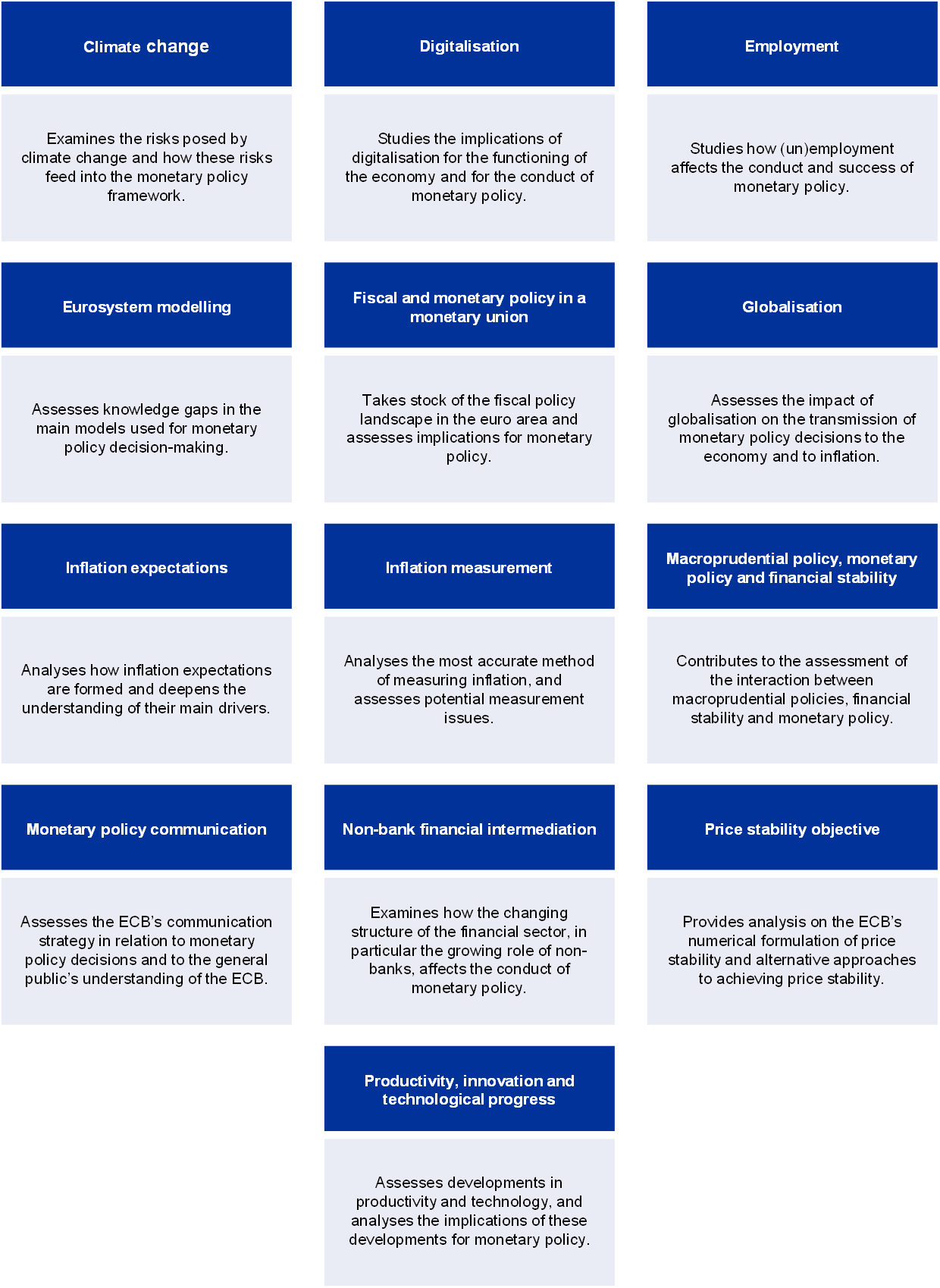
Source: ECB.
Listening as a key element of the review process
To ensure a broad understanding of and support for its monetary policy strategy, the ECB invited a comprehensive range of stakeholders to provide their input into the strategy review process. For this purpose, the ECB organised a number of exchanges and listening activities. The strategy review featured prominently in regular and ad hoc exchanges with Members of the European Parliament. There were also dedicated sessions with the academic community, and the strategy review became a key theme of numerous conferences and seminars with academia, market participants, the central banking community and the media, including the flagship ECB Forum on Central Banking.
Citizens were offered the possibility to submit their views through the ECB Listens Portal. Over a period of eight months, some 4,000 citizens submitted their views, which were compiled in a report and submitted to the Governing Council for consideration. Issues that citizens touched upon included price stability and its meaning in daily life, a broad set of economic issues, ranging from inequality, savings and pensions, as well as unemployment and job precariousness, to the economic outlook, and climate change.
The strategy review also served as a trigger to further enhance the ECB’s relations with non-governmental organisations. In this vein, the first “ECB Listens” event was hosted by the ECB President Christine Lagarde and Executive Board member Philip R. Lane on 21 October 2020. This virtual event brought together 22 representatives from 18 civil society organisations, active in nine different sectors. Several organisations noted that the current crisis presents an opportunity to overhaul the ECB’s monetary policy strategy, taking into consideration public and civil society concerns. A summary of the input provided by civil society organisations is available on the ECB’s website. The input received, together with contributions from other listening activities, is feeding into the ongoing deliberations of the Governing Council.
The ECB and NCBs will continue organising listening activities throughout the strategy review process, but also beyond, with the aim of engaging with all stakeholders to ensure a broad understanding of the new monetary policy strategy that will emerge from it.
The financial stability environment was significantly affected by the spread of the COVID-19 pandemic during 2020. Not only was the pandemic a public health crisis, it also led to a sharp increase in financial stability vulnerabilities across markets and sectors. Extensive policy support measures were adopted by central banks, governments and other authorities, which helped to contain immediate financial stability risks. Medium-term vulnerabilities nevertheless remained elevated, with a growing vulnerability to asset price corrections, rising debt servicing challenges for firms, households and sovereigns, a further weakening of bank profitability, as well as credit and liquidity risks for non-banks, being the main concerns. In this environment, the ECB took actions to mitigate the financial shocks arising from the pandemic. In particular, macroprudential policy measures focused on maintaining the flow of credit to the economy, while the ECB Banking Supervision microprudential measures focused on mitigating the impact of the crisis and promoting the resilience of the European banking sector. In 2020 the ECB continued to contribute to structural issues, including completing the capital markets union and addressing the increasing challenges that climate risk can pose to the euro area financial system.
3.1 The financial stability environment in 2020
Challenging financial stability environment for banks and non-banks
The coronavirus pandemic amplified existing financial stability vulnerabilities, which were identified by the ECB in previous years. The pandemic, the uncertainty surrounding its future path and its impact on economic prospects and the indebtedness of sovereigns, corporates and households were the key factors influencing financial stability risks in 2020. The economic impact of the crisis across the euro area countries has been very significant, with heterogeneous effects on value-added growth across countries and sectors, amid a pronounced increase in corporate and sovereign indebtedness, in particular in countries with pre-existing high debt levels. An uneven recovery across sectors and countries increased risks of fragmentation. Banks also faced higher risks, reflecting the prospect of deteriorating asset quality linked to the drop in economic activity. Outside the banking sector, investment funds, including money market funds, experienced in March outflows of a magnitude last seen during the global financial crisis, which amplified the market turmoil. Funds had become increasingly vulnerable to large-scale outflows, as they had turned to riskier and more illiquid assets over the last years, encouraged by the low-yield environment. Insurers too sought to boost their returns in a particularly challenging environment characterised by low interest rates and increasing claims stemming from the pandemic.
Four key financial stability vulnerabilities were identified
In the near term, financial stability risks resulting from the pandemic were contained by massive and timely policy support. The importance of policy measures in containing the economic and financial stability impact of the pandemic makes managing the exit from this support equally important. During 2020 four key financial stability vulnerabilities for the euro area over a two-year horizon were identified by the ECB and discussed in the ECB’s semi-annual Financial Stability Review (see Figure 1):
Figure 1
Key financial stability vulnerabilities in the euro area

Source: ECB.
Notes: Financial stability assessment as at 25 November 2020. ROE: return on equity.
- First, strength in asset prices and renewed risk-taking made some markets increasingly susceptible to corrections. Following the March turmoil, a notable but uneven rebound in financial markets over the summer contrasted with weak economic fundamentals, with investors potentially giving more weight to the more contained downside economic risks as the year progressed and the deployment of economic policy support measures. In particular, the buoyancy of some equity markets led to some concern about a disconnection from underlying economic fundamentals. Credit spreads fell back to pre-pandemic levels across the rating spectrum and appeared tight in view of the economic outlook, particularly for the high-yield segment of the corporate bond market.
- Second, vulnerabilities increased in the non-financial private and public sectors. Governments across the euro area deployed a wide range of fiscal support measures in response to the pandemic, which entailed sizeable budget deficits in 2020. At the same time, firms drew down on credit lines and issued large amounts of bonds to meet liquidity needs. Higher sovereign and corporate debt levels could therefore give rise to renewed debt sustainability concerns in the future. Household balance sheets were affected modestly by the pandemic thanks to government income support schemes. However, an abrupt ending of measures could lead to a reduced debt servicing capacity of households and a further weakening of already fragile corporate fundamentals. The risk of a correction in residential and commercial property markets also rose during 2020, with increasingly visible signs of overvaluation for the euro area as a whole, and an abrupt and sustained drop in activity in the commercial property market.
- Third, euro area banks faced a combination of growing asset quality concerns, persistent structural problems and ongoing pressures on profitability. Bank profitability was expected to remain weak and to recover only very gradually to levels seen before the outbreak of the pandemic. Furthermore, initial signs of a deterioration in asset quality were observed during 2020, which will eventually translate into credit losses and non-performing loans.
- Fourth, vulnerabilities continued to build up in the non-bank financial sector as a result of renewed risk-taking. Following a return of inflows to euro area investment funds, they reduced the share of liquid asset holdings and increased their longer-duration and lower-rated non-financial corporate debt exposures. This left investment funds vulnerable to large outflows in the event of possible future turmoil. At the same time, insurers faced profitability challenges arising from lower underwriting volumes and higher claim provisions stemming from both the pandemic and a relatively high number of natural catastrophes in 2020.
The potential for these vulnerabilities to materialise simultaneously and possibly amplify each other further increases the risks to financial stability.
Longer-term risks should not be forgotten
Other vulnerabilities beyond the short-to-medium-term horizon with a potential negative impact on the financial sector were also highlighted by the ECB during 2020, notably the financial stability risks posed by climate change (see Box 3) and operational risks stemming from cyber vulnerabilities.
Box 3
The ECB and climate change
Addressing the challenges implied by the impact of climate change has become a central priority for policymakers around the world – including for central banks. The potential consequences of physical and transition risks stemming from climate change are broad, thus affecting a wide range of areas of work, also within the ECB and ECB Banking Supervision. The ECB is exploring all possible ways in which it could contribute to limiting risks from climate change within its mandate. In this context, the ECB has recently created a climate change centre in order to shape and steer the ECB’s climate agenda, taking into consideration all perspectives relevant to central banking.
The ECB’s contribution to policy discussions on climate change
The impact of climate change is closely monitored by ECB staff from multiple angles. Work has started to incorporate climate risks into the ECB’s models and forecasting methods, and to assess their consequences for the conduct of monetary policy, for financial stability, as well as for the ECB’s own investment portfolios. Green bonds have gained importance in the ECB’s asset purchase programmes, and new types of climate-related financial instruments are being closely monitored. Supervisors are also actively engaging with banks to raise awareness of risks emerging from climate change to ensure that those risks are properly accounted for and managed in banks’ strategies. Against this background, this box provides an overview of the main areas of work at the ECB on this cross-cutting topic, that is, in the core policy areas of financial stability and prudential policy, macroeconomic analysis and monetary policy, financial market operations and risk management, financial market infrastructures and payments, research and statistics, as well as EU policy and financial regulation. The main activities ongoing internally, within the Eurosystem and in international fora are described, also highlighting the work ahead and the main challenges that ECB staff will focus on over the coming years.
Regarding financial stability, the ECB is working with the Financial Stability Committee of the European System of Central Banks (ESCB), in close collaboration with the European Systemic Risk Board (ESRB), on state-of-the-art climate risk monitoring and assessment. This work builds on an initial first year of work, the results of which were published in an ESRB report in June 2020. In its second year of existence, the project team aims to develop a risk monitoring dashboard for financial intermediaries, as well as to explore new modelling approaches to capture the long-term trade-offs of climate risks. Financial intermediaries’ exposures to climate-related risks continued to be analysed in dedicated boxes in the ECB’s Financial Stability Review. The ECB is also developing a top-down, economy-wide climate stress test, based on extremely granular information on firms’ vulnerability to climate risks and banks’ exposures. This exercise will inform the public debate on the materiality of transition and physical risks over a 30-year horizon based on forward-looking scenarios, and will also lay the foundations for eventual macroprudential policy measures in this field.
ECB Banking Supervision published the ECB Guide on climate-related and environmental risks in November 2020, setting out its supervisory expectations under the current prudential framework. It describes how the ECB expects institutions to consider climate-related and environmental risks when formulating and implementing their business strategy and governance and risk management frameworks. It furthermore explains how the ECB expects institutions to become more transparent by enhancing their climate-related and environmental disclosures. Moreover, the ECB assessed the climate-related and environmental risk disclosures of all institutions under its direct supervision. While there has been some improvement since the previous year, the report finds that disclosure statements are only sparsely substantiated with relevant quantitative and qualitative information and that most institutions do not yet comprehensively disclose their risk profile.
The ECB is moreover working on the macroeconomic impact of climate risks. In particular, work is ongoing to investigate the macroeconomic risks stemming directly from climate change, and from policies aiming at climate risk mitigation and adaptation. ECB staff are also assessing the need for the adaptation of macroeconomic models and the macroeconomic projections supporting monetary policy decisions. The ECB has been analysing the macroeconomic implications of climate change for the conduct of monetary policy. The focus was on the implications of climate change and related transition policies for: (i) the transmission of monetary policy and credit provision; (ii) the natural rate of interest and the monetary policy space; and (iii) the conduct of monetary policy in a context of heightened intensity and volatility of macroeconomic shocks. In the context of the monetary policy strategy review, attention has also been devoted to how climate change might affect the conduct of monetary policy, taking into account the remit to maintain price stability and to support the general economic policies in the Union, with a view to contributing to the achievement of the Union’s objectives foreseen in Article 3 of the Treaty on European Union. Moreover, Article 11 of the Treaty on the Functioning of the European Union provides that environmental protection requirements must be integrated into the definition and implementation of Union policies and activities, in particular with a view to promoting sustainable development.
The ECB is also reflecting on how to address climate change considerations within the Eurosystem monetary policy implementation and risk management frameworks. This analysis hinges on improving the available information on the exposure of economic agents to climate change-related risks and opportunities. The currently available data are however inconsistent, largely incomparable and at times unreliable. The ECB has therefore been calling for more standardised and widespread disclosures of climate-related information. In this context, the ECB, as a user of credit ratings, is also interested in understanding how climate change risks are incorporated into the respective rating processes. While acknowledging that credit rating agencies have taken some steps towards the incorporation of environmental risks into credit ratings, there is still significant room for improvement, especially related to the disclosure of the relevance and materiality of climate change risks in credit ratings.
In its staff pension fund, which is passively managed by two external asset managers, the ECB pursues a broad sustainable and responsible investment (SRI) policy based on selective exclusion and proxy voting guidelines that incorporate environmental, social and governance standards. In 2020 all conventional equity benchmark indices tracked by the staff pension fund were replaced with their low-carbon equivalents, which significantly reduced the carbon footprint of the equity portfolios. Going forward, the ECB aims to explore the possible expansion of low-carbon indices to fixed income asset classes. In its own funds portfolio, the ECB applies a thematic SRI strategy that targets an increase of the share of green securities. This strategy is being progressively implemented by means of direct purchases of green bonds in secondary markets, to be complemented by exposures obtained through other investment vehicles.
High-quality climate-related statistics and data are a necessary precondition to allow an informed analysis of climate change topics and the related risks relevant for central banking purposes. To address those needs, the ESCB Statistics Committee prepared a systematic overview of the existing data sources, user needs, methodological challenges, and data gaps that need to be filled. In an environment of evolving user needs, statistical work will first focus on developing a set of indicators, initially on an experimental basis, covering the amount of green financial instruments, the carbon footprint of financial institutions, as well as their exposures to climate-related physical risks.
ECB staff are increasingly pursuing research projects in the field of climate change. A number of research papers have already been published in the ECB Working Paper Series, including a study of the impact of natural disasters on inflation[26], an analysis of the role financial markets play in the green transition[27], a study of the optimal design of carbon taxes[28] and an analysis of the link between COVID-19 infections and local environmental features[29]. Research work in progress includes analyses of the risk exposures of large banks, the role banks play in fuelling climate change, the pricing of green bonds, the effect of the EU’s Emissions Trading System on firms’ pollution, the climate change insurance gap, the impact of climate change on equity pricing, and the effect of carbon taxes on decarbonisation, among others.
In relation to financial market infrastructures (FMIs) and payments, the ECB, in collaboration with other euro area national central banks (NCBs), launched two work streams: the first aims to understand how to best study the environmental footprint of non-cash payments and the second aims to understand the potential impact of climate risks on FMIs, initially focusing on central counterparties. In the area of banknotes, the ECB together with the Eurosystem NCBs as well as the accredited manufacturers continued their efforts to make euro banknotes greener. The next agreed targets include moving towards more environmentally friendly raw materials and conducting dedicated projects to reduce the environmental impact of banknotes during their production, during their use and at the end of their life.
The ECB continued to contribute to the development of the regulatory framework in EU and international fora. It provided impetus to the EU policy agenda by publishing a comprehensive Eurosystem reply to the European Commission’s public consultations on the Renewed Sustainable Finance Strategy and the revision of the Non-Financial Reporting Directive. As a member of the technical expert group on sustainable finance and its successor – the Platform on sustainable finance – the ECB supported EU policy initiatives related to the taxonomy framework and the improvement of its usability for the banking sector. Recently, the ECB has been contributing to preparatory work on possible EU non-financial reporting standards. The ECB has also emphasised in international fora (including the G7, the G20 and the Basel Committee on Banking Supervision (BCBS)) the importance of developing internationally consistent regulatory frameworks and preventing regulatory fragmentation.
As a member of the Network for Greening the Financial System (NGFS), the ECB has been actively involved to promote a smooth transition towards a low-carbon economy, providing important contributions to all of the five dedicated work streams into which the network has structured its work (microprudential and supervision; macro-financial; scaling up green finance; bridging data gaps; and research). In recognition of its active role and contribution, the ECB joined the network’s executive body, the Steering Committee, in 2020. The ECB is also contributing to the BCBS high-level Task Force on Climate-related Financial Risks (TFCR), which is working on two analytical reports, one on transmission channels of climate risks and the other on measurement methodologies.
The ECB’s sustainability and environmental performance
In 2020 the ECB celebrated the 10th anniversary of its certified environmental management system, which is run in accordance with the EU Eco-Management and Audit Scheme (EMAS) and ISO 14001. During the past decade efforts aimed at improving the ECB’s environmental performance have brought about visible results. Between 2008 and 2019 the ECB’s carbon footprint decreased by 38% despite a substantial increase in reporting scope and workplaces. In the same period emissions per workplace were reduced by 75%, mostly driven by a decrease in energy consumption, the purchase of renewable electricity, as well as an improvement in the emissions related to the commuting of staff to and from work (prior to the shift to a teleworking environment in 2020). Further details on the ECB’s environmental performance are available in the 2020 update of the ECB’s Environmental Statement.
In 2020 the ECB carried out several activities to improve the environmental performance of daily operations, despite the challenges posed by the COVID-19 pandemic. Beehives, insect hotels and bird and bat houses have been installed in order to further foster biodiversity on the ECB’s premises and irrigation patterns were adjusted to further reduce the ECB’s water consumption. Although hygiene requirements have affected the ECB’s waste system, the efforts to reduce residual waste will continue, with a shift towards reusable solutions wherever possible and with improvements to the waste infrastructure on the office floors. Awareness-raising and staff engagement activities were carried out exclusively in online formats throughout 2020, with lectures and workshops on reducing the environmental impact of working from home. These activities included participation in the WWF Earth Hour, the Earth Overshoot Day, the European Mobility Week and the European Week for Waste Reduction.
As the pandemic resulted in reduced business travel and more online meetings, discussions are ongoing to sustain the reduction in business travel in the long run and to develop a systematic approach to sustainable meetings and events, both physically and online.
Looking ahead, the ECB will set even more ambitious environmental targets, in line with the leading international efforts to fight climate change, while continuing the refinement of its methods to account for carbon emissions, and the compensation of its residual carbon emissions jointly with a growing number of European institutions. Finally, from 2022 the ECB plans to report in a holistic manner on its overall sustainability, thus going beyond its environmental performance.
3.2 Macroprudential policy to mitigate banking sector procyclicality and support the economic recovery
Macroprudential policies are a key instrument to address financial stability vulnerabilities
Vulnerabilities in the financial system that have the potential to cause systemic risks can be addressed through macroprudential policies. The SSM Regulation assigns an important role and specific powers to the ECB in this field. The ECB has the task of assessing prospective macroprudential measures for banks provided for in EU legislation and adopted by national authorities in countries participating in the Single Supervisory Mechanism (SSM), and the power to apply more stringent measures than those adopted nationally. In response to the coronavirus outbreak in 2020, national authorities in the euro area, in consultation with the ECB, took important macroprudential policy actions to ensure financial stability and mitigate the economic impact of the pandemic shock.
Proactive macroprudential policy to support the economy and preserve financial stability
The ECB proactively supported the policy actions of macroprudential authorities across the euro area
The ECB took a proactive approach and acted swiftly in the field of macroprudential policy, thereby making an important contribution to supporting the real economy while ensuring financial stability. It encouraged and supported the policy actions of macroprudential authorities across the countries participating in the SSM, making banks’ capital available to absorb losses and support lending to households and businesses. These national authorities released more than €20 billion of capital buffer requirements[30], mostly through the full or partial release of countercyclical capital buffers (CCyBs).
Ensuring that capital buffers are usable is crucial for the effectiveness of macroprudential policy. To this end, the ECB encouraged banks to use their capital and liquidity buffers for lending purposes and loss absorption, thus helping to stabilise the real economy. Buffer usability was further supported by the decision to allow banks to operate below the combined buffer requirement until at least end‑2022, without automatically triggering supervisory actions. Additionally, the ECB emphasised that it would not require banks to start replenishing their capital buffers before the peak in capital depletion is reached, and in any case not before end-2022.
Creating macroprudential policy space through more releasable buffers is desirable
Going forward, there is increased awareness that in the medium term a rebalancing between structural and cyclical capital requirements seems desirable to create macroprudential policy space. Developments during 2020 demonstrated that, beyond the overall level of bank capital, releasable buffers that are accumulated in good times are important to support loss absorption and lending in a downturn. The macroprudential policy space was limited at the onset of the pandemic, with the CCyB, which is fully releasable, only accounting for a small fraction of bank capital in the euro area (0.11% against a Common Equity Tier 1 ratio of 14.9%).[31] This mainly reflected the slow recovery of the financial cycle in the aftermath of the financial and sovereign debt crises. Looking ahead, as conditions normalise, a review of the buffer framework may be warranted to assess whether a rebalancing between structural and cyclical buffers can contribute to ensuring that sufficient flexibility in the form of releasable buffers is available to respond to economic downturns.
Last but not least, the ECB continued to enhance its communication on macroprudential policy issues, raising awareness by making the ECB’s ongoing work and thinking in this field more transparent.[32] The November 2020 Financial Stability Review contained a section providing a forward-thinking macroprudential perspective on replenishing capital buffers. Besides speeches, press releases and other publications such as occasional papers, the ECB continued publishing its biannual Macroprudential Bulletin, presenting analytical advances and assessments of topical macroprudential issues. Building on the experience gained in the crisis, the last issue of 2020 was dedicated to macroprudential capital buffers, offering insights into the lending impact, possible impediments to buffer usability, and the relevance of macroprudential space. The ECB also continued to publish on its website an overview of currently active macroprudential measures in countries subject to ECB Banking Supervision.
Macroprudential policy decisions during 2020

In line with its legal mandate, the ECB in 2020 assessed notifications by the national authorities in the euro area of 116 macroprudential policy decisions regarding instruments targeting cyclical and structural systemic risks, as well as other measures under Article 458 of the Capital Requirements Regulation (CRR). This also included notifications by Българска народна банка (Bulgarian National Bank) and Hrvatska narodna banka during the last quarter of the year, following the establishment of close cooperation from 1 October 2020. Most notifications were related to the setting of CCyBs or the identification of global and other systemically important institutions (G-SIIs and O-SIIs) and the calibration of the respective capital buffers. The Governing Council of the ECB did not object to any of the macroprudential policy decisions that national authorities notified during 2020.
Following the coronavirus outbreak, many of the measures notified to the ECB aimed to mitigate the impact of the pandemic shock on both the stability of the financial system and the real economy. Thus, several national authorities opted to release some of the capital buffers built up in the preceding years.
Among the seven euro area countries that had activated the CCyB, six of them decided to fully or partially release the CCyB and to revoke previously announced increases of the buffer. The aim was to enable banks to use the released capital to continue supporting the real economy through lending to households and firms, as well as to absorb potential credit losses. At the time of writing, the euro area countries that still maintained a positive CCyB were Luxembourg and Slovakia.
Regarding macroprudential instruments targeting other risks, the ECB assessed national authorities’ decisions on O-SII buffers, systemic risk buffers (SyRBs), as well as macroprudential measures under Article 458 of the CRR. In response to the coronavirus pandemic shock, a few countries decided to fully or partially release the SyRB, and to adjust the O-SII buffers for banks that would otherwise be restricted in drawing down on the SyRB, given the interactions between the two requirements stipulated in Article 131 of the Capital Requirements Directive.
Finally, some countries opted to postpone the phasing-in or introduction of announced measures, for example the phasing-in of O‑SII buffers and the introduction of an announced measure under Article 458 of the CRR.
Cooperation with the European Systemic Risk Board
The ECB continued to provide analytical, statistical, logistical and administrative support to the European Systemic Risk Board (ESRB) Secretariat, which is in charge of the day-to-day business of the ESRB. The ESRB is responsible for the macroprudential oversight of the EU financial system and the prevention and mitigation of systemic risk.
The year was marked by the COVID-19 pandemic. Responding to the shifting pattern of risks, the ESRB moved into crisis mode in April and May 2020 and increased the frequency of its policy meetings. The ESCB actively participated in and contributed to the ESRB’s response to the pandemic and the ongoing identification and monitoring of potential systemic risks, and provided general support to work undertaken by the ESRB. For example, it actively participated in ESRB work which led to a number of measures in relation to: (i) the implications for the financial system of loan guarantee schemes and other fiscal measures aimed at protecting the real economy; (ii) market illiquidity and its implications for asset managers and insurers; (iii) the impact of procyclical bond downgrades on markets and entities across the financial system; (iv) system-wide restrictions on dividend payments, share buy-backs and other payouts; and (v) liquidity risks arising from margin calls. In addition, the ESCB contributed to the discussion within the ESRB on longer-term policy issues relating to the EU banking sector in the light of the COVID-19 pandemic. This work aimed to provide an overview of the various challenges that policymakers might face in the future.
After the gradual return to the regular policy cycle over the summer, the ECB continued cooperating with the ESRB Secretariat on the work related to monitoring the financial stability implications of the fiscal measures to protect the real economy in the context of the COVID-19 pandemic. An expert group was established in June 2020 under the auspices of the ESRB General Board. It is mandated to conduct regular EU-wide monitoring of the financial stability implications arising from temporary measures that governments have put into place in response to the COVID-19 pandemic, with a focus on cross-border and cross-sectoral implications.
The ECB also contributed to the continued development of risk metrics for non-banks. This work included the fifth issue of the EU Non-bank Financial Intermediation Risk Monitor, which presents an overview of developments in the non-bank financial sector, with a focus on assessing potential risks to financial stability.
Furthermore, the ECB worked together with the ESRB on developing and implementing methodologies for conducting an impact study of how different climate change scenarios could affect the EU financial sector. In June 2020 the ESRB published a report, which also provided a mapping of different methodologies, an assessment of data availability and an overview of the type of financial institution exposures to be analysed when conducting climate-related risk analysis.
In addition, the ECB actively participated in the European Systemic Cyber Group, which is developing an analytical framework for assessing cyber risks.
The ECB also chaired a task force mandated to prepare an ESRB Recommendation to further advance the adoption of the Legal Entity Identifier (LEI) in the EU. The work was successfully concluded in September 2020, with the adoption of the ESRB Recommendation on identifying legal entities.
Lastly, the ECB chaired the ESRB Task Force on Stress Testing, which prepared the adverse scenarios for the 2021 stress tests of the European Banking Authority and the European Insurance and Occupational Pensions Authority. To this end, several Directorates General of the ECB provided critical technical and modelling support to the ESRB’s task force.
More detailed information on the ESRB can be found on its website and in its Annual Reports.
3.3 Microprudential activities to ensure the soundness of individual banks
Bulgaria and Croatia became the first Member States outside the euro area to join European banking supervision
In 2020 the Single Supervisory Mechanism welcomed two new members. Bulgaria and Croatia became the first countries outside the euro area to join European banking supervision in accordance with the close cooperation framework foreseen in the SSM Regulation for non-euro area Member States. Based on the Governing Council decisions to establish close cooperation[33] with the Bulgarian National Bank[34] and Hrvatska narodna banka[35], the number of significant institutions directly supervised by the ECB increased, with the addition of five banks in Bulgaria and eight banks in Croatia in October 2020.[36] The ECB is also responsible for the oversight of the less significant institutions and the common procedures for all supervised entities in the two countries. The Bulgarian National Bank and Hrvatska narodna banka each have a representative on the ECB’s Supervisory Board with the same rights and obligations as all other members, including voting rights.
ECB Banking Supervision implemented a more efficient organisational structure and enhanced transparency
Within ECB Banking Supervision, the year saw its transformation into a more mature and transparent organisation. Bank-specific supervision was reorganised according to banks’ business models and supported by teams of risk or subject matter experts. The second line of defence – the supervisory risk function – was introduced to conduct strategic planning, while the on-site supervision function became structurally independent. The new organisational set-up shifted towards more risk-focused supervision, while ensuring the consistency of supervisory outcomes. The reorganisation strengthened both the ECB’s role as a prudent, efficient and transparent supervisor and the cooperation with the national competent authorities within the SSM.
In an effort to improve transparency, the ECB for the first time published aggregate data by business model and bank-by-bank information on Pillar 2 requirements (P2R), i.e. one year earlier than required by the revised Capital Requirements Regulation. The publication of individual P2R aimed to shed light on the state of European banks, while helping banks to compare their own position with that of their peers and providing more transparency to investors.
Furthermore, the ECB launched a public consultation on the draft Guide on the supervisory approach to consolidation in the banking sector. This Guide should enhance the transparency and predictability of supervisory actions and help credit institutions to design prudentially sustainable projects.
European banking supervision swiftly reacted to the outbreak of the COVID-19 crisis with a package of supervisory relief measures
The coronavirus turned out to be an unprecedented shock at the global level, but thanks to the active role of the SSM in recent years, European banks entered this crisis with much stronger capital and liquidity positions, and a much-improved asset quality. The ECB reacted swiftly by adopting several supervisory relief measures to enable banks to absorb losses and keep lending to the real economy. For example, the ECB encouraged supervised entities to fully use capital and liquidity buffers, including Pillar 2 guidance, while signalling to markets that they should not penalise banks for using the flexibility provided.[37] Supervisory flexibility regarding the treatment of non-performing loans was introduced, in particular to allow banks to fully benefit from guarantees and moratoria put in place by public authorities.[38] The ECB adopted a pragmatic (i.e. simplified) approach towards the 2020 Supervisory Review and Evaluation Process (SREP) cycle.[39] The new approach reduced the burden on supervised banks, while maintaining a clear and accurate view of their soundness. Furthermore, at that juncture, banks were encouraged to smooth the procyclicality embedded in their IFRS 9 loan loss provisioning models and – if not yet done – to start applying the IFRS 9 transitional calendar available under the Capital Requirements Regulation.[40] The ECB also extended the deadlines for certain non-critical supervisory measures and data requests, as well as for the implementation of remedial actions stemming from on-site inspections and internal model investigations.
After having analysed the vulnerability of European banks during the first weeks of the COVID-19 crisis, the ECB reviewed some of its decisions. For example, its initial recommendation to banks on dividend distributions and share buy-backs was extended until 1 January 2021. Later on, the ECB called on banks to refrain from or limit dividends until 30 September 2021. Furthermore, to ease the implementation of monetary policy, the ECB allowed banks to exclude certain central bank exposures from the leverage ratio.[41]
All the supervisory relief measures were communicated to banks and the public in an efficient and transparent manner via diverse channels, including letters, supervisory dialogue with Joint Supervisory Teams, FAQs, press releases, blog posts and speeches.
At the beginning of the COVID-19 crisis, the ECB extended some operational flexibility to the entities which were preparing for Brexit, but later on the supervisory dialogue resumed and intensified. Many banks either made considerable progress or were well on track towards achieving their post-Brexit target operating models, which will enable them to trade, book and manage risk in the EU in a way that ensures prudent risk management and effective supervision. The ECB kept signalling that banks needed to be prepared for all possible outcomes at the end of the transition period. Considerable supervisory attention was also paid to ensuring that supervised banks achieved their target operating models within the previously agreed timelines. This would ensure that any outstanding medium-term Brexit risks would be addressed consistently and effectively.
European banking supervision kept enhancing its tools
Lastly, following a public consultation, the ECB finalised the Guide that shows how the ECB assesses the compliance of banks’ counterparty credit risk models with regulatory requirements. It is relevant for banks that apply to extend or make changes to their internal models, as well as for the ECB’s ongoing monitoring of such models or internal model investigations. The ECB also adopted and published the Guideline on the materiality threshold for credit obligations past due for less significant institutions, which ensures consistency with the rules applying to significant institutions.[42]
More detailed information on ECB Banking Supervision can be found on its website and in the 2020 ECB Annual Report on supervisory activities.
3.4 The ECB’s contribution to European policy initiatives
Regulatory reforms after the global financial crisis built a more resilient financial sector
Ten years of significant regulatory reforms after the global financial crisis contributed to ensuring that the financial system was well prepared for withstanding the shocks caused by the COVID-19 pandemic. Despite substantial progress, there are still important legal and institutional challenges that need to be overcome before European banks can operate within a truly integrated framework, also to the benefit of users of financial services. Further efforts are also needed to develop capital markets, while at the same time strengthening the regulatory and supervisory frameworks for the non-bank financial sector. 2020 was also a year of unprecedented action by the European Union in the area of economic policy. In July 2020 EU leaders agreed that, for the first time in its history, the Union would issue common debt in response to a common economic shock. Box 4 provides an overview of the wider EU crisis response and its implications for the real economy and the financial sector.
Completing the banking union
The ECB contributed to the banking union completion debate
Following the letter of the Chair of the High-Level Working Group on a European Deposit Insurance Scheme (EDIS) to the President of the Eurogroup in December 2019, the ECB continued to contribute to the debate on the completion of the banking union in European fora.
At its meeting at the end of November 2020, the Eurogroup reached a milestone agreement on the revised Treaty establishing the European Stability Mechanism and the early introduction of the common backstop to the Single Resolution Fund.
In this context, the ECB continued to contribute to the joint monitoring reports on risk reduction (see the June edition and the November edition), prepared together with the European Commission and the Single Resolution Board. The November 2020 report also provided additional analyses of non-performing loans (NPLs) and minimum requirements for own funds and eligible liabilities (MREL) positions. On the basis of the November 2020 report and following a positive assessment on risk reduction, the Eurogroup agreed on the early introduction of the common backstop.
In addition, the ECB supported the debate on cross-border integration of banking groups. In this context, in a joint blog post two ECB officials made concrete proposals to foster an efficient allocation of liquidity resources within banking groups, while at the same time providing safeguards to host authorities.[43]
Turning to the revision of the crisis management framework, the ECB supported efforts to ensure that the framework provides for best-practice tools to deal with smaller, deposit-taking banks. The ECB argued in favour of improving the framework for early intervention measures in order to ease its practical implementation.[44] The ECB also highlighted the importance of ensuring that banks which have been declared failing or likely to fail may exit the banking market within a reasonable time frame. Work on crisis management policy will continue. In this regard, it is important to note that the European Commission initiated the review of the bank crisis management and deposit insurance framework.
Advancing the capital markets union
The ECB called for renewed efforts to advance the capital markets union
In 2020 the ECB called for renewed efforts to advance the capital markets union (CMU), in view of the many challenges the EU is facing.[45] These include funding the post-COVID-19 recovery, ensuring the transition to a low-carbon economy, increasing the international role of the euro and addressing the consequences of Brexit for financial services, as underlined in the ECB’s November 2020 Financial Stability Review.
The ECB welcomed the European Commission’s new CMU Action Plan published in 2020 and stressed the need for concrete actions and true political will and ambition in order to achieve significant progress. The ECB highlighted a number of policy priorities to boost capital markets, including those aimed at increasing equity financing to support growth and innovation.[46] The priorities relate to harmonisation in targeted areas of corporate insolvency rules and of withholding tax and corporate action processing in the post-trade domain. Progress towards supervisory convergence, including proposing measures for stronger supervisory coordination or direct supervision by the European Supervisory Authorities, will be essential to ensure the consistent implementation of the single rulebook across the European Union. In addition, initiatives on financial education or pension saving options would help citizens to reap the benefits of the CMU.
The ECB continued to contribute significantly to the CMU by supporting the development and integration of pan-European financial market infrastructures (see Section 4.3).
Revision of the prudential framework for banks and non-banks
A sound prudential framework for non-bank financial institutions is indispensable
Parts of the non-bank financial sector, including money market funds and some investment funds, experienced significant stress during the March market turmoil. While a greater role for non-bank financial intermediation in financing the economy is one of the CMU objectives, it continues to be crucial to effectively monitor this sector.
Enhancing the resilience of the non-bank financial sector in a way that reflects macroprudential perspectives is indispensable to adequately address the systemic risks that could materialise in this sector. Thus, in 2020, the ECB continued to advocate macroprudential regulatory reforms for the non-bank financial sector and contributed extensively to the related technical discussions in EU and international fora.
The ECB supported initiatives to ensure the resilience of banks
Regarding the prudential framework for the banking sector, the ECB supported the European Commission’s proposal for targeted amendments to the CRR in response to the COVID-19 pandemic. The ECB found it complementary to its mitigating supervisory measures and provided its views in its legal opinion. In particular, the ECB endorsed changes with regard to the transitional arrangements for mitigating the impact of IFRS 9 provisions on regulatory capital, the temporary extension of the preferential treatment of NPLs guaranteed by national governments or other public entities and the postponement of the application of the leverage ratio buffer for global systemically important banks.
In addition, the ECB suggested adjustments to the mechanism for the temporary exclusion of certain exposures to central banks from the calculation of the leverage ratio, with the aim of increasing the effectiveness of monetary policy measures employed to mitigate the economic impact of the COVID-19 pandemic and support bank lending to households and businesses. Furthermore, in line with the standard of the Basel Committee on Banking Supervision, the ECB highlighted the need for more flexibility for competent authorities when assessing market risk internal models in order to maintain credit institutions’ ability to provide market liquidity and to conduct market-making activities, thereby supporting the real economy.
Box 4
The EU fiscal response to the crisis and the impact on the banking sector and European integration
Crisis impact and why it required a European response
The coronavirus pandemic presented unprecedented challenges to Europe’s economies during 2020. The scale and the common nature of the economic shock argued strongly in favour of a common response: while the coronavirus pandemic affected all EU Member States, the crisis threatened to trigger fragmentation and potentially costly divergences among countries in the longer term, which would undermine the Single Market with negative repercussions for all Member States.
This is why in April 2020 the Eurogroup agreed on a first set of measures – the so-called three safety nets – to help Member States address the immediate effects of the necessary containment measures on their economies. Jointly, Pandemic Crisis Support from the European Stability Mechanism, the Pan-European Guarantee Fund of the EIB Group and the European instrument for temporary support to mitigate unemployment risks in an emergency (SURE) make up to €540 billion in loans and guarantees available to support European sovereigns, firms and workers.
As the crisis continued to unfold, it became increasingly clear that the size and duration of the shock would require continued exceptional support. In late July 2020, along with the EU budget, the EU Heads of State or Government agreed on the one-off recovery fund “Next Generation EU” (NGEU) of €750 billion to be financed through common EU borrowing. The ECB advocated a common European economic response to the crisis early on and, in line with the competences bestowed upon it by the Treaty, contributed to the discussions in EU fora by providing timely information on the European economic outlook and expected financing needs.
Key features of the Recovery and Resilience Facility
The NGEU recovery instrument has been designed to predominantly target those countries most severely affected by the crisis. The largest programme under NGEU, the Recovery and Resilience Facility (RRF), will provide up to €312.5 billion in grants and up to €360 billion in loans to EU Member States to finance pre-agreed investments and reforms. Disbursements will take place upon the successful achievement of pre-agreed milestones and targets and the investments and reforms have to be implemented by end-2026 at the latest. The thus-financed investments and reforms should aim to enhance the resilience, growth and employment potential of economies by addressing the country-specific recommendations specified each year under the European Semester. The investments and reforms should also help to accelerate the green and digital transitions, with at least 37% of all RRF funding being earmarked for climate-related expenditure and 20% for digitalisation projects.
Supporting the recovery of the real economy and implications for government debt
Fiscal support both at the national and EU levels has been essential in mitigating the impact of the pandemic on the economy. While a temporary deep economic contraction was unavoidable due to lockdowns, it was important to minimise any permanent damage to the economy by protecting production capacities and jobs. The European fiscal response facilitates a level playing field in the support to businesses and households by supporting Member States which have been particularly hard hit by the crisis and went into it with already elevated public debt levels. Next Generation EU can provide significant macroeconomic support of almost 5% of euro area GDP, if fully used. Around two-thirds of the grants under NGEU allocated to euro area countries are expected to be directed towards six countries with debt-to-GDP ratios above 100%.
The European fiscal measures also alleviate the major burden that the crisis places on national public finances. The operation of automatic fiscal stabilisers, fiscal stimuli and liquidity support measures all contribute to a sharp increase in government debt and financing needs. The European safety nets and in particular the ambitious European recovery plan, together with supportive monetary policy measures, helped calm financial markets and maintain very favourable borrowing conditions for sovereigns despite the surge in government debt. The fiscal resources that the EU has made available could cover around one-third of the sovereign financing needs originating from the crisis in high-debt euro area countries and reduce their reported debt on average by around 6% of GDP by 2026.
Avoiding contagion to the banking sector
While the ultimate consequences of the COVID-19 crisis for the banking sector remain uncertain, euro area banks were in a very different situation at the COVID-19 outbreak than at the onset of the 2008 financial crisis. The capital resources and liquidity ratios of banks in the banking union have substantially increased, making the sector more resilient. In addition, the policy toolkit and governance framework of the banking union allowed ECB Banking Supervision to swiftly take crucial policy decisions, which had a major impact on banks’ ability to withstand potential losses while continuing to serve the real economy. These measures included restrictions on distributing dividends and the possibility to use capital and liquidity buffers.
During 2020 fiscal support to the real economy largely shielded banks from having to realise losses. Ensuring the continued efficacy of this support will be crucial, as the measures put in place in response to the COVID-19 crisis do not foresee support to the financial sector. According to the ECB’s COVID-19 Vulnerability Analysis, overall, the banking sector should be sufficiently capitalised to withstand the pandemic-induced stress. At the same time, authorities must stand ready to implement further measures if a very severe scenario were to materialise.
Importance for European integration
While Next Generation EU is designed as a temporary instrument, the potential to activate such tools in future crises is already a major change to the policy toolkit of the EU. For the first time Europe is temporarily providing funding financed through common borrowing to complement fiscal policies at the national level. This potentially opens up the possibility of recourse to similar measures in the future if similarly extreme circumstances arise.
The temporary common debt issuance under NGEU – together with the joint debt issuance already undertaken in the context of SURE – also marks a further step towards establishing a European safe asset, a crucial step towards strengthening the role of the euro in global financial markets that will help with progress towards the capital markets union. The successful implementation of Next Generation EU would moreover boost growth and convergence in a meaningful way and thereby facilitate further fiscal integration in the future.
One of the basic tasks of the Eurosystem is to ensure the smooth functioning of payment systems. This task is closely interlinked with the Eurosystem’s responsibilities in the fields of monetary policy and financial stability. The Eurosystem plays a central role in developing, operating and overseeing market infrastructures and arrangements that facilitate the safe and efficient flow of payments, securities and collateral across the euro area. It also acts as a catalyst for integration and innovation in the payments and securities market.
4.1 TARGET Services
The Eurosystem’s TARGET Services consist of three settlement services: TARGET2, a real-time gross settlement system (RTGS) for euro payment transactions related to the Eurosystem’s monetary policy operations, bank-to-bank transactions and commercial transactions; TARGET2-Securities (T2S), a single platform for Europe-wide securities settlement; and TARGET Instant Payment Settlement (TIPS), which allows payment service providers to offer their customers the instant transfer of funds, around the clock, every day of the year.
More than 1,000 banks use TARGET2 to initiate transactions in euro, either on their own behalf or on behalf of their customers. Taking into account branches and subsidiaries, more than 44,000 banks worldwide can be reached via TARGET2. In 2020 TARGET2 processed on average 345,006 payments per day with an average daily value of €1.8 trillion.
TARGET2 is to be replaced by T2 in 2022
As the payments ecosystem has changed significantly over the last decade owing to technological developments, new regulatory requirements and changing user demands, the Eurosystem is planning to replace TARGET2 with T2, consisting of a new RTGS component and the Central Liquidity Management component that will optimise liquidity management across all TARGET Services. T2 will use the messaging standard ISO 20022 and will be able to facilitate payments in multiple currencies.
In the light of the challenges posed by the COVID-19 pandemic and the rescheduling of SWIFT’s global migration of cross-border payments to ISO 20022, the timeline for the Eurosystem project has been extended from 2021 to 2022, following discussion with Europe’s financial community. In 2020 the project entered an internal software testing phase known as “Eurosystem acceptance testing”. At the end of 2020, the Real Time Gross Settlement User Handbook was published.
T2S is the result of an initiative to address a highly fragmented securities settlement landscape in Europe. It brought an end to complex cross-border settlement procedures and the difficulties caused by differences in settlement practices among countries.
Today, the T2S platform connects 21 central securities depositories (CSDs) from 20 European markets, allowing securities settlement in euro and Danish kroner. In 2020 it processed an average of 687,476 transactions per day with an average daily value of €672.53 billion.[47] From the beginning of March until the middle of April market uncertainty caused by the COVID-19 pandemic resulted in an extraordinary increase in the volumes processed, with a peak of 1,088,815 transactions settled on 16 March.
In November 2020 a penalty mechanism feature was introduced within T2S to support the CSDs in complying with their obligations under the CSD Regulation settlement discipline regime. Testing of this new, complex functionality will continue throughout 2021 in preparation for the entry into force of the relevant provisions of the Regulation in February 2022.
TIPS, launched in November 2018, had nine euro area markets connected to it as at end-2020, with more than 3,800 payment service providers reachable. In July 2020 the ECB announced significant steps to ensure pan-European reach of instant payments via TIPS by the end of 2021. In addition, leveraging the multi-currency capability of TIPS, Sveriges Riksbank and the Eurosystem signed a contract allowing the Swedish central bank to offer a new instant payment service in Swedish kronor (RIX-INST), based on the TIPS platform, to users in Sweden as of May 2022. In 2020 Danmarks Nationalbank applied to join T2, and expressed an interest in joining TIPS, by 2025 at the latest.
In 2020 the future pricing policy for T2 was approved and the pricing policy for TIPS was reviewed.
With regard to the performance of the Eurosystem’s market infrastructures during the COVID-19 crisis, no major operational incidents related to the situation occurred. However, over the year there were operational incidents for other reasons, which have necessitated follow-up actions to avoid reoccurrence. After the incident in TARGET2 on 23 October 2020, the ECB announced an independent review that will also take into account other incidents that affected TARGET Services in 2020. The main findings of the review will be shared with market participants and made public by the second quarter of 2021.
In addition to the three settlement services, the Eurosystem is developing a new TARGET Service, namely the Eurosystem Collateral Management System (ECMS). The aim is to ensure a single collateral management system with a common functionality, capable of managing the assets used as collateral in Eurosystem credit operations for all euro area jurisdictions. In 2020 the project completed its specification phase. Its go-live date was rescheduled to November 2023 following the decision to extend the timeline of the T2 project by one year, addressing the concerns of market participants that the current adverse environment would hamper their preparations.
4.2 Oversight and the role of central bank of issue
To ensure the safety and efficiency of financial market infrastructures and payments, the Eurosystem sets out objectives in specific oversight regulations, standards, guidelines and recommendations, and conducts its oversight tasks by collecting information, assessing the information against the oversight objectives, and promoting change where necessary.
In 2020 the Eurosystem continued its oversight of systemically important payment systems (SIPSs) by assessing the ongoing performance of the systems and changes being introduced, as well as their level of cyber resilience. In addition to TARGET2, EURO1, STEP2-T and CORE(FR), Mastercard Clearing Management System was identified as a SIPS. A revision of the SIPS Regulation to clearly specify the criteria for determining which of the Eurosystem central banks should be designated the competent authority to conduct the oversight of a SIPS was launched with a public consultation.
New oversight framework for electronic payment instruments, schemes and arrangements (PISA)
The Eurosystem also continued its oversight of non-SIPS, including instant payment systems and payment schemes. With a view to setting out oversight principles for electronic payment instruments, schemes and arrangements in a more streamlined, future-proof and harmonised manner, the ECB published the proposed new Eurosystem oversight framework for electronic payment instruments, schemes and arrangements (PISA) for public consultation.
On the basis of its ongoing monitoring of card fraud, the Eurosystem published its sixth oversight report on card fraud. The report demonstrated that card fraud in the period from 2014 to 2018 continued to be dominated by remote transactions, i.e. online fraud and fraud by mail and phone.
The Eurosystem continued to promote the cyber resilience of financial market infrastructures, supporting the establishment of the Cyber Information and Intelligence Sharing Initiative (CIISI-EU) and the ongoing adoption and implementation of the TIBER-EU framework.
With regard to securities settlement, the first comprehensive oversight assessment of the T2S platform in operation was followed up with an assessment of the progress achieved by the system operator in addressing shortcomings identified in certain areas. Furthermore, the implementation of the penalty mechanism feature supporting T2S CSDs was assessed against the CSD Regulation settlement discipline regime (see also Section 4.1).
With regard to operational performance, Eurosystem oversight focused in particular on incidents that occurred in TARGET Services over 2020, engaging actively with the system operator to comprehensively assess the incidents and the measures being taken to avoid a reoccurrence. Focus on operational performance will remain a priority for Eurosystem oversight in the coming year.
With regard to performance during the COVID-19 crisis, financial market infrastructures recorded no major operational incidents related to the pandemic situation. However, issues with supply chains related to third parties located in heavily affected areas were occasionally noted in the first half of 2020, as well as slight delays in the provision of services and reduced settlement efficiency during the peak of the pandemic on account of higher than usual processing volumes.
The pandemic and the related market volatility also had an impact on payment and settlement patterns. Central counterparty (CCP) margin calls increased strongly in size. Market participants that were less prepared in terms of liquidity management for stressed conditions therefore suffered liquidity strains at times.
As the central bank of issue for the euro, the Eurosystem contributes to the authorisation and regular review and evaluation of CSDs under the CSD Regulation. In 2020 the Eurosystem contributed to six authorisation and 12 review and evaluation processes. It is the only authority involved in the authorisation and review of all euro area CSDs and as such helps to facilitate a consistent approach to these tasks, thereby playing a key role in safeguarding the safety and efficiency of securities settlement.
With regard to CCPs, the Eurosystem, in its role as central bank of issue for the euro, participated in supervisory colleges and crisis management groups. The ECB joined the new CCP Supervisory Committee and CCP Policy Committee set up by the European Securities and Markets Authority, and contributed to the development of the new CCP supervisory framework under the revised European Market Infrastructure Regulation (EMIR 2), in particular in the context of Brexit. The ECB also analysed the procyclical impact of market volatility on CCPs and their participants to inform ongoing policy discussions. In view of the adoption of the EU regulatory framework on CCP recovery and resolution, the Eurosystem started preparatory work for its role, as central bank of issue, in resolution colleges. The ECB will coordinate the Eurosystem approach, as any recovery and resolution planning for individual CCPs requires a coordinated systemic risk assessment.
4.3 Innovation and integration in market infrastructure and payments
The financial industry is undergoing considerable transformation driven by innovation and digitalisation. In the retail payments market, new market players, new channels for accessing payment services and new ways of initiating payments have been emerging. New entrants coming from outside the financial sector and/or from outside Europe are challenging the market incumbents. While openness to global competition is crucial to fostering innovation, excessive dependency on foreign payment solutions and technologies creates a risk of the European payments market becoming more susceptible to external disruptions such as cyber threats and less able to support the Single Market and the single currency. Furthermore, payment service providers with global market power may not necessarily act in the best interests of European stakeholders.
The Eurosystem retail payments strategy comprises instant payments, a pan-European payment solution and a possible digital euro
To deploy the innovative potential of digitalisation and meet the rising challenges to European sovereignty in the payments market, the Eurosystem has developed a comprehensive retail payments strategy. Its main elements are the roll-out of instant payments, the development of a pan-European payment solution and the investigation of the possibility of a digital euro (see Box 5).
To make instant payments available to all citizens and businesses not only at national level but throughout Europe, more payment service providers need to adhere to the SEPA Instant Credit Transfer scheme and full pan-European reach must be guaranteed (see Section 4.1 on the Eurosystem measures to ensure pan-European reach of instant payments).
The Eurosystem also supports measures to overcome the fragmentation of end-user solutions for payment initiation and point-of-interaction payments (i.e. point-of-sale and e-commerce payments). In particular, it fosters payment solutions that fulfil five key objectives formulated in 2019: pan-European reach and seamless customer experience, convenience and low cost, safety and security, European brand and governance, and global acceptance, with a focus on improving cross-border payments, especially those across EU borders.
In 2020 the ECB also continued its analysis of crypto-assets, focusing on the implications of stablecoins issued by the private sector for monetary policy, financial stability, market infrastructure and payments, and banking supervision. In the light of this analysis, the ECB aims to develop and implement a comprehensive policy response to mitigate the potential adverse impact of stablecoins on the EU payments and financial landscape while enabling sound initiatives to bring benefits to European consumers and businesses. The ECB supports the work of the international community, namely the G20 roadmap published by the Financial Stability Board, towards achieving faster, cheaper, more transparent and inclusive cross-border payments, which are often affected by inefficiency and opacity.
To support the further integration of financial markets in Europe, the Eurosystem continued to foster market-wide harmonisation in the post-trade area in 2020. As regards collateral management harmonisation, it had by mid-year received adaptation plans from all European markets covered by the Single Collateral Management Rulebook for Europe (SCoRE) standards. The Eurosystem also started monitoring and assessing the progress of compliance with the SCoRE standards. In line with the rescheduling of the ECMS project (see Section 4.1), the implementation date for SCoRE was changed from November 2022 to November 2023.
In 2020 the ECB’s Advisory Group on Market Infrastructures for Securities and Collateral continued its support for the creation of a capital markets union. In particular it provided concrete suggestions to the High-Level Forum on capital markets union in relation to withholding tax and corporate action processes.
Box 5
A digital euro
The transformation of the financial industry through digitalisation (see Section 4.3) is also affecting the means of payment. With the advance of digitalisation, there are a number of scenarios in which central banks could decide to issue a digital currency accessible to all citizens and businesses for their payments.
The ECB and the national central banks of the euro area are carefully studying the economic, strategic, technological and societal implications of issuing a digital euro. A digital euro available to the general public could support the digitalisation of the European financial markets and the EU economy as a whole, and strengthen their strategic independence. It could complement cash as a means of payment, especially if the use of cash declines further. It could also meet the challenges that may emerge from the issuance of private sector forms of money and/or digital currencies issued by other central banks.
The Eurosystem is examining the opportunities, challenges and design features of a possible digital euro, although it has not yet made any commitment or decision on its issuance. A digital euro would complement cash, not replace it. Cash will remain available to anyone who wants to use it. A digital euro would provide citizens with access to a simple, risk-free and trusted digital means of payment which would be free of charge for basic use by payers and usable throughout the euro area.
A set of design features for a potential digital euro are being identified. Any type of design must fulfil a number of principles and requirements such as accessibility, robustness, safety, efficiency and privacy, while complying with the relevant regulatory framework. A digital euro has to be designed in such a way as to avoid potential undesirable consequences of its issuance. It should allow the euro area to benefit from efficiency gains while minimising adverse effects on monetary policy and financial stability or on the provision of services by the banking sector. Possible risks could be mitigated with tools such as a tiered remuneration system or limits on holdings of digital euro, and this needs to be investigated further.
In October 2020 a public consultation on a digital euro was launched to gather the views of the general public and professionals and ensure that any new form of money and payments the Eurosystem may provide would remain firmly anchored in public trust. In parallel, the Eurosystem is continuing its exploratory work, including experimenting with technical solutions. In 2021 it will decide whether to launch a digital euro project.
In response to the emergency of the COVID-19 pandemic, the ECB set up several swap lines with other central banks in March and April 2020 for the provision of liquidity in major international currencies and introduced further swap and repo lines over the summer to enhance the provision of euro liquidity. It did not intervene in the foreign exchange markets, as also reported in the quarterly data on the ECB’s foreign exchange interventions, which have been published since May 2020.
Publication of the euro short-term rate (€STR), a contribution of the ECB to benchmark interest rate reform, successfully completed its first year in October 2020. The €STR is progressively replacing the euro overnight index average (EONIA). The ECB continued to engage in a valuable dialogue with financial market participants via its market contact groups in 2020, and the market insights gained have helped efforts to make the implementation of the ECB’s monetary policy more efficient and effective.
In 2020 the ECB continued to be responsible for the administration of various financial operations on behalf of the EU, and continued its overall coordinating role in relation to the Eurosystem reserve management services framework.
5.1 Developments in market operations
Euro and foreign currency liquidity lines
Liquidity lines help the ECB to fulfil its price stability objective, prevent euro liquidity shortages and support the euro’s use in global transactions
By ensuring that euro funding is available to counterparties outside the euro area, the Eurosystem’s swap and repo agreements[48] help the ECB to fulfil its price stability objective, prevent euro liquidity shortages outside the euro area from becoming financial stability risks, and support the use of the euro in global financial and commercial transactions.[49] They contribute to the smooth transmission of monetary policy in the euro area by preventing a possible tightening of credit provision in all, or part, of the euro area due to financial turmoil, which benefits the entire European economy and all European citizens. Providing foreign currency to euro area counterparties eases pressure in global funding markets, thereby helping to mitigate the effects of such strains on the supply of credit to households and businesses, both in the euro area and abroad.
It is important to recognise that swap and repo lines serve as a backstop that should not compete with, or replace, private funding markets in the provision of euro liquidity to non-euro area residents. However, the mere existence of precautionary liquidity arrangements may have a calming effect on markets and help to maintain orderly market conditions.
Figure 2
Overview of ECB liquidity lines
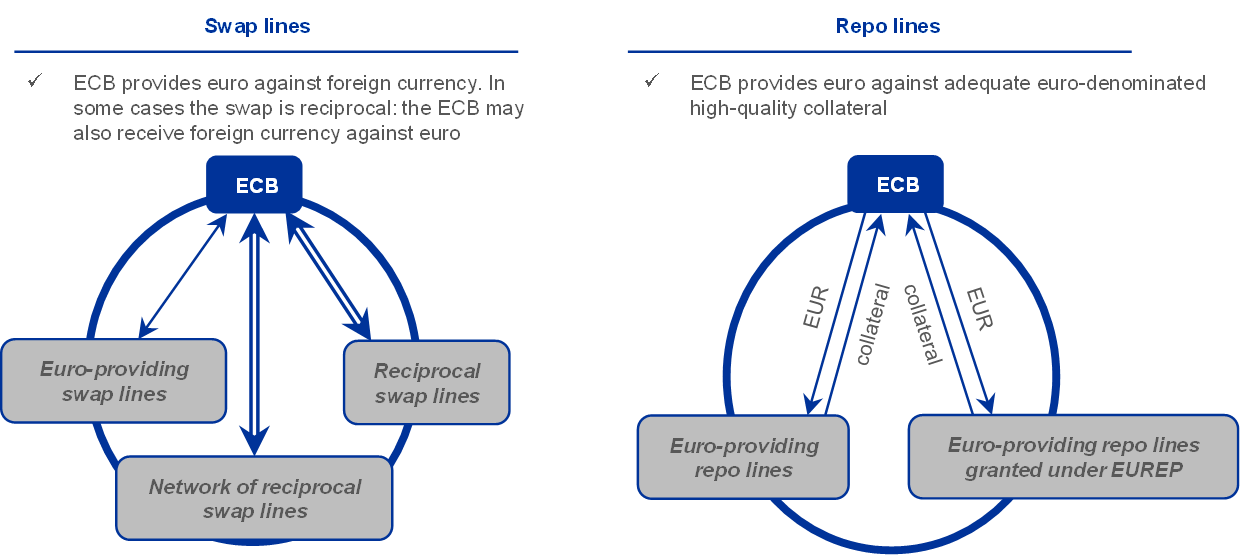
Source: ECB.
Swap line agreements among the group of major central banks ensure reciprocal access to each central bank’s currency, although in practice most of these agreements are currently not in use or are used only in one direction. Bilateral swap lines between the ECB and non-euro area central banks enable the latter to provide euro to their domestic counterparties. The amounts involved are typically restricted, and the risks of swap lines are considered to be mitigated to some extent by the payments received. On 15 March 2020 the ECB, in a coordinated action with other major central banks (the Bank of Canada, the Bank of England, the Bank of Japan, the Federal Reserve System and the Swiss National Bank), announced that it would offer weekly US dollar liquidity-providing operations with a maturity of 84 days (in addition to one-week operations) and would lower the pricing of all US dollar operations. Following this announcement the ECB offered operations with maturities of seven days and 84 days and adjusted the frequency of these operations (daily, weekly or monthly) depending on the financial market environment.
On 20 March 2020 the ECB announced that it would reactivate the existing bilateral swap line with Danmarks Nationalbank and increase its size to €24 billion. In April it also arranged new bilateral swap lines with Hrvatska narodna banka and the Bulgarian National Bank which allow both central banks to provide euro to domestic counterparties up to a ceiling of €2 billion in each case.
In the course of 2020 the ECB established bilateral repo lines with several non-euro area central banks (see Table 2) and on 25 June established the Eurosystem repo facility (EUREP), which creates a general framework that is accessible to a broad set of non-euro area central banks. Under this facility the central banks can borrow euro liquidity against adequate collateral, consisting of euro-denominated marketable debt securities issued by euro area central governments and supranational institutions.
Table 2
Overview of bilateral repo lines established in 2020

Source: ECB.
The ECB’s contribution to benchmark interest rate reform
The ECB continued to play an important role in the reform of euro area benchmark interest rates in two main ways: first, by providing a robust and reliable benchmark, the euro short-term rate (€STR), and, second, by catalysing market initiative through the provision of the secretariat of a private sector working group on euro risk-free rates.
The €STR was launched on 2 October 2019. The rate measures the wholesale euro unsecured overnight borrowing costs of banks located in the euro area and is based entirely on daily confidential statistical information relating to money market transactions collected in compliance with the Money Market Statistical Reporting Regulation.
After the rate had been published for a year, the ECB conducted a review of the methodology for its calculation in accordance with Article 15(2) of the €STR Guideline, which requires it to review at least annually whether changes in the underlying market require changes to the rate and its methodology. The review considered whether the rate correctly reflects the underlying market dynamics, is built on a sufficient volume of data and is non-biased. It concluded that the methodology was able to measure correctly the defined underlying interest and that the basis for measuring unsecured market overnight borrowing costs remained adequate.
Given the robustness and representativeness of the €STR, market participants are encouraged to use the rate in both cash and derivatives products, as the EONIA will be discontinued on 3 January 2022. To encourage and support the wider use of the €STR, including in fallback provisions in contracts based on the euro interbank offered rate (EURIBOR), the ECB has decided to publish compounded €STR average rates and a compounded index.[50]
Meanwhile, the working group on euro risk-free rates, which is tasked with (i) guiding market participants in their transition to the €STR from the widely used EONIA and (ii) recommending suitable fallback rates for the EURIBOR, has provided essential input into the contingency planning for a scenario in which the EURIBOR may permanently cease. Following two public consultations on EURIBOR fallback rates and on EURIBOR fallback trigger events, the working group is expected to publish, in the second quarter of 2021, its recommendations for the most suitable EURIBOR fallback rates for each asset class and a set of fallback trigger events to apply universally. Market participants are encouraged to take note of the recommendations and consider them in their fallback planning.
Market contact groups
The year 2020 saw particular challenges and unforeseen developments in financial markets. In these times of heightened uncertainty, the ECB greatly valued the structured interactions with financial market participants, which took place via its market contact groups. On a number of occasions the Bond Market Contact Group, the Foreign Exchange Contact Group, the Money Market Contact Group and the ECB Operations Managers Group were called for ad hoc meetings to exchange views on the ongoing financial market developments and on market functioning. Market participants were encouraged to express their views openly for discussion and raised their concerns, which helped the ECB to identify potential pressure points in the financial system and assess its resilience, in particular during the outbreak of the coronavirus in Europe in spring 2020. The insights gained were helpful in the efforts to increase the efficiency and effectiveness of the implementation of the ECB’s monetary policy.
Reporting on foreign exchange interventions
In September 2019 the Governing Council of the ECB decided to publish additional data on the ECB’s foreign exchange interventions. Since May 2020 these data have been published in a table on the ECB’s website and in the Statistical Data Warehouse. They are updated on a quarterly basis with a delay of one quarter. The information published in the quarterly tables is also recapped on an annual basis in the ECB’s Annual Report (see Table 3). Where there was no foreign exchange intervention in the relevant quarter, this is explicitly stated.
The ECB did not intervene in the foreign exchange market in 2020. Since the inception of the euro the ECB has intervened in the foreign exchange market twice – in 2000 and 2011.
Table 3
ECB foreign exchange interventions
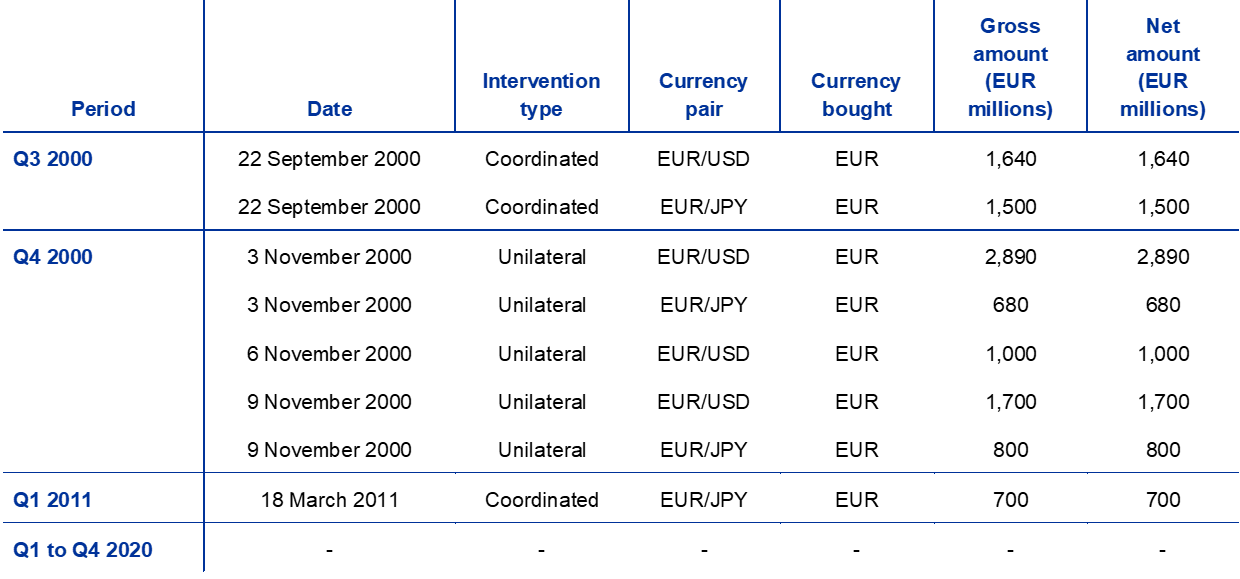
Source: ECB.
The reporting framework covers foreign exchange interventions carried out by the ECB unilaterally and in coordination with other authorities, as well as interventions “at the margins” within the exchange rate mechanism (ERM II).
5.2 Administration of EU borrowing and lending operations
The ECB processes payments for various EU loan programmes
The ECB is responsible for the administration of the borrowing and lending operations of the EU under the medium-term financial assistance (MTFA) facility,[51] the European Financial Stabilisation Mechanism (EFSM)[52] and the European instrument for temporary support to mitigate unemployment risks in an emergency (SURE).[53]
In 2020 the ECB processed interest payments in relation to the loans under the MTFA. As at 31 December 2020 the total outstanding amount under this facility was €200 million. In 2020 the ECB also processed various payments and interest payments in relation to the loans under the EFSM. As at 31 December 2020 the total outstanding amount under this mechanism was €46.8 billion. The ECB also processed the disbursements of SURE loans to Member States in 2020. At 31 December 2020 the outstanding amount under this facility was €39.5 billion.
Similarly, the ECB is responsible for the administration of payments arising in connection with operations under the European Financial Stability Facility (EFSF)[54] and the European Stability Mechanism (ESM).[55] In 2020 the ECB processed various interest and fee payments in relation to two loans under the EFSF.
Finally, the ECB is responsible for processing all payments in relation to the loan facility agreement for Greece.[56] As at 31 December 2020 the total outstanding amount under this agreement was €52,193.75 million.
5.3 Eurosystem reserve management services
A number of Eurosystem central banks provide services under the ERMS framework
In 2020 a comprehensive set of financial services continued to be offered within the Eurosystem reserve management services (ERMS) framework established in 2005 for the management of customers’ euro-denominated reserve assets. Some of the Eurosystem national central banks provide financial services within this framework, under harmonised terms and conditions and in line with market standards, to central banks, monetary authorities and government agencies located outside the euro area, and to international organisations. The ECB performs an overall coordinating role, monitors the smooth functioning of the services, promotes changes to improve the framework and prepares related reports for the ECB Governing Council.
The number of customer accounts in the ERMS was 260 at the end of 2020, compared with 273 at the end of 2019. The total aggregated holdings (including cash assets and securities holdings) managed within the ERMS framework increased by approximately 1.7% in 2020 compared with 2019.
The ERMS legal framework was updated in 2020 to strengthen incentives for transparency in reporting and for information sharing within the Eurosystem in the context of the provision of the ERMS services.
The ECB and euro area national central banks (NCBs) are responsible for issuing euro banknotes within the euro area, for guaranteeing the availability of cash and for maintaining confidence in the currency. Despite the impact of the pandemic on consumption and payment behaviour, the number of euro banknotes in circulation continued to grow strongly, while the number of counterfeit banknotes removed from circulation dropped to a historically low level.
6.1 Continued high demand for euro banknotes
The number and value of euro banknotes in circulation have been rising, generally at a faster pace than economic growth, since 2002
In 2020 the number and value of euro banknotes in circulation grew by around 10%. At the end of the year there were 26.5 billion euro banknotes in circulation, with a total value of €1,435 billion (see Charts 21 and 22). The €50 banknote accounted for nearly half of both the number and value of banknotes in circulation. In mid-March 2020, after COVID-19 was declared a pandemic, a very strong increase in demand for cash was observed for a few weeks, especially for the denominations €200 and €100 as demand for precautionary cash holdings rose. This was followed in the subsequent months by a decline in credit institutions’ regular withdrawals of cash and their lodgements of cash at NCBs as a consequence of the lockdown measures and changes in the pattern of payments, resulting in a reduction in the volume of the cash cycle by up to 20% in the further course of 2020 compared with 2019. Nonetheless, banknotes in circulation continued to grow throughout 2020, mainly owing to higher uncertainty and a general impulse to hoard banknotes in crisis situations.
Chart 21
Number and value of euro banknotes in circulation
(left-hand scale: EUR billions; right-hand scale: billions)
Source: ECB.
Chart 22
Value of euro banknotes in circulation by denomination
(EUR billions)
Source: ECB.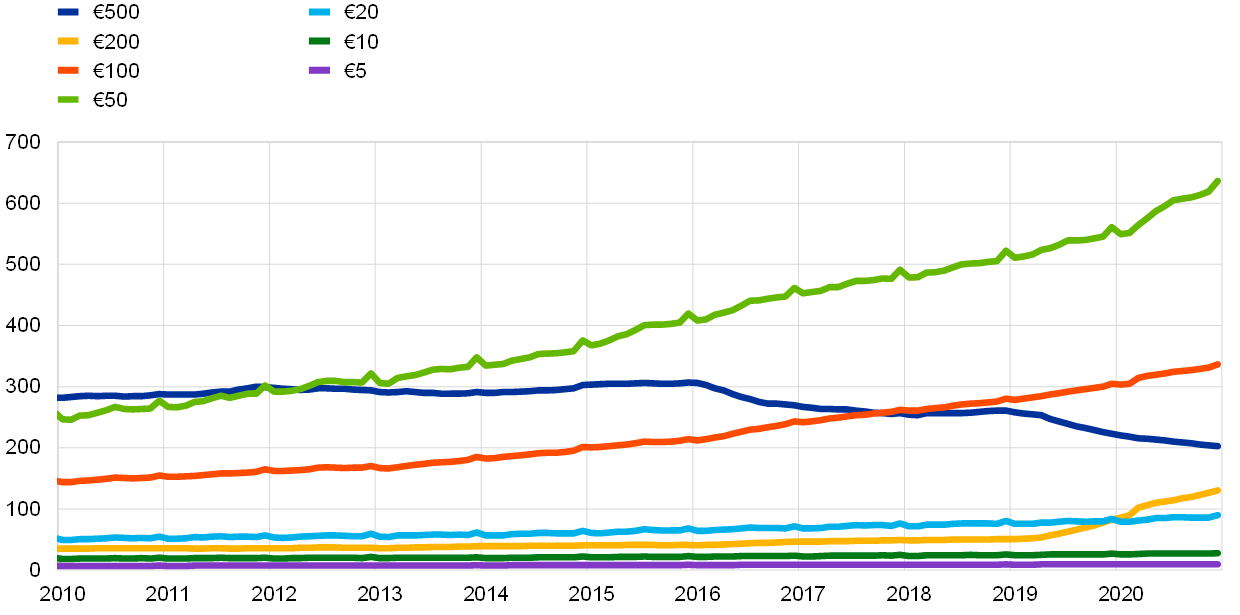
In terms of value, a significant share of euro banknotes is held outside the euro area
A recent study suggested that the share of euro banknotes in circulation outside the euro area is between 30% and 50% of the total value of euro banknote circulation. The study presents evidence that these notes are used for both store-of-value and transaction purposes.
The production of euro banknotes is shared among euro area NCBs, which were together allocated the production of around 5.7 billion banknotes in 2020.
The total number of euro coins in circulation increased by 2% in 2020, to 138 billion at the end of the year. The value of coins in circulation rose to €30 billion, 1.4% higher than at the end of 2019.
In 2020 25.0 billion banknotes with a total value of around €800 billion were deposited by credit institutions at euro area NCBs. 12.0% of these banknotes (i.e. 3.0 billion) were replaced by new banknotes to maintain the high quality of banknotes in circulation.
6.2 The use of cash by citizens
Study on the use of cash in the euro area

In 2019 the ECB launched its second study on the payment attitudes of consumers in the euro area (SPACE) to assess the use of cash and non-cash payment instruments. The study showed that 73% of all payments by consumers at the point of sale and in reported person-to-person transactions were settled in cash. In value terms, cash payments represented 48% of the total value of transactions, followed by card payments, which accounted for 41%.
Cash will remain important in the future
The study also found that for 55% of the respondents it was important or very important to have the option to pay with cash in the future. The results also revealed that 34% of respondents keep cash reserves, either for transactional purposes or as savings.
A euro area-wide survey in July 2020 found that the COVID-19 pandemic had had a strong impact on consumers’ payment behaviour, as 40% of respondents reported paying less with cash. Measures to increase the convenience of cashless means of payment were the main reason given for the shift in payment behaviour induced by the pandemic.
Maintaining the availability and acceptance of euro cash
The Eurosystem’s Cash 2030 strategy aims to ensure good access to cash and its acceptance as a means of payment
To maintain trust in euro banknotes and coins and consumers’ freedom of choice in how to pay, the ECB’s Governing Council adopted a new strategy for cash in 2020. The Eurosystem’s Cash 2030 strategy published in December 2020 defines the priorities and strategic objectives to be pursued in the coming years and aims to ensure that all euro area citizens and firms will continue to have good access to cash services and that cash will remain a generally accepted means of payment. A reduction of the ecological footprint of euro banknotes and the continued development of innovative and secure banknotes are also important elements that will be addressed.
To achieve these goals, the Eurosystem has started to analyse the geographic coverage of credit institutions’ cash service points and the evolution of the standard fees charged by credit institutions to their customers for depositing and withdrawing banknotes and coins. Furthermore, the ECB and the NCBs have entered into a close dialogue with the banking community and other stakeholders in the cash cycle about adequate cash services, as credit institutions will continue to be the key actors in the retail cash distribution system and in checking the authenticity and quality of banknotes in circulation. Following the outbreak of the pandemic, particular efforts were made by the ECB and the NCBs in close cooperation with all cash stakeholders to tackle the challenges of the lockdowns and to mitigate the disruptive impact on national cash cycles.
Low transferability of the coronavirus via banknotes
The risk of catching COVID-19 by using cash for payments is insignificant
Since the emergence of COVID-19 the ECB has been working closely with several laboratories to determine what contribution the use of cash may be making to the spread of the virus. Two related but different aspects have been assessed: first, the length of time the virus can survive on the surface of banknotes and coins (survivability); second, the amount of virus that can be transferred from cash to a person’s hand (transferability). The results of these tests support the views previously expressed by many eminent organisations that the risk of transmission via the use of cash is low. The tests showed that the amount of virus potentially transferred by using cash for payments is so low that the risk of infection is insignificant.
6.3 Euro banknote counterfeiting at a historically low level
In 2020 the number of counterfeit euro banknotes decreased to its lowest level since 2003. Around 460,000 counterfeits were withdrawn from circulation. Relative to the number of genuine euro banknotes in circulation, the proportion of counterfeits reached a historical low at 17 parts per million (see Chart 23).
Chart 23
Number of counterfeit banknotes per million genuine euro banknotes in circulation
(parts per million)
Source: ECB.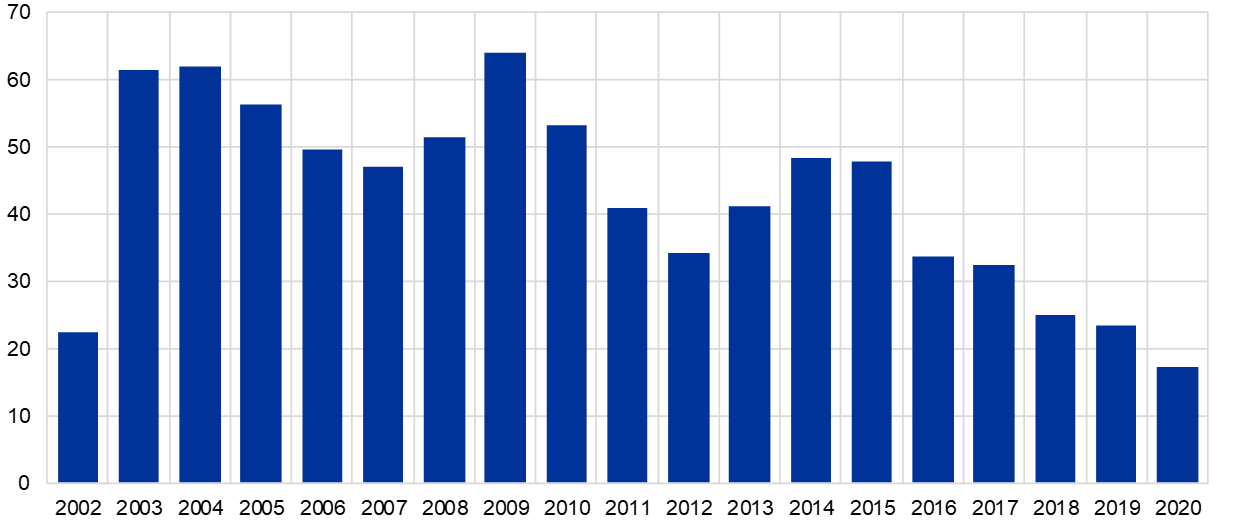
Counterfeiters mainly produce counterfeit €20 and €50 banknotes, which together accounted for two-thirds of the total number of counterfeits withdrawn from circulation in 2020. The €20 has replaced the €50 as the most counterfeited denomination. There has also been an increase in the proportion of low-quality counterfeits. These are easy to detect as they have no, or only very poor imitations of, banknote security features.
The ECB advises the public to remain vigilant when receiving banknotes and to remember the “feel-look-tilt” test
In spite of the decline in the quality of counterfeits, the ECB continues to advise the public to remain vigilant when receiving banknotes, to remember the “feel-look-tilt” test, and not to rely on just one security feature. In addition, training is offered to professional cash handlers on a continuous basis, both in Europe and beyond, and up-to-date information material is made available to the public to support the Eurosystem’s fight against counterfeiting. The ECB also cooperates with Europol, Interpol and the European Commission in pursuit of this goal.
The ECB – assisted by the national central banks (NCBs) – develops, collects, compiles and disseminates a wide range of statistics and data needed to support the ECB’s monetary policy as well as financial stability-related and other tasks of the European System of Central Banks (ESCB) and the European Systemic Risk Board (ESRB). These statistics are also used by public authorities, international organisations, financial market participants, the media and the general public, and help the ECB to increase the transparency of its work.
This chapter focuses on how to contain the reporting burden for banks while maintaining the quality of statistics, on new euro area statistics and on the provision of data and statistics during the COVID-19 pandemic. Two boxes focus on the compliance of the euro short-term rate (€STR) with principles developed by the International Organization of Securities Commissions (IOSCO) and on a review of international statistical standards addressing developments with significant implications for central banking policies and functions.
7.1 Strategy for reporting – reducing costs and enhancing quality
The ESCB made proposals aimed at reducing reporting burdens and enhancing data quality as well as synchronisation with work on the IReF
In its input into the forthcoming European Banking Authority (EBA) feasibility report on an integrated reporting system for banks, the ESCB explained its strategy for collecting data from banks (see Figure 3) and made proposals to reduce the reporting burden on banks in the fields of statistical, resolution and prudential reporting without losing the information content that is indispensable to monetary policy, resolution and supervisory tasks.[57]
This can be achieved through:
- a common standard data dictionary and common data model for statistical, resolution and prudential information requirements;
- procedural improvements, such as the removal of duplicated data requests and improved data sharing between authorities;
- increased cooperation between European authorities, and between authorities and the banking industry, to achieve a common data model and smarter procedures.
The ESCB also proposed synchronisation with work on the ESCB’s Integrated Reporting Framework (IReF).
Figure 3
ESCB strategy for collecting data from banks
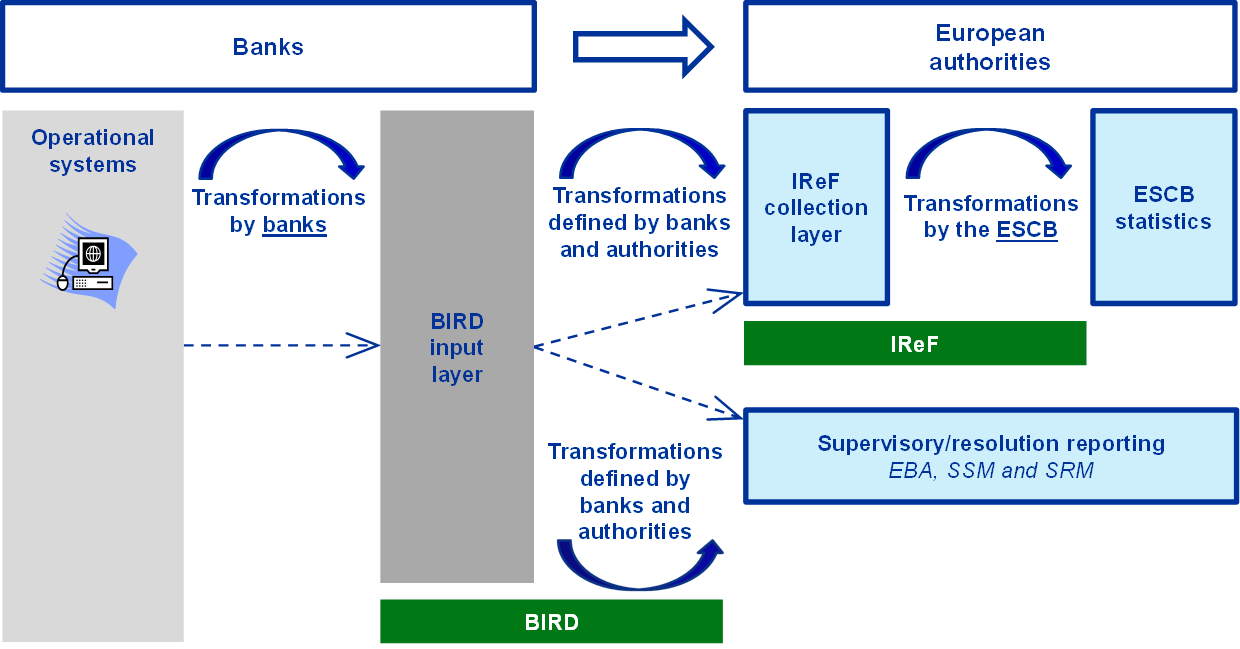
Source: ECB.
Note: BIRD: Banks’ Integrated Reporting Dictionary; SSM: Single Supervisory Mechanism; SRM: Single Resolution Mechanism.
7.2 New and enhanced euro area statistics
Despite the COVID-19 pandemic, the ECB implemented its plans to provide new statistics
On 7 April 2020 the ECB for the first time published consistent euro area balance of payments statistics and euro area sector accounts, thereby facilitating the combined use of these two datasets for analytical purposes.
The euro effective exchange rates and harmonised competitiveness indicators, as well as the underlying trade weights, were updated on 1 July 2020.
In 2020 the ECB developed new communication tools to make access to its data and statistical products easier for the general public. It released the ECB’s first interactive digital publication, “Statistics insights: Money, credit and central bank interest rates”, a combination of visuals, texts and interactive graphs written in plain language in 23 EU languages. Euro area and national statistics contained in the publication are updated in real time with each new data release. A blog post by Isabel Schnabel, member of the Executive Board of the ECB, which was released on World Statistics Day, explains the strategic value of high-quality data and statistics for ECB policymaking.
7.3 Provision of data and statistics during the pandemic
The ECB had to adapt to provide the statistics needed to face the COVID-19 crisis
The COVID-19 pandemic has created unprecedented challenges for policymakers, requiring the monitoring of high-frequency proxies for economic activity as well as standard statistical indicators to calibrate the ECB’s monetary policy response in real time at a time of great uncertainty. The pandemic has also posed considerable and diverse challenges for both reporting agents and statistical compilers.
In a joint effort, the ECB and Eurostat identified the main issues facing the production of balance of payments statistics, such as the suspension of border surveys, lower response rates and delays on the part of direct reporters, in particular non-financial corporations, as well as lower quality of and delays in obtaining access to administrative data (e.g. VAT returns) and annual financial statements. A list of alternative sources that could be used to reduce gaps was discussed and the basis created for greater collaboration and partnering between compilers.
In this context, maintaining business continuity in ESCB and European Statistical System (ESS) statistics and supervisory data was essential.
Cooperation with reporting agents, the NCBs, the ESS and Eurostat proved crucial
In April the ECB adjusted some reporting requirements and invited NCBs and reporting agents to find pragmatic solutions within the existing legal framework in order to keep data reporting within limits that are manageable for reporting agents, while maintaining the quality of statistical information at a level that is fit for purpose.[58] The ECB also cooperated closely with the NCBs, Eurostat and national statistical institutes to develop common mitigation approaches with respect to data sources and estimation methods in order to minimise quality loss and potential country and regional comparability issues.
Granular data collected by the ECB allowed detailed and timely analysis
The development of several policy measures adopted by the ECB’s Governing Council to counter the effects of the pandemic also benefited from the flexibility provided through granular data collected by the ECB and NCBs. The ECB also adapted its data production in order to be able to appropriately calibrate its policy response, including, for example:
- processing lending data collected from banks participating in targeted longer-term refinancing operations;
- generating daily data on gross issuances, redemptions and outstanding amounts of government bonds of euro area countries to calibrate the ECB’s asset purchase programmes.
Box 6
€STR compliance with IOSCO principles
Compliance with the Principles for Financial Benchmarks developed by the International Organization of Securities Commissions (IOSCO) ensures that the control framework for the euro short-term rate (€STR) follows international best practice.
On 30 September 2020 the ECB published its statement of compliance of the €STR with the IOSCO Principles. The statement has been independently assured as part of an external audit by the auditing firm PricewaterhouseCoopers.
The ECB’s governance, quality and accountability processes for the €STR apply the IOSCO Principles – where relevant and appropriate – to ensure that an effective and transparent control framework in line with international best practice is in place in order to protect the integrity and independence of the process used to determine the €STR. The statement provides an overview of how the ECB administers the €STR, presents a self-assessment of its compliance with each IOSCO Principle, and describes the relevant frameworks and procedures.
Box 7
Review of international statistical standards
ECB and NCB staff are contributing to the process of updating two international handbooks on the methodological framework for national accounts and balance of payments statistics, which are important for central banking policies and functions.
The international statistical standards are a harmonised set of concepts, definitions, classifications, accounting rules and other related guidelines that inform the compilation of official economic statistics with the aim of making them suitable for policymaking, analysis and research purposes. They determine which economic flows and positions are captured in macroeconomic measures such as GDP, debt or the current account, and how they are recorded.
Since they encompass all areas of economic statistics and are available to all data compilers worldwide, the standards facilitate comparability across statistical domains and across national and international economic areas. The economic data and statistics used by the ECB are all based on the standards.
In March 2020 the competent international bodies – the United Nations Statistical Commission and the IMF Committee on Balance of Payments Statistics – decided to launch a review of two handbooks of the system of standards: the System of National Accounts and the Balance of Payments and International Investment Position Manual. The review will address phenomena such as globalisation, digitalisation, new forms of financial intermediation and climate change, and establish appropriate statistical treatments to cover them. These developments have significant implications for central banking policies and functions, and their effects are being considered for instance in the context of the ECB’s ongoing monetary policy strategy review.
In view of the importance of the standards for the ESCB, staff from the ECB and NCBs are contributing to the updating process, together with experts from international organisations, statistical offices and other national authorities. The new standards are scheduled to be ready by 2025, and will subsequently be incorporated into European statistical legislation, including that of the ECB.
The COVID-19 pandemic also affected research activities during 2020, with a boost to research devoted to the refinement of tools for the real-time assessment of economic conditions and the assessment of policy options. At the same time, regular research networks and task forces continued their work. Cooperation with the academic world was initially constrained by the pandemic, but activities resumed in the second half of the year.
8.1 Activities related to COVID-19
Efforts were made to refine tools for the real-time assessment of economic and financial conditions
The COVID-19 pandemic boosted efforts to refine tools to monitor economic and financial conditions in order to better capture the rapidly changing conditions in real time.
One example involves the development of monthly and weekly indicators of economic activity. While monthly indicators have become a standard tool in economic forecasting over the last decade, the analysis has now been enhanced to weekly frequency through the use of a variety of new data, partly from web-based sources (see Box 8).
Similarly, indicators of financial stress have been refined to assess risks of financial fragmentation in the euro area on a weekly basis. These indicators show that the COVID-19 pandemic initially caused sharp fragmentation, close to levels seen during the global financial crisis of 2008 and the euro area sovereign debt crisis of 2012.[59] However, euro area financial fragmentation broadly returned to pre-crisis levels by mid-September 2020, thanks to the rapid economic policy responses and the resilience created by the financial backstops and reforms implemented over the last ten years.
A new online survey of consumer expectations provided information on household sentiment and labour market conditions
Another important source of information was the ECB’s Consumer Expectations Survey (CES), a new online survey launched in early 2020 and still in its pilot stage. The survey provides regular information on household sentiment and expectations, consumption and savings plans and on labour market conditions. It is characterised by a high degree of timeliness and harmonisation across euro area countries, especially the four largest countries.[60]
The survey revealed differences in financial concerns of households across countries…
The new survey proved very valuable in monitoring the household sector during the COVID-19 outbreak. For example, households were asked about the severity of the financial consequences arising from the pandemic. The replies reveal differences in the financial concerns of households across countries (see Chart 24). For instance, households in Spain and, to a lesser extent, in Italy reported more severe financial consequences than those in Germany and the Netherlands.
Chart 24
Household concerns about the financial consequences of COVID-19
(average concern scores)
Source: ECB.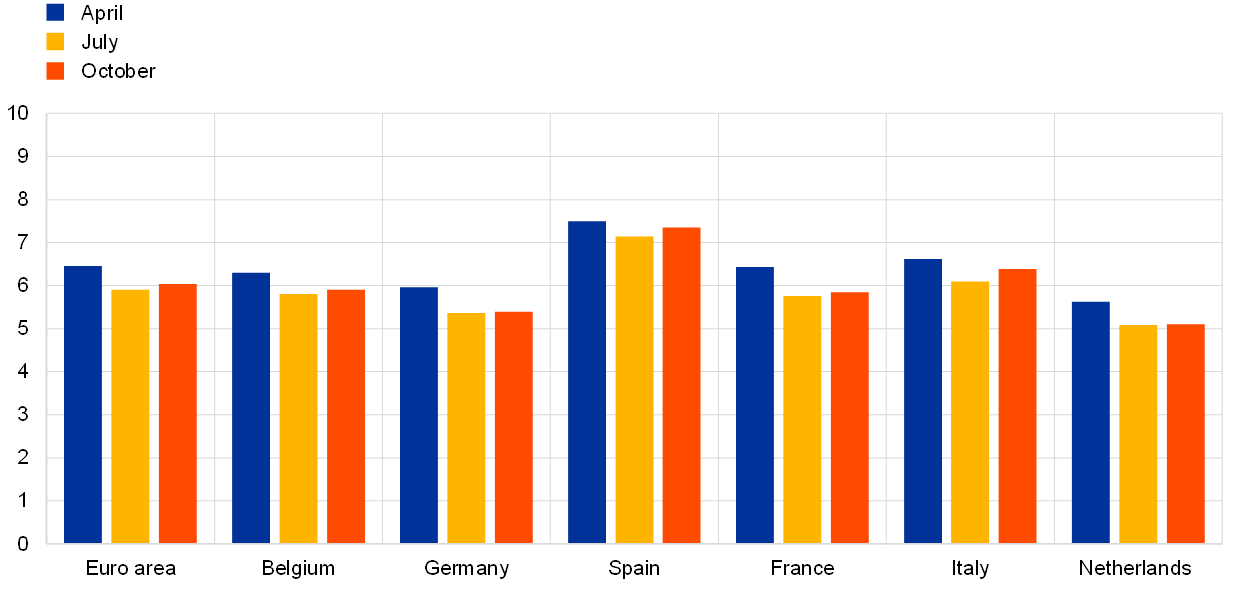
Notes: The chart shows the average score of household replies to the question “How concerned are you about the impact of the coronavirus (COVID-19) with respect to the financial situation of your household?“ and is based on an 11-step response scale ranging from 0 (“Not at all concerned”) to 10 (“Extremely concerned”). Results are shown for April, July, and October 2020.
… and a dependence on demographic and economic household characteristics
Moreover, the survey suggests that households in which the members are young, have low incomes, have temporary working arrangements or have limited access to credit are more vulnerable to the COVID-19 shock. Households with greater financial concerns tend to reduce their spending proportionately more. They would also tend to consume less out of future transfers that they might receive as part of government support programmes. These findings may suggest an important role for very targeted and specific fiscal policy measures to stabilise macroeconomic conditions during the pandemic.
8.2 Research networks
Research clusters continued their regular activities
Regular research networks continued coordinating research efforts within the European System of Central Banks (ESCB) and maintaining relations with academic researchers. In particular, the three ESCB research clusters on monetary policy, financial stability and structural issues of euro area economies organised workshops on the most pressing issues in their fields. For the future, the clusters plan to prioritise research on addressing challenges arising from an environment of low growth, low inflation, climate change and financial technology innovation.
The research task force on monetary policy, macroprudential regulation and financial stability made significant progress
In 2020 the task force on monetary policy, macroprudential regulation and financial stability carried out numerous projects looking into the effects of macroprudential policies. One line of research was the effect of borrower-based macroprudential measures on inequality.[61] While such measures can potentially raise inequality by making it harder for those on low incomes to borrow, they can also reduce it during times of crisis by mitigating the impact of the crisis on vulnerable groups. Another group of projects studied how macroprudential policies, through their effect on financial stability and on the equilibrium interest rate, influence the transmission of monetary policy and how monetary policy, through its effect on risk-taking by financial intermediaries, influences the need for macroprudential policies. A third line of research focused on the benefits of coordinating monetary and macroprudential policies.
The PRISMA research network investigated the frequency of individual price changes and issues with the measurement of consumer prices
The Price-setting Microdata Analysis Network (PRISMA) studies the price-setting behaviour of individual firms and retail traders using micro price datasets. In 2020 the group analysed the frequency of individual price changes in order to better understand the inflation process, updating evidence provided by the Inflation Persistence Network (IPN) in the early 2000s. It also looked at data underlying the calculation of official consumer price indices.
The Household Finance and Consumption Network released its survey for 2017
The Household Finance and Consumption Network released the results of the third (2017) wave of the Household Finance and Consumption Survey (HFCS) in March 2020. While the median net wealth of euro area households remained broadly stable between 2014 and 2017, households recorded broad-based gains in income, with median incomes rising by 4.1%. Moreover, the concentration of net wealth among the wealthiest households in the euro area remained unchanged in this period, while the most heavily indebted euro area households may have seen an easing of financing pressures. The data will also contribute to understanding heterogeneities in monetary policy transmission and in financial pressures across households.
CompNet studied how European companies compete in a global environment replete with COVID-19 challenges
The ESCB also maintains links with independent research networks, such as the Competitiveness Research Network (CompNet) ‒ a hub for research and policy analysis on competitiveness and productivity. In 2020 CompNet organised two virtual conferences, with Národná banka Slovenska and the ECB respectively. The first conference examined sustainable development, firm performance and competitiveness policies in small open economies. The second discussed the effects of the COVID-19 pandemic on international trade and capital flows and the implications of these developments for European firms. CompNet also published new research on productivity-related matters in the Firm Productivity Report 2020.
8.3 Conferences and publications
Conference activity stalled in the first half of 2020, but resumed in a new form thereafter
Cooperation with the academic world was constrained by the pandemic in the first half of the year and many regular conferences were cancelled or postponed, including the ECB Forum on Central Banking, which was due to take place in Sintra in June/July, but was instead held as an online event in November. Conference activity resumed in the second half of the year by means of virtual events, notably the ECB’s Annual Research Conference and the Monetary Policy Conference. Both conferences discussed options for the policy response to COVID-19, but also featured innovative research related to monetary policy transmission and financial market structures.
Publication of research papers remained unaffected by COVID-19
161 papers prepared by ECB staff were published in the ECB’s Working Paper Series in 2020. In addition, a number of more policy-oriented or methodological studies were published in the ECB’s Occasional Paper Series, Statistics Paper Series and Discussion Paper Series. Many of the ECB’s research activities also resulted in the publication of papers in academic journals, while some material is aimed at a more general audience, including 13 articles published in the ECB’s Research Bulletin.
Box 8
Monitoring the economy in real time
The “nowcasting” of the economy has been a long-standing task in economic analysis. In the euro area, the first official release of quarterly GDP is published about four weeks after the end of the quarter. In the meantime, economists must assess economic activity using various monthly indicators, such as industrial production or business and consumer surveys. The use of statistical methods to condense the information in these indicators plays an important role in this assessment.
The COVID-19 pandemic increased the need to assess economic activity in real time. Researchers at the ECB and national central banks have intensified their efforts to exploit high-frequency data in order to create more timely estimates of economic activity. While traditional indicators are available at monthly frequency, the big data revolution now offers indicators of economic activity that are available at weekly or even daily frequency, such as online payment data, traffic data (truck road tolls), electricity consumption, air pollution, Google search data and many more.[62]
These indicators have proven highly valuable in assessing the economy during the pandemic. The index in Chart A, for example, shows, together with the levels of quarterly GDP, a weekly real-time assessment of euro area economic activity, combining a set of weekly data with the traditional monthly indicators. The index is normalised to a level of 100 in December 2019. The weekly index shows that the euro area economy went into a sharp recession in the first week of March 2020 when lockdown measures were imposed and reached a trough in the last week of April, before recovering gradually when the measures were lifted. Economic activity then remained stable over the year.
Chart A
Weekly euro area activity-level tracker and quarterly GDP
(index: December 2019 = 100)
Sources: ECB, Google, Eurostat, Markit and national statistical institutes.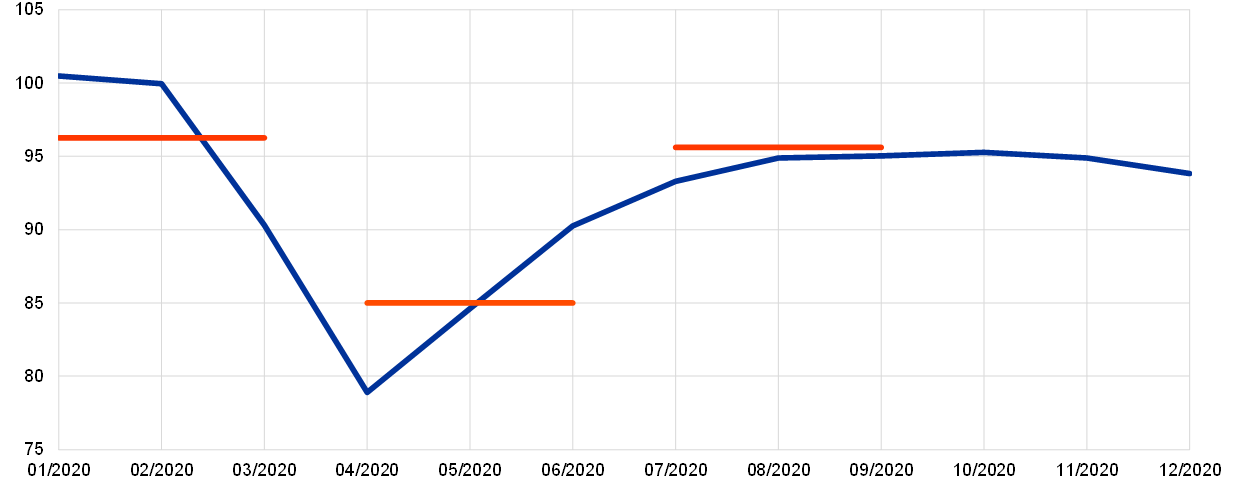
Notes: The blue line represents the level of the tracker at weekly frequency. The red line shows the level of quarterly GDP. The activity tracker is standardised to December 2019 = 100, while GDP is standardised to the fourth quarter of 2019 = 100.
This chapter deals with the jurisdiction of the Court of Justice of the European Union (CJEU) concerning the ECB; provides information on ECB opinions and cases of non-compliance with the obligation to consult the ECB on draft legislation falling within its fields of competence; and reports on the ECB’s monitoring of compliance with the prohibition of monetary financing and privileged access.
9.1 Jurisdiction of the Court of Justice of the European Union concerning the ECB
The CJEU agreed with the ECB that the Governing Council has broad discretion when it comes to keeping the outcome of its deliberations confidential
On 19 December 2019 and on 21 October 2020 the Court of Justice delivered on appeal two judgments related to the confidentiality of the outcome of the deliberations of the Governing Council (cases C-442/18 P and C-396/19 P respectively). The cases originate in two requests for public access to the decision of the Governing Council to suspend access by a credit institution (Banco Espírito Santo) to monetary policy credit instruments. The ECB had refused access to the part of the minutes of the Governing Council recording the amount of credit that had been granted to Banco Espírito Santo through monetary policy operations, on the basis of, among others, Article 10.4 of the Statute of the European System of Central Banks (ESCB) and of the European Central Bank and the first indent of Article 4(1)(a) of Decision ECB/2004/3. On appeal, the Court of Justice accepted the arguments of the ECB and quashed the contested part of the General Court judgments. The two judgments set important precedents regarding public access to the outcome of the Governing Council’s deliberations. According to the Court of Justice, the outcome of the deliberations, like the deliberations themselves, is confidential and remains confidential unless the Governing Council has decided to make that outcome public in whole or in part. The disclosure of the outcome of its deliberations is an “exclusive competence conferred on the Governing Council”. When refusing to disclose documents recording the outcome of the proceedings, the ECB’s statement of reasons, invoking the fact that the requested document is part of the minutes, is adequate. The refusal to disclose the outcome of the deliberations is not subject to the additional condition that the ECB prove how the disclosure would “undermine the protection of the public interest.”
The SSM Framework Regulation establishes, in principle, non-anonymised publication of sanctioning decisions
On 8 July 2020 the General Court delivered its first four judgments concerning ECB sanctioning decisions. In Case T-203/18 (VQ v ECB), the Court rejected all pleas in law submitted by the applicant. In particular, it ruled that the ECB did not fail to comply with the principle of proportionality in imposing the sanction and publishing the penalty. The Court also clarified that the legal framework establishes the principle of non-anonymised publication of sanctioning decisions, also before the expiry of the period for bringing an action for annulment. In three other cases (T-576/18, T-577/18 and T-578/18), the Court partially annulled three ECB sanctioning decisions regarding Crédit Agricole S.A. and two of its subsidiaries. The Court found that the applicants breached Article 26(3) of Regulation (EU) No 575/2013, which must be interpreted as requiring a credit institution to obtain the permission of the competent authorities before classifying its capital instruments as Common Equity Tier 1 instruments. Nevertheless, it annulled the sanctions on the basis that the contested decisions did not provide enough details of the methodology applied by the ECB in determining the amount of the penalties imposed. The applicants have appealed against these rulings before the CJEU (cases C-456/20 P, C-457/20 P and C-458/20 P).
The CJEU confirmed the broad scope of the “space to think” exception of the ECB’s public access regime
On 17 December 2020 the CJEU dismissed in its entirety an appeal by Fabio De Masi and Yanis Varoufakis against a judgment of the General Court (C-342/19 P). The latter judgment, of 12 March 2019, confirmed that the ECB was entitled to base its decision not to grant public access to an external legal opinion obtained in 2015 on the “space to think” exception under Article 4(3), first subparagraph, of Decision ECB/2004/3 (2004/258/EC). The CJEU ruled that the “space to think” exception is not limited to documents relating to a specific decision-making process but linked it to the principle of central bank independence set out in Article 130 of the Treaty on the Functioning of the European Union. The Court recalled that the ECB must be able to effectively pursue the objectives of its tasks, through the independent exercise of the specific powers conferred on it for that purpose by the Treaty and the Statute of the ESCB. Moreover, it confirmed that a document can be covered by several of the exceptions set out in Decision ECB/2004/3, and that the legal advice exception under Article 4(2), second indent, of Decision ECB/2004/3 is not lex specialis to the relatively broad “space to think” exception. Finally, the CJEU clarified that the “space to think” exception does not require the ECB to establish that disclosure of the document at stake would seriously undermine its decision-making process.
The CJEU declared that Slovenia infringed the inviolability of the archives of the ECB by seizing documents at the premises of Banka Slovenije
On 17 December 2020 the Court of Justice, sitting in Grand Chamber, declared in an infringement procedure, lodged by the European Commission against Slovenia (C-316/19), that by unilaterally seizing documents connected to the performance of the tasks of the ESCB and the Eurosystem at the premises of Banka Slovenije in July 2016, Slovenia failed to fulfil its obligation to respect the inviolability of the archives of the European Union under Articles 2 and 22 of the Protocol on the Privileges and Immunities of the Union. In view of the highly integrated system in which the ECB was operating, the Court of Justice interpreted the scope of the archives of the European Union as including all documents created, processed and transmitted by the ECB or the national central banks (NCBs) in connection with the performance of the tasks of the ESCB and the Eurosystem irrespective of whether they are held by the ECB or the NCBs. Hence, national authorities may not, without coordinating with the ECB in advance, seize such documents at the premises of the NCBs. In addition, the Court of Justice declared that, by failing to cooperate properly with the ECB to eliminate the unlawful consequences of that infringement, Slovenia also failed to fulfil its obligation of sincere cooperation.
9.2 ECB opinions and cases of non-compliance
Articles 127(4) and 282(5) of the Treaty on the Functioning of the European Union require that the ECB be consulted on any proposed EU or draft national legislation falling within its fields of competence. All ECB opinions are published on EUR-Lex. ECB opinions on proposed EU legislation are also published in the Official Journal of the European Union. In 2020 the ECB adopted six opinions on proposed European Union acts and 31 opinions on draft national legislation falling within its fields of competence.
Clear and important cases of non-consultation
Five cases of non-compliance with the obligation to consult the ECB on draft legislation[63] were recorded, four in respect of national law and one in respect of European Union law. Four cases are considered to be clear and important. Two of these cases relate to Slovenian legislation on deferred payments on loans and on liquidity measures for the Slovenian economy arising out of COVID-19. These cases were considered to be clear and important owing to their potential impact on the national central bank, on the capital and liquidity positions of Slovenian credit institutions, on Eurosystem monetary policy operations, and on compliance with the prohibition of monetary financing under Article 123 of the Treaty on the Functioning of the European Union. Another case related to an Italian draft law for a reimbursement mechanism for purchases made via electronic means of payment and was considered clear and important owing to its effect on means of payment, in particular cash. The European Union law case related to the Regulation on the establishment of a European instrument for temporary support to mitigate unemployment risks in an emergency (SURE) following the COVID-19 outbreak and was considered a clear and important case because of its potential impact on the ECB and on the NCBs in connection with the administration of the SURE loans. The ECB fully appreciates the acute urgency with which the legislative process had to be concluded in the two Slovenian cases and the EU SURE case given the emergency situation resulting from the pandemic, including in the SURE case the need to operationalise SURE rapidly as part of the three short-term safety nets agreed by the Eurogroup.
The ECB adopted opinions on proposed EU legislation
The ECB adopted opinions on EU proposals concerning amendments to the prudential and securitisation frameworks in response to the COVID-19 pandemic, and an own initiative opinion concerning the administration by the ECB and the NCBs of loans pursuant to SURE. The ECB adopted an opinion on an EU proposal concerning the exemption of certain third country foreign exchange benchmarks and the designation of replacement benchmarks for certain benchmarks in cessation. It also adopted opinions on an EU proposal concerning exchange rate matters relating to the CFA and Comorian francs and on the appointment of a new member of the ECB Executive Board.
The ECB adopted opinions on draft national legislation
The ECB adopted opinions on draft national legislation concerning national central banks, including: on a proposed comprehensive reform of Sveriges Riksbank; on the institutional and financial independence of Hrvatska narodna banka; on changes in the appointment criteria for the Banco de Portugal’s Governor and Management Board members and the appointment procedure for the members of De Nederlandsche Bank’s decision-making bodies; on reforms of the Supervisory Board of Eesti Pank and the General Council of Sveriges Riksbank; on the close cooperation between the ECB and, respectively, Hrvatska narodna banka and the Bulgarian National Bank within the Single Supervisory Mechanism; on the role of Eesti Pank in defence situations and the exemption of the members of Latvijas Banka’s Council from military conscription; on the role of Hrvatska narodna banka in the calculation of the national reference rate of the average cost of financing the Croatian banking sector; on the role of the Central Bank of Ireland as registrar for beneficial ownership registers for certain financial entities; on the role of the Banco de España in supervising compliance by virtual currency service providers with anti-money laundering and terrorist financing registration requirements; on the role of the Bank of Greece in ensuring compliance with certain requirements arising out of the Single Euro Payments Area (SEPA); on the role of De Nederlandsche Bank in the Netherlands’ Financial Stability Committee; on the provision of emergency liquidity assistance to non-bank entities by Lietuvos bankas; on the provision of short-term liquidity by Banca Naţională a României to the Bank Deposit Guarantee Fund; on the collection and sharing of data by Danmarks Nationalbank; on the right of insolvency administrators and liquidators of credit institutions to hold funds on accounts at Latvijas Banka; and on the financing by the Bank of Greece, the Banca d’Italia, the Central Bank of Malta and the Oesterreichische Nationalbank of their respective Member States’ obligations vis-à-vis the International Monetary Fund.
The ECB adopted opinions on draft national legislation concerning the prudential supervision of credit institutions, including: one opinion on the close cooperation within the Single Supervisory Mechanism between the ECB and Hrvatska narodna banka; two opinions on the close cooperation with the Bulgarian National Bank; and an opinion on the capital treatment of participation certificates issued by a credit institution in Luxembourg.
The ECB adopted opinions on draft national legislation concerning means of payment, including: on cash limitations concerning postal payments in Belgium; on ensuring a minimum level of cash services in Hungary and Sweden; and on limitations on cash payments to professionals in Denmark.
The ECB adopted opinions on draft national legislation concerning banking and financial regulation and financial stability, including: on the state’s support for the deposit guarantee scheme in Luxembourg; on the abolition of the special levy on selected financial institutions in Slovakia; on the identification and reporting by financial institutions of the allocation of sums deposited in savings accounts in Belgium; and on measures limiting macroprudential risks in residential property loans in Germany.
The ECB adopted an opinion on draft Bulgarian legislation concerning the official exchange rate of the Bulgarian lev within the exchange rate mechanism (ERM II).
The ECB adopted an opinion on draft Austrian legislation concerning balance of payments statistical reporting.
9.3 Compliance with the prohibition of monetary financing and privileged access
Pursuant to Article 271(d) of the Treaty on the Functioning of the European Union, the ECB is entrusted with the task of monitoring the compliance of the EU national central banks (NCBs) with the prohibitions implied by Articles 123 and 124 of the Treaty and Council Regulations (EC) Nos 3603/93 and 3604/93. Article 123 prohibits the ECB and the NCBs from providing overdraft facilities or any other type of credit facility to governments and EU institutions or bodies, as well as from purchasing in the primary market debt instruments issued by these institutions. Article 124 prohibits any measure, not based on prudential considerations, which establishes privileged access by governments and EU institutions or bodies to financial institutions. In parallel with the Governing Council of the ECB, the European Commission monitors Member States’ compliance with the above provisions.
The ECB also monitors the EU central banks’ secondary market purchases of debt instruments issued by the domestic public sector, the public sector of other Member States and EU institutions and bodies. According to the recitals of Council Regulation (EC) No 3603/93, the acquisition of public sector debt instruments in the secondary market must not be used to circumvent the objective of Article 123 of the Treaty. Such purchases should not become a form of indirect monetary financing of the public sector.
The prohibitions laid down in Articles 123 and 124 of the Treaty were in general respected
The ECB’s monitoring exercise conducted for 2020 confirmed that Articles 123 and 124 of the Treaty were in general respected.
The monitoring exercise revealed that most NCBs in 2020 had remuneration policies for public sector deposits in place that fully complied with the remuneration ceilings. However, a few NCBs need to ensure that the remuneration rate for public sector deposits is not above the ceiling.
The ECB will continue monitoring the involvement of the Magyar Nemzeti Bank in the Budapest Stock Exchange as the purchase of the majority ownership of the Budapest Stock Exchange by the Magyar Nemzeti Bank in November 2015 may still be seen as giving rise to monetary financing concerns.
The Central Bank of Ireland’s reduction of assets related to the Irish Bank Resolution Corporation during 2020 through sales of long-duration floating rate notes is a step in the direction of the necessary full disposal of these assets. Continued sales at an appropriate pace would further mitigate the persisting serious monetary financing concerns.
The ECB maintained its close dialogue with European and international partners in 2020. It placed a strong focus on communication in the context of its accountability to the European Parliament, in order to explain the unprecedented measures taken in the context of the COVID-19 pandemic. The ECB engaged constructively in G20 dialogues and actively contributed to discussions at the International Monetary Fund (IMF), particularly on the impact of the pandemic. It also continued to cooperate with central banks of emerging market economies.
10.1 The ECB’s accountability
Independence and accountability are two sides of the same coin
The ECB has been able to deliver a strong policy response during the COVID-19 pandemic thanks in part to its ability to act in full independence. This was granted to the ECB through a democratic process and enables it to carry out its tasks free from short-term political pressures.[64] Independence, in turn, relies on effective accountability mechanisms to ensure that the ECB is pursuing its mandate. The ECB has constantly strived to ensure effective accountability practices and to explain its actions to people across Europe and their representatives in the European Parliament. These practices have thus evolved beyond the requirements set out in Article 284(3) of the Treaty on the Functioning of the European Union. They are also complemented by judicial review by the Court of Justice of the European Union.
When the ECB took unprecedented action at the outbreak of the pandemic, the President of the ECB held an ad hoc exchange of views with representatives of the Committee on Economic and Monetary Affairs of the European Parliament (ECON). This was in addition to the four regular hearings before the same committee that occurred in 2020, during which the President also explicitly discussed the key criteria for ensuring effective accountability practices. The ECB and the European Parliament agreed to interact more closely in the context of the ECB’s strategy review.
The President of the ECB also participated in the plenary debate on the ECB’s 2018 Annual Report in February 2020 and the Vice-President presented the ECB’s 2019 Annual Report to ECON in May 2020. In relation to this event, the ECB published its feedback on the input provided by the European Parliament as part of the latter’s resolution on the 2018 Annual Report. Beyond the regular hearings, ECB Executive Board member Fabio Panetta participated in the European Parliamentary Week in February 2020 to discuss the deepening and widening of Economic and Monetary Union and in exchanges of views with ECON on the international role of the euro in July 2020 and on a digital euro in October 2020. The ECB also replied to 48 written questions from Members of the European Parliament in 2020, a significant increase as compared with the previous year.
The latest Eurobarometer surveys indicate that 75% of euro area respondents support the euro and 40% tend to trust the ECB.[65] These results show that trust in the ECB is still vulnerable to economic outcomes – potentially including those beyond its control – and also the need for the ECB to further engage in constructive dialogue with the European Parliament and citizens to explain its decisions and listen to their concerns.
10.2 International relations
G20
The ECB engaged constructively with the G20 initiatives focused on providing an adequate response to the COVID-19 crisis
With the advent of the COVID-19 pandemic, the G20 endorsed a comprehensive Action Plan focused on emergency policies to attenuate the economic fallout of the crisis, safeguard the global financial system and support poor economies. Together with the Paris Club, it also agreed on a temporary Debt Service Suspension Initiative (DSSI) for the poorest countries, and endorsed a Common Framework for Debt Treatments beyond the DSSI. Work was also intensified in the fields of infrastructure and financial inclusion, in view of the new challenges brought by the crisis. With respect to financial sector issues and in collaboration with the Financial Stability Board, the G20 produced a report on financial stability implications of procyclicality of credit rating agencies as well as a roadmap to enhance global cross-border payment arrangements. The G20 also held discussions on global stablecoins, on which more work is foreseen in 2021. Dialogues on digital taxation will carry over into 2021.
Policy issues related to the IMF and the international financial architecture
The IMF reacted promptly to the crisis through its analysis and emergency lending
The ECB continued to play an active role in discussions on the international monetary and financial system at the IMF and in other fora, contributing its perspective to common positions taken by European Union or euro area countries. These discussions were heavily centred on the impact of the COVID-19 pandemic.
The IMF played a central role in the international community’s response to the crisis, not least in terms of its analysis of the economic and financial situation. It also promptly deployed a number of measures, including the provision of emergency financing to an unprecedented number of countries, the granting of new Flexible Credit Lines, debt relief for its poorest members, and the introduction of a new lending tool, the Short-term Liquidity Line. The crisis lending proceeded within the existing IMF lending capacity of around USD 1 trillion. This lending capacity has been maintained for the coming years thanks to the doubling of the IMF’s New Arrangements to Borrow, which took effect on 1 January 2021, and a new round of bilateral borrowing agreements. However, demand for IMF resources needs to be kept under close review. The ECB supports an adequately resourced IMF at the centre of the global financial safety net.
In view of the impact of the pandemic on the debt situation in many countries, the IMF significantly intensified its debt-related work agenda. It initiated a discussion on improving the international architecture for resolving debt crises and announced plans to further review its own policies related to sovereign debt. The IMF also continued with its quinquennial comprehensive surveillance review, a process that will set surveillance priorities for 2020-25, as well as with the review of the Financial Sector Assessment Program (FSAP). Regarding the latter, a report by the International Relations Committee of the European System of Central Banks contributed to the international debate and provided recommendations to enhance the traction of FSAP exercises.
International central bank cooperation with emerging market economies
The ECB continued to cooperate with central banks in emerging market economies
Despite the unprecedented situation, the ECB continued its cooperation with non-EU central banks, in particular through the existing bilateral Memoranda of Understanding with key African, Asian and Latin American central banks and via its structured cooperation with regional central bank organisations and the IMF. This collaboration reflects the global interest in the ECB’s policies, views, analytical frameworks and working processes. Discussions at both staff and policymaker level covered policies and core tasks of the ECB as well as technical and governance issues. Specifically, topics related to COVID-19, climate change and digitalisation from a central banking perspective received considerable interest. In addition, the ECB continued to contribute to the EU enlargement process as an EU institution through targeted discussions with the central banks of the countries in the Western Balkans that have a prospect of joining the EU.
Box 9
ERM II developments
On 10 July 2020 the Bulgarian lev and the Croatian kuna were included in the exchange rate mechanism (ERM II) at their then exchange rate levels. The inclusion of the currencies followed the procedure outlined in the Resolution of the European Council of 16 June 1997, also taking into consideration fundamental factors such as the establishment of the banking union. Before applying for ERM II participation, the Bulgarian and Croatian authorities had implemented a number of prior policy commitments. Their fulfilment was monitored and assessed by the ECB and the European Commission, each in their respective fields of competence, namely banking supervision and macroprudential policy for the ECB and structural policies for the European Commission. In line with past practices, Bulgaria and Croatia made additional policy commitments upon entering ERM II, with a view to ensuring a sustainable convergence path to the euro area.[66] In parallel to joining ERM II, the two central banks have entered into close supervisory cooperation with the ECB.[67] Joining ERM II is one of the preconditions for a country to adopt the euro. The currency must participate in ERM II without severe tensions, in particular with no devaluation against the euro, for at least two years. Following an assessment of the fulfilment of all convergence criteria, euro area entry must be confirmed by a decision of the Council of the European Union in line with the relevant Treaty provisions.[68]
“Good communication forms the bedrock of the ECB’s credibility and underpins our legitimacy in the eyes of the people we serve.”
ECB President Christine Lagarde
Among the many effects of the coronavirus pandemic, one of the most pervasive has been the unprecedented level of uncertainty, not only for the economy and society as a whole, but also for each individual, causing anxiety and often confusion. In such circumstances, reliable, fact-based, timely and clear communication from public authorities is essential to provide vital information and generate trust. Accordingly, the ECB adjusted and stepped up its communication and outreach in 2020. It gave markets and the wider public timely and easily accessible information on its assessment of the economic outlook and the policy measures agreed. Most importantly, the ECB invested in explaining the rationale behind its actions, their intended impact and the concrete benefits for people, businesses, banks and governments in the euro area.
11.1 Communication under the pandemic
The ECB adapted its communications strategy to the constraints of the pandemic and moved most communication online
The pandemic has challenged the ECB to adapt to new ways of reaching out to different audiences. Through innovative forms of communication it has maintained a strong focus on communication and kept its audiences well informed. The ECB has made sure that technical details of its measures are well understood by financial markets and experts and provided swift responses to any queries. Easily accessible information about the ECB’s actions has been published on the dedicated corona hub webpage.
One major part of the new communication approach was the move from in-person gatherings to online events, seminars and talks. With Executive Board members giving fewer speeches and interviews at the onset of the pandemic, the ECB expanded its communication toolbox by introducing the ECB Blog. The blog offers insights into recent policy decisions and trends related to the euro area economy and beyond. All articles are authored by ECB policymakers. 19 blog posts were published in 2020, with many focusing on the ECB’s response to the crisis. The ECB Podcast, introduced in 2019, is another important channel used to reach the wider public. It offered nine episodes in 2020, with topics ranging from the pandemic’s effects on the ECB and its policies and operations to the role of central banks in fighting climate change and the possibility of a digital euro.
The 2020 ECB Forum on Central Banking, dedicated to the role of “Central banks in a shifting world”, also moved online. The new format, featuring a studio set-up, interactive elements and a live stream, attracted more viewers and led to increased engagement on social media channels, with the President’s speech on monetary policy in a pandemic emergency attracting particular attention. As in the years before, the Young economists’ competition broadened access to the Forum and raised interest among younger audiences.
The ECB Visitor Centre, normally a much frequented destination for schoolchildren and university students to learn more about the ECB and its policies, had to suspend in-person visits. In the meantime the ECB made the Visitor Centre accessible online, offering a virtual tour. Accessing the tour with a virtual reality headset provides an even more special and immersive experience.

Digital channels have been central to communication during the pandemic. The extension of the ECB’s online offer, as well as substantially stepped-up activities on the social media channels of the ECB, those of the President and of other Executive Board members, have helped to increase the ECB’s reach and sustain greater online engagement by the ECB’s followers, with 2.8 million interactions on social media. Dedicated online formats such as a dialogue at the European Youth Event proved attractive especially for younger audiences. At this event in May 2020, organised jointly with the European Parliament, President Christine Lagarde answered the questions of young Europeans about their concerns for their careers, the future of Europe, digitalisation and climate change. Similarly, the ECB’s efforts to partner up with experienced outreach organisations or influencers, such as Finanzfluss, a YouTube channel on financial literacy, have helped the ECB to further engage with younger audiences and address their concerns.
11.2 Communication as a two-way process: the ECB listens
The ECB is listening to ensure that what we do corresponds to what is understood and expected by European citizens
As part of its strategy review, the ECB is also evaluating its communication practices. The ECB’s objectives, strategy and policy decisions need to be widely understood and supported by stakeholders. Therefore, the ECB decided to reach out not only to technical experts and analysts, but also to the broader public. It has committed to listening to the expectations of European citizens, to better understand their economic concerns and imperatives, and how the ECB can deliver on them.
The first ever ECB Listens event was hosted by President Christine Lagarde and Chief Economist Philip R. Lane in October 2020. This virtual event brought together 22 representatives from 18 civil society organisations, active in nine different sectors including environmental issues, sustainability, social welfare, business, religion, culture and transparency.

The participants joined the conversation remotely from locations in seven different countries. The event was structured around two sessions: one on the impact of the ECB’s monetary policy and communication, and the other on the global challenges ahead. The discussions were open and frank.
Similar events organised by national central banks across euro area countries offered further insights into the concerns and expectations of people from all corners of the euro area.
To seek ideas and opinions from a wide range of interested parties, the ECB also opened an online ECB Listens Portal to better understand people’s perspectives on the euro area economy and what they expect from the ECB. Almost 4,000 comments on the ECB’s monetary policy strategy were submitted via the portal in 2020.
The comments and input from the ECB Listens Portal, the ECB Listens event and the events organised by national central banks will feed into the deliberations of the strategy review in 2021.
In addition, the ECB launched a series of webinars with civil society organisations, holding its first in September 2020 on the impact of COVID-19 on the euro area economy and the ECB’s policy response.
The ECB is committed to inspiring, developing and engaging its people. Despite the additional challenges created by the COVID-19 pandemic, the ECB continued to attract and retain talented people and support their continuous growth in 2020, and achieved further progress in its work on several people initiatives and processes. ECB colleagues share their experiences of the special circumstances and challenges they faced in 2020 in the section entitled “Meet our people”.
The ECB is fully committed to the highest level of integrity and governance standards. The establishment of an enhanced whistleblowing framework in 2020 reinforces its dedication to its shared values and encourages staff to speak up in full confidence.
12.1 Unlocking people excellence in extraordinary circumstances
People are at the heart of how the ECB performs
The COVID-19 pandemic brought new challenges for the ECB. In 2020 its top priority was to ensure the health and safety of its staff, while supporting them in balancing their professional and personal responsibilities and enabling them to do their best work.
The ECB took several precautionary measures to protect its employees and make sure it continued to deliver on its mandate. At the onset of the pandemic, the ECB asked its staff, with the exception of those needing to perform critical tasks in the ECB’s buildings, to work remotely. It also redeployed some staff to areas with critical functions that needed additional support.
The ECB continuously adapted its work environment, rules and policies to support the wellbeing of its staff, foster their professional growth and promote an inclusive environment, particularly in such exceptional circumstances as the COVID-19 crisis. Examples include regular communication and awareness raising within the organisation, the provision of increased emotional support through medical and psychological counselling, as well as flexible working hours and childcare support. The ECB also temporarily extended certain contracts reaching their limit. New employees joining the ECB were for the most part onboarded remotely.
Throughout 2020 the ECB continued its efforts to support career development. A new career framework was implemented in January 2020, which made it easier for staff to switch roles within the organisation, either horizontally or through promotion to higher levels. The ECB also provided staff with remote professional development opportunities, such as training sessions and courses conducted via video link. To develop leadership capabilities, which play a key role in people management at the ECB, it therefore invested in remote coaching and guidance for managers and team coordinators on how to cope with the COVID-19 crisis and lead virtual or hybrid (virtual and on-site) teams. Tips and best practices from other organisations were also shared with staff, and a dedicated space created on the ECB’s internal platforms where staff and managers could exchange views and ask questions.
The ECB is committed to being a workplace that fosters openness, respect, diversity and inclusion and continued its work in these areas in 2020. It promoted inclusive behaviour among staff, which was crucial in a working environment that became predominantly virtual. As regards gender balance, in 2020 the ECB adopted a new strategy consisting of new gender targets and a set of accompanying measures to support gender diversity. For the first time, these targets cover both hiring and promotion decisions and the overall share of female staff at the ECB.
Figure 4
Targets for hiring, promotion and overall share of female staff at the ECB

Source: ECB.
Note: The share of female staff is measured on the basis of staff holding permanent and fixed-term positions.
Despite the COVID-19 pandemic, the ECB continued its awareness-raising activities on diversity and inclusion. With the support of its employee networks, it marked several important events in this field, such as International Holocaust Remembrance Day, International Women’s Day, International Day against Homophobia, Biphobia, Interphobia and Transphobia (IDAHOBIT), International Day for the Elimination of Racial Discrimination, and International Day of Persons with Disabilities. In 2020 the ECB also welcomed a new employee network called the Parents Network, whose mission is to ensure an increased organisational awareness on parent-related topics and inspire an organisational culture, policies and services that best serve the interests and needs of parents and parents to be.
To monitor staff wellbeing and understand their needs and concerns in the current extraordinary environment, the ECB decided to run regular organisational pulse checks. These pulse checks will continue for the duration of the COVID-19 pandemic and will allow the ECB to take appropriate measures to support its staff, maintain their wellbeing and engagement and promote an inclusive working culture.
12.2 Meet our people
Massimo Antolini, Adviser, Directorate General Information Systems

I work in the End User Services Section, where we provide and manage laptops and phones, and supply messaging, collaboration tools and videoconferencing services for the whole ECB, thus ensuring that colleagues can work and remain in contact, wherever they are physically located. We also assist Executive Board members and their offices on any IT-related matter.
Together with other teams across the Infrastructure and Operations Services Division, we provide remote access to all ECB IT services. Remote access has made it possible for ECB colleagues to adapt to working from home since the start of the COVID-19 pandemic, thereby reducing the risk of contagion on our premises. While technology cannot completely replace the benefits of physical presence and face-to-face contacts, it has helped to ensure business continuity and sustain organisational resilience since the start of the coronavirus-related restrictions.
For those colleagues that have still been working on-site, we also equipped several meeting rooms with enhanced videoconferencing equipment and we have always been there to provide our users with continuous support. These efforts have already brought their results: both staff and Executive Board members have learned new skills and now confidently use this modern infrastructure for virtual meetings and for a variety of press and interinstitutional video events. Less travel has unlocked schedules for even more events, and arguably the ECB has never been as approachable and available to the public as during this period.
Shani Kopolo, Trainee, Directorate General Human Resources

I am a recent masters graduate, having studied international human resource management at the University of Edinburgh. I am from Finland and Zambia and grew up in Vienna, attending an international school. Being exposed to so many different cultures, I was very excited to join the ECB. As a trainee in the Working Culture team of the Talent Management Division, I work on projects related to, among other things, diversity and inclusion. Our initiatives aim to ensure that the ECB is a workplace where each colleague feels valued, respected, included and empowered to bring their full selves to work. This is always an important condition, but the COVID-19 pandemic gave it even more prominence, which I experienced personally. Joining the ECB in the middle of the pandemic has posed some challenges in terms of integrating into my team, asking for guidance and learning how things work, as traditional forms of in-person interaction were simply not possible. However, having the possibility to talk to my colleagues on video calls, rather than emailing, was hugely helpful in onboarding. My team also made every effort to involve me, which has shown me that our work on inclusiveness in remote conditions is vital to employee wellbeing during such exceptional times as the COVID-19 pandemic.
Julia Körding, Lead Financial Risk Expert, Directorate Risk Management

I joined the ECB in 2006 after a PhD and postdoc in pure mathematics, as I wanted to connect to the real world and improve people’s lives. My daily motivation comes from the ECB’s aim of working for the benefit of all people in Europe. At the beginning of 2020 I was working in the Directorate General Secretariat, where I coordinated meetings of the Governing Council and the preparation of the ECB’s Annual Report 2019. When resources were needed to support the ECB’s reaction to the COVID-19 pandemic, I moved to the Directorate Risk Management at short notice in April 2020. With my mathematical background, I helped the team assess new credit assessment sources and devise appropriate risk mitigation measures. The aim of this is to allow banks to submit more loans as collateral for monetary policy operations and thereby safeguard the financing of the real economy. For many months I only met my new colleagues virtually. Discussing complex technical issues from the home office via laptop was not always easy, but being surrounded by a great team made it a very rewarding experience. I am proud to have played a small part in easing the impact of the pandemic on people across the euro area.
Belén Pérez Esteve, Senior Public Outreach Expert, Directorate General Communications

In order to deliver on its mandate of price stability, the ECB needs to be understood by market players, but also by European citizens. This is particularly true in times of extreme circumstances like that of the coronavirus pandemic. As part of the External Engagement team, I contribute to explaining what the ECB does to the wider public by organising initiatives for young Europeans. As young people have been among those worst hit by the economic effects of the pandemic, we worked hard in 2020 to offer impactful online alternatives for the physical events that were planned, as well as innovative formats suited to this audience. One such event ultimately held virtually due to the pandemic was an online dialogue for the European Youth Event with President Christine Lagarde, where participants could directly submit their questions to her. Our team also organised several interviews for Finanzfluss, a YouTube channel on financial literacy, as well as a social media campaign with the European Youth Forum to get the voices of young Europeans heard within the ECB’s strategy review. Keeping up with communication trends and audience preferences in the digital age and amidst a pandemic is challenging, but extremely rewarding when you meet the objective of increasing awareness of what we do and reaching new audiences.
Olivier Strube, Principal Banknote Issuance Expert, Directorate Banknotes

I am in charge of scheduling the delivery of euro banknotes, above all from the nine printing works where they are produced, to the 19 national central banks (NCBs), which make them accessible to citizens. I usually create the monthly delivery schedule for a specific year for all NCBs several months beforehand based on the forecast cash demand by using an optimisation software for matching supply and demand efficiently. We experienced unforeseen high demand for banknotes in March 2020, before the first pandemic lockdown, and then partial and/or full closures of printing works and cash centres in charge of selecting banknotes suitable for reissuing, which resulted in an unexpected reduction in the banknote supply. This rare combination of a demand and supply shock required me to completely redesign the delivery schedule and to initiate more than 20 ad hoc shipments of banknotes across Europe from our strategic banknote reserves. I had to closely monitor banknote stocks and supply and to liaise with NCBs to ensure that no banknote shortages materialised in any euro area country. An internally developed application also helped us to face this challenge by facilitating projections of different supply/demand scenarios. I experienced a truly European spirit as all 19 NCBs assisted each other pragmatically during this difficult period to ensure that every citizen was able to access cash when and where needed.
Anne van der Graaf, Graduate Programme participant, Directorate General Market Operations

In my second year as a Graduate Programme participant I joined the Euro Area Bond Markets Section and my main task is to help NCBs with implementing corporate sector purchases as part of the asset purchase programme (APP) and the pandemic emergency purchase programme (PEPP). I contribute directly to ensuring that, even though the coronavirus pandemic has created extreme circumstances, corporates can still find favourable funding conditions. I am lucky that I was able to gain in-person experience in the trading room at the ECB. As restrictions on how many people could be in the office have increased, the coronavirus pandemic has significantly transformed my working day and I have had to monitor euro area bond markets from home. My apartment’s otherwise cosy guestroom has turned into my office, where my flatmate’s drums next to my desk make for some refreshing “office furniture”.
Stefan Wredenborg, Senior Team Lead and Secretary of the Financial Stability Committee, Directorate General Macroprudential Policy and Financial Stability

An important form of cooperation between the ECB and national central banks and supervisory authorities is through committee structures. One of them is the Financial Stability Committee, which, due to the pandemic, worked more intensely during 2020. There were more frequent virtual meetings to discuss financial stability developments and macroprudential policy decisions. I took over as secretary of the committee in 2020 and had to “hit the ground running” in my new role; a smooth handover arranged by my predecessor, excellent colleagues in the secretariat team, and guidance from the committee Chair made this all possible.
It was a challenging year, also for the members, as we all had to get used to new ways of working together, while managing an increased workload. I believe we accomplished this, thanks to a very cooperative spirit, excellent analysis by experts at national authorities and at the ECB, and support from our IT services, which helped us to cope with the new virtual reality. Somewhat paradoxically, I feel that we, as a committee, became closer during this year, even though we did not meet physically. Seeing members across all EU countries in video meetings from home offices, rather than around a big table, gave a sense that we are indeed all in this challenging period together. That said, we all missed meeting in person from time to time and the opportunity to catch up informally during meeting breaks!
12.3 Strengthening integrity and governance standards
An enhanced whistleblowing framework and policy protects the ECB’s integrity, promotes good corporate governance and enables staff to speak up in confidence
To protect the ECB’s integrity and promote good corporate governance an enhanced internal whistleblowing framework and policy was put in place in 2020. The new framework encompasses an internal tool for simple and secure anonymous reporting of potential breaches of professional duties, inappropriate behaviour or other irregularities, and the possibility for whistleblowers and witnesses to request protection from retaliation, in line with state-of-the-art standards. Moreover, the scope of the policy has been extended to cover all high-level ECB officials. The whistleblowing framework complements the ECB’s existing breach reporting mechanism, which is primarily used for external reporting on issues in the field of banking supervision.
Within the ECB, new initiatives and communication campaigns were developed to keep staff informed of the ethics rules and provisions, with all newly recruited staff members undergoing a mandatory “Being ethical” e-learning programme. The Compliance and Governance Office responded to over 1,900 requests on a wide range of topics in 2020, with requests equally split between central banking and banking supervision staff. Almost 60% of the requests concerned staff members’ private financial transactions, followed by requests on external activities and conflicts of interest issues (see Chart 25). The compliance checks conducted with the support of an external service provider confirmed the overall adherence of ECB staff members and the ECB members of the high-level bodies with the rules on private financial transactions.
Chart 25
Overview of requests from ECB staff received in 2020
(number of requests)
Source: ECB.
At the level of the Eurosystem and the Single Supervisory Mechanism, cooperation with the national central banks and the national competent authorities continued through the Ethics and Compliance Officers’ Task Force (ECTF) and focused on the alignment and coherence of the ethics guidelines in force at the various institutions.
At international level, the ECB was admitted to the Ethics Network of Multilateral Organizations (ENMO), a forum created to exchange information and experience, facilitate collaboration on integrity issues of common interest and promote standards of practice. Membership of ENMO demonstrates the ECB’s commitment to matters of ethics and good governance.
The ECB’s Ethics Committee, in accordance with the single Code of Conduct for high-level European Central Bank Officials, assessed the Declarations of Interests submitted by the members of the Executive Board, Governing Council and Supervisory Board for publication on the ECB websites. In the course of 2020 the Ethics Committee issued an increased number of opinions, the majority of which related to activities undertaken in a personal capacity and to post-employment activities.
To further increase transparency the Governing Council decided to publish on the ECB’s website the opinions issued by the Ethics Committee and addressed to current and future members of the ECB Executive Board, Governing Council and Supervisory Board with regard to cases of conflict of interest and post-mandate gainful employment.
In 2020 the ECB responded to 67 requests from EU citizens for access to ECB documents and released over 190 documents (some of which were partially disclosed).
The ECB’s Audit Committee[69] conducted the triennial review of its mandate and introduced additional provisions to address calls from the European Parliament and non-governmental organisations to further strengthen and safeguard the independence of its members. The Audit Committee advises the Governing Council on key aspects of corporate governance at the ECB, covering both the central banking and banking supervision arms, and in the Eurosystem. It was regularly informed of the measures and initiatives taken by the ECB to address the financial and operational risks created by the COVID-19 pandemic and continued to encourage the timely implementation of open audit recommendations.
https://www.ecb.europa.eu/pub/annual/annual-accounts/html/ecb.annualaccounts2020~0508aea2f9.en.html
https://www.ecb.europa.eu/pub/annual/balance/html/ecb.eurosystembalancesheet2020~0da47a656b.en.html
https://www.ecb.europa.eu/pub/pdf/annrep/ecb.ar_annex2020_statistical_section~ae79ac8ab8.en.pdf
© European Central Bank, 2021
Postal address 60640 Frankfurt am Main, Germany
Telephone +49 69 1344 0
Website www.ecb.europa.eu
All rights reserved. Reproduction for educational and non-commercial purposes is permitted provided that the source is acknowledged.
The cut-off date for the data included in this report was 25 February 2021 (exceptions are explicitly indicated).
For specific terminology please refer to the ECB glossary (available in English only).
PDF ISBN 978-92-899-4649-0, ISSN 1725-2865, doi:10.2866/203523, QB-AA-21-001-EN-N
HTML ISBN 978-92-899-4629-2, ISSN 1725-2865, doi:10.2866/42153, QB-AA-21-001-EN-Q





